
User Guide for
Cisco Show and Share 5.3.x
November 2013
Cisco Systems, Inc.

User Guide for
Cisco Show and Share 5.3.x
November 2013
Cisco Systems, Inc.
THE SPECIFICATIONS AND INFORMATION REGARDING THE PRODUCTS IN THIS MANUAL ARE SUBJECT TO CHANGE WITHOUT NOTICE. ALL
STATEMENTS, INFORMATION, AND RECOMMENDATIONS IN THIS MANUAL ARE BELIEVED TO BE ACCURATE BUT ARE PRESENTED WITHOUT
WARRANTY OF ANY KIND, EXPRESS OR IMPLIED. USERS MUST TAKE FULL RESPONSIBILITY FOR THEIR APPLICATION OF ANY PRODUCTS.
THE SOFTWARE LICENSE AND LIMITED WARRANTY FOR THE ACCOMPANYING PRODUCT ARE SET FORTH IN THE INFORMATION PACKET THAT
SHIPPED WITH THE PRODUCT AND ARE INCORPORATED HEREIN BY THIS REFERENCE. IF YOU ARE UNABLE TO LOCATE THE SOFTWARE LICENSE
OR LIMITED WARRANTY, CONTACT YOUR CISCO REPRESENTATIVE FOR A COPY.
The Cisco implementation of TCP header compression is an adaptation of a program developed by the University of California, Berkeley (UCB) as part of UCB???s public domain version of the UNIX operating system. All rights reserved. Copyright ?? 1981, Regents of the University of California.
NOTWITHSTANDING ANY OTHER WARRANTY HEREIN, ALL DOCUMENT FILES AND SOFTWARE OF THESE SUPPLIERS ARE PROVIDED ???AS IS??? WITH
ALL FAULTS. CISCO AND THE
LIMITATION, THOSE OF MERCHANTABILITY, FITNESS FOR A PARTICULAR PURPOSE AND NONINFRINGEMENT OR ARISING FROM A COURSE OF
DEALING, USAGE, OR TRADE PRACTICE.
IN NO EVENT SHALL CISCO OR ITS SUPPLIERS BE LIABLE FOR ANY INDIRECT, SPECIAL, CONSEQUENTIAL, OR INCIDENTAL DAMAGES, INCLUDING,
WITHOUT LIMITATION, LOST PROFITS OR LOSS OR DAMAGE TO DATA ARISING OUT OF THE USE OR INABILITY TO USE THIS MANUAL, EVEN IF CISCO
OR ITS SUPPLIERS HAVE BEEN ADVISED OF THE POSSIBILITY OF SUCH DAMAGES.
Cisco and the Cisco logo are trademarks or registered trademarks of Cisco and/or its affiliates in the U.S. and other countries. To view a list of Cisco trademarks, go to this URL: www.cisco.com/go/trademarks.
Wowza Media Server Pro Unlimited ??
User Guide for Cisco Show and Share 5.3.x
?? 2002 ??? 2013 Cisco Systems, Inc. All rights reserved.

C O N T E N T S
User Guide for Cisco Show and Share 5.3.x
iii

Contents
User Guide for Cisco Show and Share 5.3.x
iv

Contents
Add the Video to a Category
Set the Video Interaction Options
Publish the Video
User Guide for Cisco Show and Share 5.3.x
v

Contents
User Guide for Cisco Show and Share 5.3.x
vi

Contents
User Guide for Cisco Show and Share 5.3.x
vii

Contents
User Guide for Cisco Show and Share 5.3.x
viii

Preface
Revised: June 2014
???Related Documentation, page xi
???Obtaining Documentation and Submitting a Service Request, page xi
About Cisco Show and Share
Cisco Show and Share is a secured social network for video collaboration, communication, and learning.
Change History
This change history contains only those updates that apply to Cisco Show and Share users with Visitor, Video Author, Video Publisher, or Live Event User roles. Administrators should visit the Administrator Guide for Cisco Show and Share 5.3.x on Cisco.com for a list of changes to the administration features.
???New and Changed in Release 5.3, page ix
???New and Changed in Release 5.3.7, page x
???New and Changed in Release 5.3.12, page xi
New and Changed in Release 5.3
New Supported Languages
You can now display the interface in German,
Note The Italian language option is provided as a Beta feature. You may experience some inconsistencies in the interface if you choose this language.
User Guide for Cisco Show and Share 5.3.x

Multiple Video Resolution Support
Depending upon your system settings, viewers may have the option to view videos at different resolutions. This can be especially helpful if you are viewing videos over a slower network
Mobile Application Support
Note The Cisco Show and Share mobile client application is beta and is suitable for early pilots and trials. We do not recommend an enterprise production deployment at this time. The mobile technology space is evolving quickly with new devices and software versions, so the beta application is subject to change.
Cisco Show and Share 5.3 supports access through a mobile application. Viewers can download the mobile application to a supported iOS device and view, rate, comment, and upload videos to Cisco Show and Share.
This feature must be enabled by your system administrator.
See the Cisco Show and Share 5.3 Mobile Application User Guide on Cisco.com for more information on how to install and use the application:
Pulse Keyword and Speaker Identification Support
Cisco Show and Share 5.3 introduces support for extracting keywords and identifying speakers in uploaded videos when used with a Cisco MXE running version 3.3 software. You can use this information when searching for or filtering videos or to navigate to specific points within a video.
This feature must be enabled by your system administrator.
WebEx Recording Upload Support
If your system has an integrated Cisco MXE running version 3.3 software, you can upload WebEx .arf files for transcoding.
This feature must be enabled by your system administrator.
Recorded Video Transcoding Support
If your system has an integrated Cisco MXE running version 3.3 software, and your system administrator has enabled the Pulse feature set, videos recorded directly in the Cisco Show are transcoded, which enables the Pulse features and the multiple resolution support for them.
New and Changed in Release 5.3.7
Multiple Live Event Users
Multiple Live Event users can log in. When multiple Live Event users are logged in, Live Event draft preview is not supported.
Italian Language Improvement
Improved user interface for the Italian language option.
User Guide for Cisco Show and Share 5.3.x

Pulse Keyword and Speaker Identification Enhancements
Video Authors can label guest speakers on a
Video Authors can now remove incorrect Pulse keywords completely on a
Video Authors can disable Pulse Speakers and Keywords on a
New and Changed in Release 5.3.12
Show Private Video Check Box
Allows users to display private videos on their Home page. See ???The Home Page??? section for more information.
Related Documentation
See all related documentation for Cisco Show and Share on Cisco.com:
http://www.cisco.com/en/US/products/ps6682/tsd_products_support_series_home.html
Obtaining Documentation and Submitting a Service Request
For information on obtaining documentation, submitting a service request, and gathering additional information, see the monthly What???s New in Cisco Product Documentation, which also lists all new and revised Cisco technical documentation, at:
http://www.cisco.com/en/US/docs/general/whatsnew/whatsnew.html
Subscribe to the What???s New in Cisco Product Documentation as an RSS feed and set content to be delivered directly to your desktop using a reader application. The RSS feeds are a free service. Cisco currently supports RSS Version 2.0.
User Guide for Cisco Show and Share 5.3.x

User Guide for Cisco Show and Share 5.3.x

C H A P T E R 1
Start Here
Revised: November 2013
???Accessing Cisco Show and Share, page
???Sign In to Cisco Show and Share, page
???Set Your Personal Preferences, page
Accessing Cisco Show and Share
???Configuration Note for Microsoft Internet Explorer, page
???Access Cisco Show and Share, page
Prerequisites
Before you access Cisco Show and Share, you need:
???Access to your network where Cisco Show and Share is hosted.
???A network connection that is fast enough to play a video stream. A dialup connection may result in choppy video playback.
???One of the following web browsers:
???Windows: Microsoft Internet Explorer 7.0, 8.0, or 9.0 (see also Configuration Note for Microsoft Internet Explorer, page
???Mac OS X: Safari 3.1.2 minimum or Firefox 3.5.3 or later recommended
???Access to the Internet from your computer. Cisco Show and Share attempts to contact the Internet to download the plugins needed to play Flash, Windows, or Quicktime media in your browser if they have not been installed previously.
User Guide for Cisco Show and Share 5.3.x

Chapter 1 Start Here
Accessing Cisco Show and Share
Configuration Note for Microsoft Internet Explorer
For Cisco Show and Share to display properly in Microsoft Internet Explorer, you must configure Internet Explorer to check for changes each time that it loads any page from Cisco Show and Share.
Procedure
Step 1 Choose Tools > Internet Options.
Step 2 Click Settings in the Browsing history area.
Step 3 Click the option to check for changes each time.
Step 4 Click OK twice.
Step 5 Stop. You have completed this procedure.
User Guide for Cisco Show and Share 5.3.x

Chapter 1 Start Here
Accessing Cisco Show and Share
Access Cisco Show and Share
To access Cisco Show and Share, point your web browser to:
http://server_name
Replace server_name with the name of your Cisco Show and Share server, for example
http://video.example.com. Do not use an IP address.
Note You may receive a security warning to accept the site security certificate when you first access your Cisco Show and Share site. Confirm the security exception to proceed to the site.
When Cisco Show and Share loads, you see a page similar to the one shown in Figure
Figure
When you first access Cisco Show and Share, you access the site as a visitor. Visitors can search, browse, filter, and watch public videos. Visitors might also be able to rate, comment upon, and tag videos if those features were enabled for general use.
Visitors cannot upload or record videos. You must be logged in to access those functions. To log into Cisco Show and Share, see Sign In to Cisco Show and Share, page
User Guide for Cisco Show and Share 5.3.x
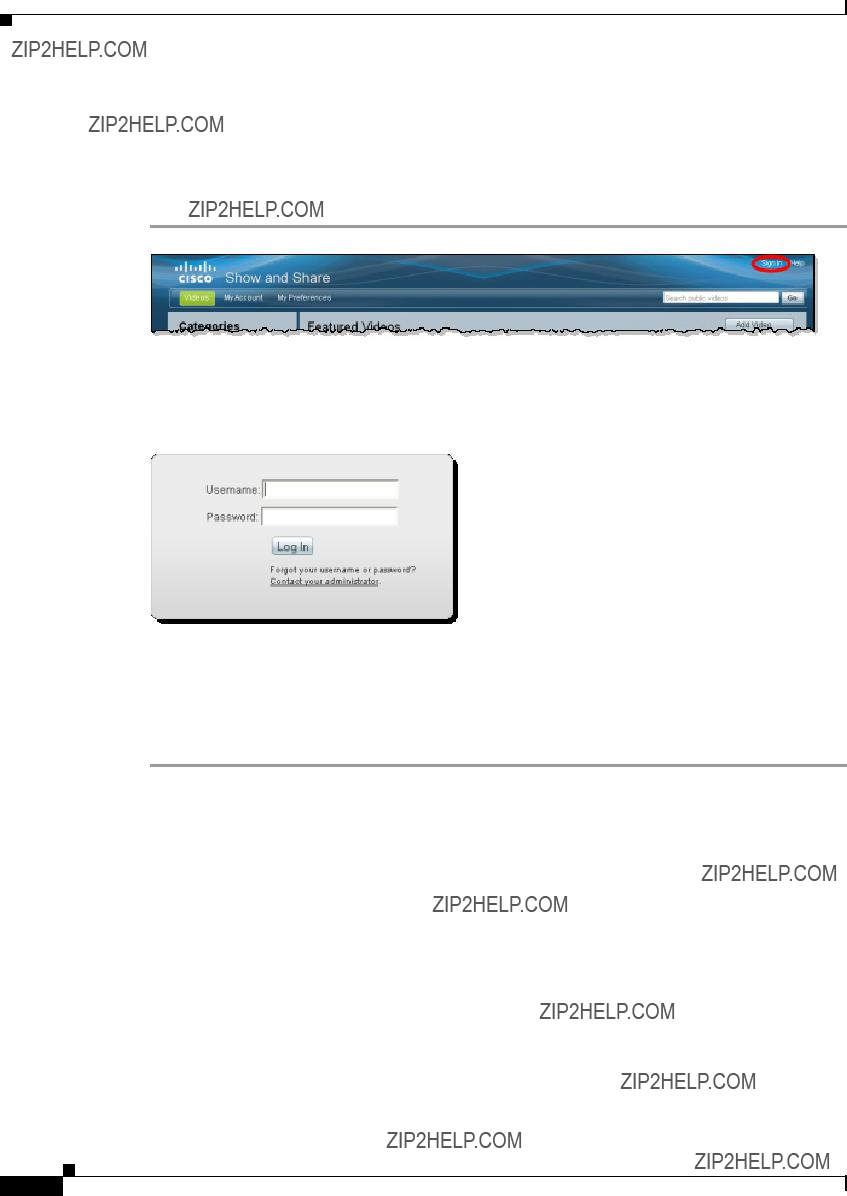
Chapter 1 Start Here
Sign In to Cisco Show and Share
Sign In to Cisco Show and Share
You must be
To
Step 1 Click the Sign In link in the global navigation area at the top of the page.
You will see one of the following
Step 2 Enter your username and password.
Step 3 Click Log In.
You are returned to the Videos page.
Step 4 Stop. You have completed this procedure.
User Guide for Cisco Show and Share 5.3.x

Chapter 1 Start Here
Sign In to Cisco Show and Share
About User Roles and Privileges
The following table describes the user roles that are available in Cisco Show and Share. Users may have more than one role. For example, in many installations video authors are also video publishers and live event users.
Users can also have one or more of the administrator roles listed at the bottom of the table. Administrator functions are described in the Administrator Guide for Cisco Show and Share 5.3.x.
Administrators can enable or disable certain features globally or restrict their access to a subset of users. The logic works like this:
???No one can use what an administrator has hidden from everyone.
???You must log in to use what an administrator has reserved for registered users.
???When you are logged in, you cannot use anything whose access rights exclude you.
To gain access to features that have been restricted to registered users by the site administrator, and to be able to upload, record, and edit videos, you must log in to Cisco Show and Share and have the privileges to perform those actions.
User Guide for Cisco Show and Share 5.3.x
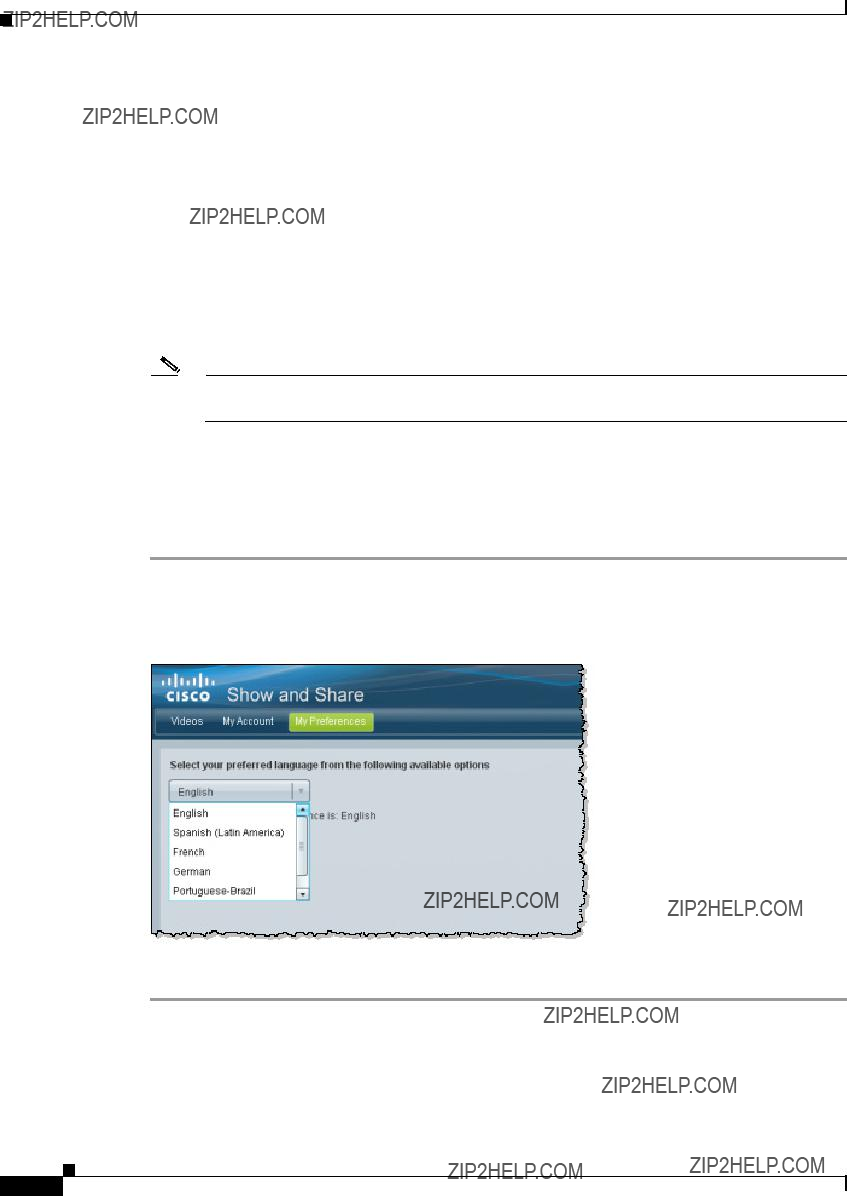
Chapter 1 Start Here
Set Your Personal Preferences
Set Your Personal Preferences
When you first log in to Cisco Show and Share, the interface is presented in a language chosen by your system administrator. You can change the language displayed to one of the following:
???English
???Spanish (Latin America)
???French
???German
???
???Italian
Note The Italian language option is provided as a Beta feature. You may experience some inconsistencies in the interface if you choose this language.
Even though you change the language displayed for your Cisco Show and Share Sessions, it does not change the base language of the system. Features, such as search, will still follow the rules for the base system language.
Procedure
Step 1 Log in to Cisco Show and Share.
Step 2 Click My Preferences in the menu bar.
Step 3 Choose a language from the Select your preferred language list.
Step 4 Click Apply.
User Guide for Cisco Show and Share 5.3.x

C H A P T E R 2
Quick Start
Revised: November 2013
The Cisco Show and Share Quick Start section provides an overview of the Cisco Show and Share interface and features. It is designed to act as a quick reference an to get you acquainted with the most commonly accessed pages. Each section contains links to where you can find more information about that screen.
Note The screens in this section might look slightly different from those in your site. Your site might use a custom logo and background or be in another language.
This section contains the following topics:
???Cisco Show and Share Interface, page
Cisco Show and Share Interface
???The Publish Your Video Page
User Guide for Cisco Show and Share 5.3.x
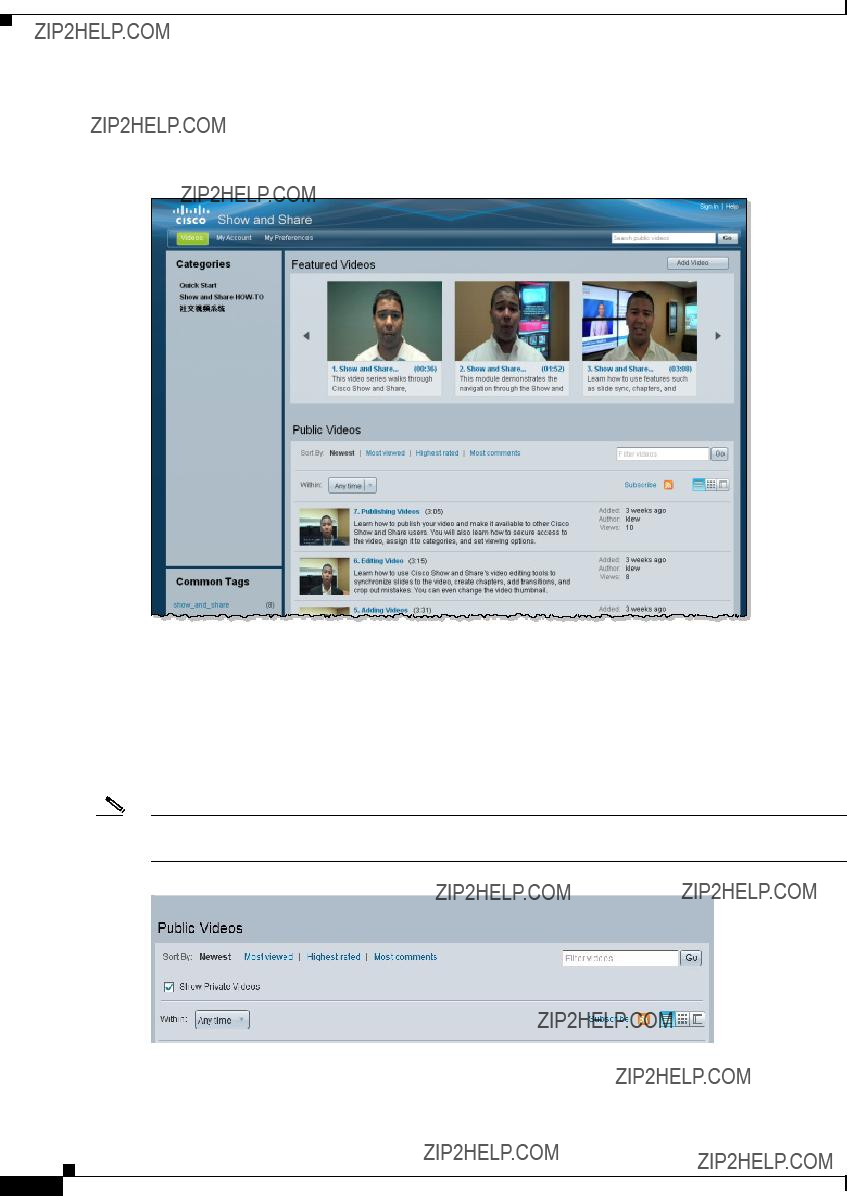
Chapter 2 Quick Start
Cisco Show and Share Interface
The Home Page
The Home page is the starting point of your Cisco Show and Share experience. You can always navigate back to the Home page by clicking Videos in the menu bar.
At the top of the Home page are featured videos. Below the Featured Videos are the Public Videos. These are videos that do not have any viewing restrictions attached to them. By default, the newest videos are shown at the top of the list. You can also sort the list by the most watched, the highest rated, or containing the most comments. When sorted by the number of comments, both general comments and timeline comments count towards the comment total for a video.
Videos with viewing restrictions appear on the Private tab in your My Account page if you have permission to access them. For the ???superuser??? account, private videos also appear on the home page.
Note Beginning in Show and Share Release 5.3.12, you can select the Show Private Videos check box to display private videos on your Home page (in addition to appearing on your My Account > Private tab).
You can filter the public videos by selecting a tag, a category, entering a filter term, or any combination of those methods. You can also change the Public Videos list view. For more information about browsing and searching for videos from the home page, see Browse and Search Videos, page
User Guide for Cisco Show and Share 5.3.x

Chapter 2 Quick Start
Cisco Show and Share Interface
The Video Playback Page
Any time you click a video, the Video Playback page appears. When the page loads, the video begins to play automatically.
For more information about using the features on the Video Playback page, see Play, Comment, Tag, and Share Videos, page
User Guide for Cisco Show and Share 5.3.x
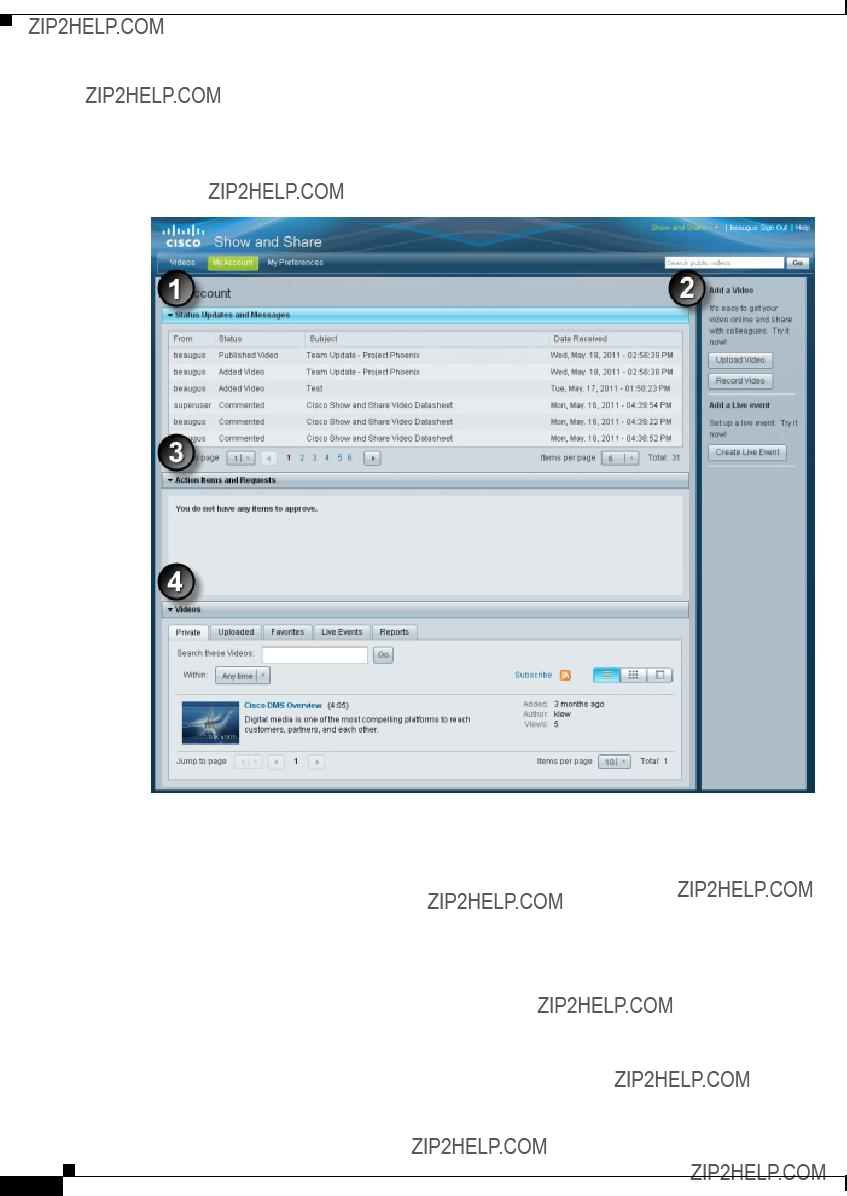
Chapter 2 Quick Start
Cisco Show and Share Interface
The My Account Page
Click My Account in the menu bar to access the My Account page. You must be
For more information about Live Events, see Live Events, page
For more information about uploading videos, see Create, Add, and Manage Videos, page
User Guide for Cisco Show and Share 5.3.x

Chapter 2 Quick Start
Cisco Show and Share Interface
The Upload Video Page
Access the Upload Video page by clicking Add Video > Upload a Video on the Home page or by clicking Upload Video on the My Account page. You must be
For more information about uploading videos, see Create, Add, and Manage Videos, page
For more information about synchronizing slides, see Edit Video, page
User Guide for Cisco Show and Share 5.3.x
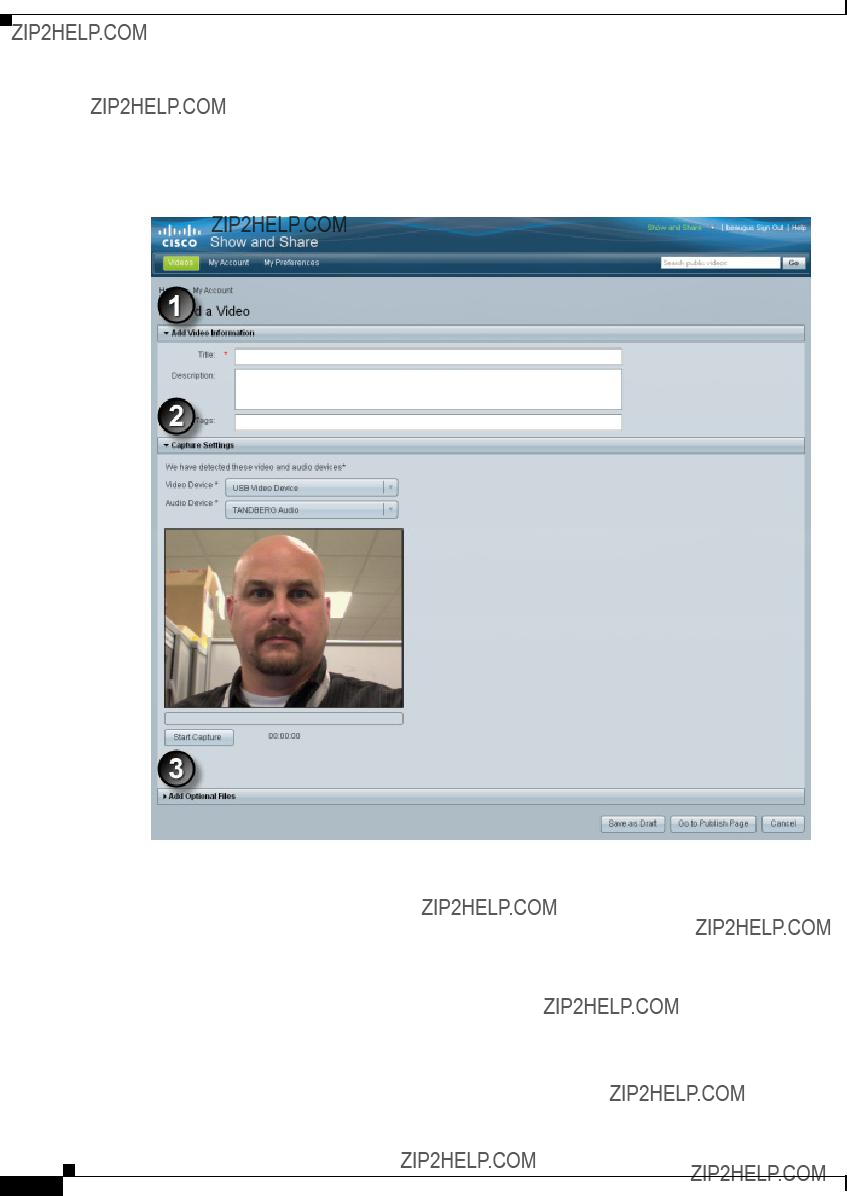
Chapter 2 Quick Start
Cisco Show and Share Interface
The Record a Video Page
Access the Upload Video page by clicking Add Video > Record a Video on the Home page or by clicking Record Video on the My Account page. You must be
For more information about recording videos, see Create, Add, and Manage Videos, page
For more information about synchronizing slides, see Edit Video, page
User Guide for Cisco Show and Share 5.3.x

Chapter 2 Quick Start
Cisco Show and Share Interface
The Publish Your Video Page
You must be
1Video Summary. Contains the video information you entered in the Upload Video or Record Video screen. You can edit this information before publishing
2Page Permissions.You can restrict access to the video, assign it to one or more categories, and disable the following features for the video you are publishing if the features have been enabled globally:
???Commenting on videos
???Commenting anonymously
???Rating videos
???Tagging videos
???Sharing videos
User Guide for Cisco Show and Share 5.3.x
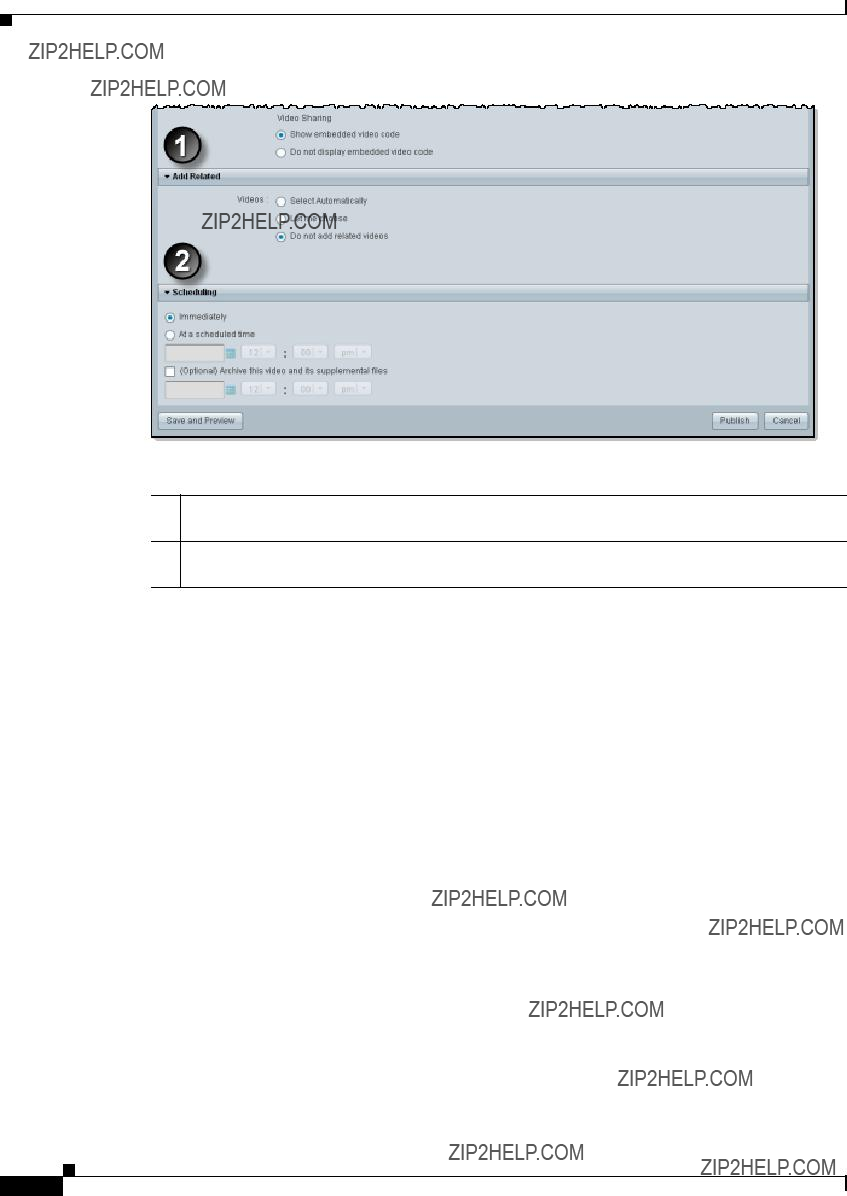
Chapter 2 Quick Start
Cisco Show and Share Interface
1Add Related. You can manually specify related videos or have the system automatically select them based on tags and categories assigned to the videos.
2Scheduling.You can schedule when you want the video to appear in Cisco Show and Share and when you want it removed from public viewing.:
For more information about publishing videos, see Publish Your Video, page
User Guide for Cisco Show and Share 5.3.x

Chapter 2 Quick Start
Basic Navigation
Basic Navigation
This section contains the following topics:
???Keyboard Navigation, page
Screen Elements
The Header
In Cisco Show and Share, the horizontal area at the top of each page is called the header.
The header is useful in several ways.
???Global Navigation, page
Global Navigation
The headers???s top right corner includes a row of links that you can click. These global navigation links help you to sign in or sign out, for example.
Figure
Tip You cannot sign in until you have a Cisco Show and Share user account. However, some basic features might be available even before you sign in. To request a user account, contact the administrator for your Cisco Show and Share site.
Global navigation links behave differently in various situations.
???When you have not yet signed in to your user account, a link invites you to sign in. But while you are signed in, that link changes so that you can sign out when you are finished.
???We show a triangle in the global navigation when you can use a link like a menu and choose among applications. The menu expands when you click this triangle. Choose an option in the menu to switch between applications. (We might then ask you to sign in.) You can use only the applications that you are authorized to use. After you open an application, its name replaces the name of whichever application you closed.
User Guide for Cisco Show and Share 5.3.x

Chapter 2 Quick Start
Basic Navigation
Figure
Tip To learn about Cisco Show and Share Administration features, see User Guide for Cisco Show and Share Administration 5.2.x on Cisco.com.
Basic Search
The header also includes a basic search function. Enter a word or phrase in the field, and then click Go.
Primary Tab Bar
A row of tabs loads under the Show and Share name. We call this the primary tab bar. Click a tab to move between the major areas in Cisco Show and Share that you are authorized to use.
Until you sign in to your Cisco Show and Share account, some features are hidden from you. These include the My Show and Share tab and everything on it.
User Guide for Cisco Show and Share 5.3.x

Chapter 2 Quick Start
Basic Navigation
Drawers
A drawer contains objects and controls that work together in a special way. You can open a drawer or close it at any time, for any reason. While a drawer is closed, you cannot see or work with anything inside it. Later, you might open it again to use it.
Figure
Figure
User Guide for Cisco Show and Share 5.3.x

Chapter 2 Quick Start
Basic Navigation
Secondary Tab Bar
Any drawer might contain tabs that affect only what you see inside that drawer. We call this a secondary tab bar. You must open a drawer before you can use its tabs.
Figure
Note Unless you are a live event manager and the software feature license is installed that activates live event support in Cisco Show and Share, you do not see the My Live Events tab.
User Guide for Cisco Show and Share 5.3.x
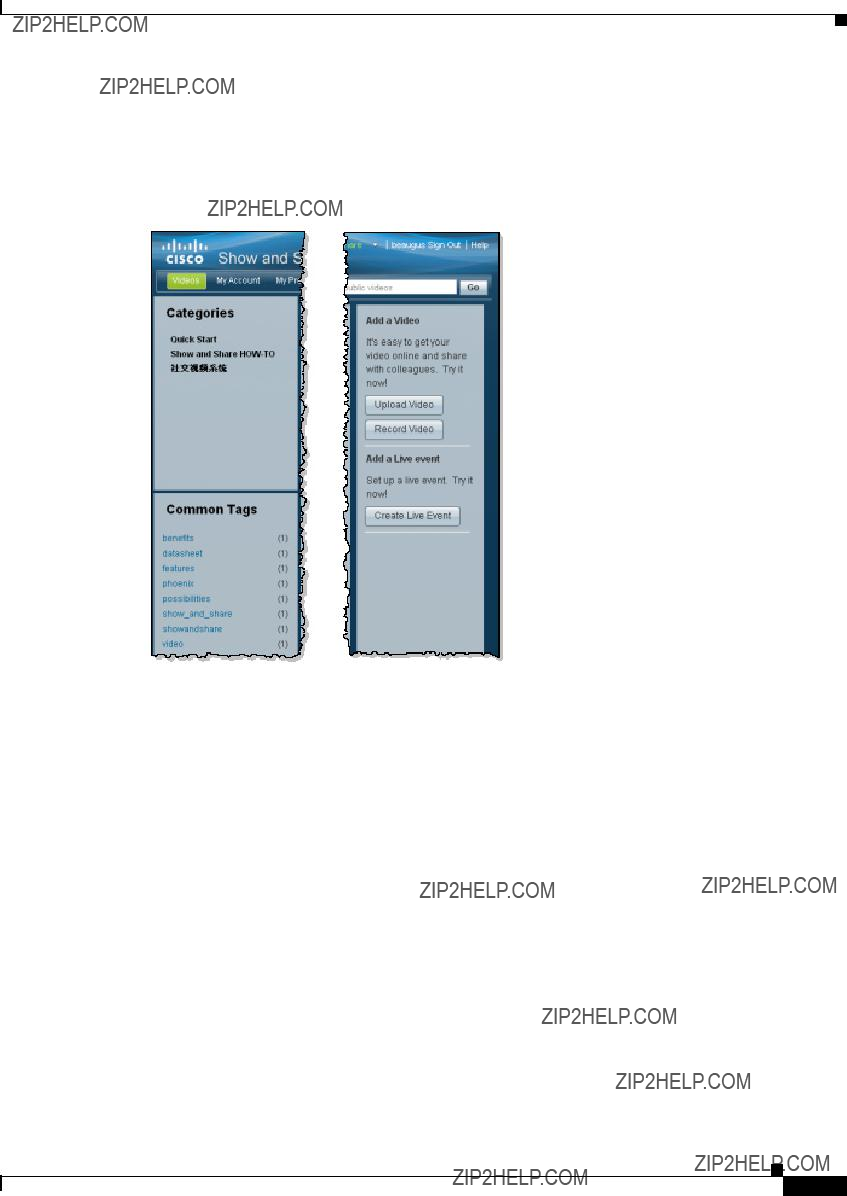
Chapter 2 Quick Start
Basic Navigation
Sidebars
Some pages in Cisco Show and Share include a narrow column on the right or left side. This is called a sidebar. The elements in a sidebar help you to jump quickly to another area.
Figure
User Guide for Cisco Show and Share 5.3.x

Chapter 2 Quick Start
Basic Navigation
Keyboard Navigation
The following pages support keyboard navigation:
???Login
???Home
???My Account
???Upload Video
???Record a Video
???Publish Video
???Video Playback
???Search Results
The following areas do not support keyboard navigation:
???Create Live Event
???Video Editor
???Administration
???Category chooser and Group chooser (available from the Publish Video page) See the following sections for more information about using keyboard navigation:
???General Keyboard Navigation, page
???Navigate the Featured Videos, page
???Navigate the Public Videos, page
???Control Video Playback, page
General Keyboard Navigation
Table
User Guide for Cisco Show and Share 5.3.x
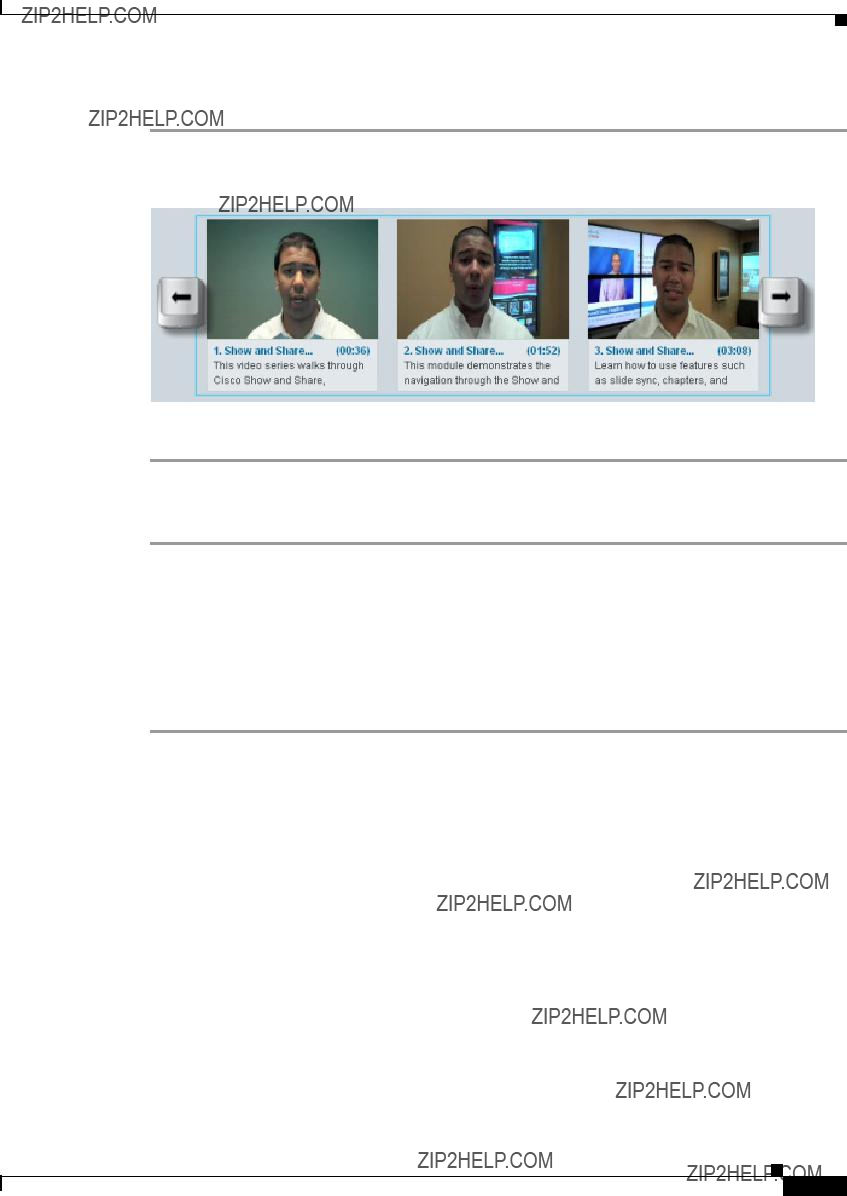
Chapter 2 Quick Start
Basic Navigation
Navigate the Featured Videos
Step 1 Press TAB until the featured videos are highlighted.
Step 2 Use the Left and Right arrow keys to select a featured video.
Step 3 Press the Spacebar to launch the video.
Navigate the Public Videos
Step 1 Press TAB until the first public video in the list is highlighted.
Step 2 To navigate the list:
???Continue to press TAB to highlight the next video in line.
???Press TAB after the last video to highlight the page controls at the bottom of the list. Use the Up and Down arrow keys on the Jump to Page control to change pages or use the Spacebar on the page forward/back buttons and the page numbers to change pages.
Step 3 Press the Spacebar on a highlighted video to launch the video.
User Guide for Cisco Show and Share 5.3.x

Chapter 2 Quick Start
Basic Navigation
Control Video Playback
Step 1 Press TAB to highlight the video.
Step 2 Use the following to control video playback while the video itself is highlighted:
Step 3 Press TAB again to move the focus to the player controls. Use TAB to move through the controls and Spacebar to activate the control.
User Guide for Cisco Show and Share 5.3.x

C H A P T E R 3
Browse and Search Videos
Revised: February 4, 2013
This section describes ways that you can browse through or search for public videos from the home page. It contains the following topics:
???Browse the Featured Videos, page
???Browse The Public Videos, page
???Navigate Your Filtered Results, page
???Search for Videos, page
???Subscribe to an RSS Feed, page
User Guide for Cisco Show and Share 5.3.x

Chapter 3 Browse and Search Videos
Browse the Featured Videos
Browse the Featured Videos
Featured videos appear at the top of the home page. Videos are designated as ???featured??? by the Cisco Show and Share administrators. Refer to your organization???s policies and procedures for information about how videos are determined to be featured videos.
Procedure
Step 1 If not on the home page, click Videos on the primary tab bar.
If featured videos exist, you will see their thumbnails at the top of the page.
Step 2 Click the left and right arrows to browse through featured videos, as needed.
Step 3 (Optional) Click a video to open its video player.
User Guide for Cisco Show and Share 5.3.x

Chapter 3 Browse and Search Videos
Browse The Public Videos
Browse The Public Videos
When you first access the Cisco Show and Share home page, the Public Videos list displays the newest videos at the top of the list. You can change the list view and sort and filter the list to make finding videos easier.
???Change the Public Videos List View, page
???Sort the Public Videos, page
???Filter the Public Videos, page
Change the Public Videos List View
The list view buttons appear above the video list. The list view only remains for the session you are currently in. If you sign out or exit, the view reverts to the default list view.
Click a button to change the list view. Table
Button View
(List View)
(Grid View)
(Table View)
User Guide for Cisco Show and Share 5.3.x

Chapter 3 Browse and Search Videos
Browse The Public Videos
Sort the Public Videos
You can sort the public video list by newness, most views, ratings, or number of comments.
To sort the list, click one of the following options in the Sort By list:
???
???Most
???Highest
???Most
Under certain circumstances, the sort by most viewed list may appear to be out of order. Videos with fewer views can appear higher in the list than a video with more views. This happens when a video author creates a draft of a public video (for example, to edit some of the video information). Views of the draft video count towards the overall video views, but are not reflected in the number of views shown in the Views count of the public video. This situation is corrected when the video author
User Guide for Cisco Show and Share 5.3.x
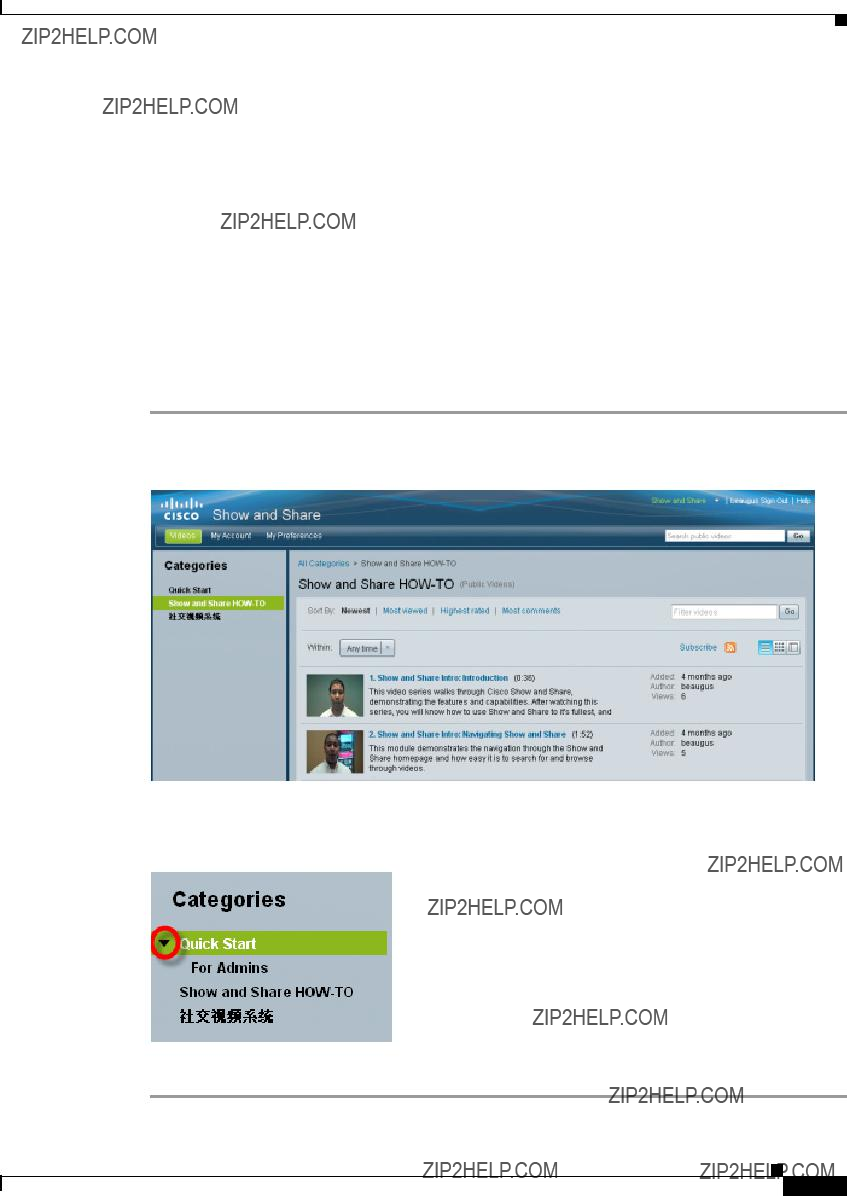
Chapter 3 Browse and Search Videos
Browse The Public Videos
Filter the Public Videos
There are several methods for filtering the Public Videos list. You can use any combination of the following methods to filter the video list. You can also combine these filters with the changed view and sorting to help you quickly find the videos you are looking for.
???Filter by Category, page
???Filter by Keyword, page
Filter by Category
You can filter the Public Videos list to show only those videos belonging to a selected category.
Step 1 Click a category in the Categories area.
The Home page displays the filtered list of public videos.
If you have nested categories, click the triangle next to the category name to reveal the
Step 2 To remove the category filter, click Categories.
User Guide for Cisco Show and Share 5.3.x

Chapter 3 Browse and Search Videos
Browse The Public Videos
Filter by Tag
You can filter the Public Videos list to show only those videos that have the selected tag.
Step 1 Click a category in the Common Tags area.
The Public Videos list displays only those videos with the selected tag.
Step 2 To remove the tag filter, click the X to the right of the selected tag.
User Guide for Cisco Show and Share 5.3.x

Chapter 3 Browse and Search Videos
Browse The Public Videos
Filter by Date
You can filter the list to show only those videos that were published within the last day, week, month, or 90 days.
Step 1 Choose a time frame from the Within list.
The Public Videos list shows only those videos that were published within the selected time frame.
Step 2 To remove the date filter, choose Any time form the Within list.
User Guide for Cisco Show and Share 5.3.x
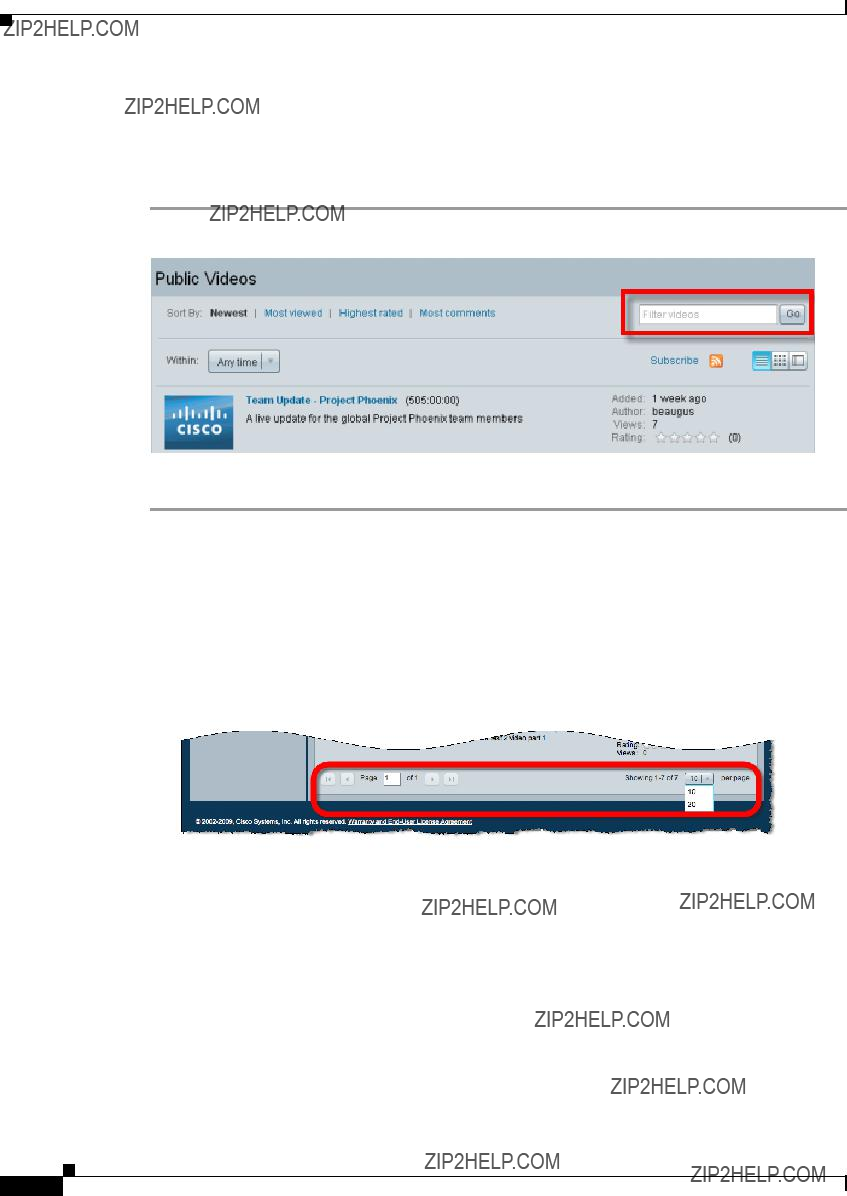
Chapter 3 Browse and Search Videos
Navigate Your Filtered Results
Filter by Keyword
You can filter the list to show only those videos that match a word or phrase of your choosing. Video titles, descriptions, tags, and user information are included in searches. If the Pulse keyword and speaker identification feature is enabled, speaker names and keywords are also part of the filter.
Step 1 Enter the word or phrase in the Filter videos field and click Go.
Step 2 To remove the keyword filtering, clear the Filter videos field and click Go.
Navigate Your Filtered Results
Pagination controls include the buttons and fields clustered under a table, by which you:
???Set how many rows a table should show per page before it starts to span multiple pages.
???Move from one page to another in a table that spans multiple pages.
???Cause the table to show refreshed data.
Play a Video
After you have found the video you were looking for, click the video title or thumbnail to play the video. For more information about playing and interacting with videos, see Play, Comment, Tag, and Share Videos, page
User Guide for Cisco Show and Share 5.3.x

Chapter 3 Browse and Search Videos
Search for Videos
Search for Videos
The following applies to basic and advanced searches:
???Search ignores common words, such as ???the??? (or the equivalent in the system base language).
???Search ignores special characters, such as punctuation. If you have titles with a special character
???If you search for more than one term, it treats the search as an ???and??? and does not split the terms across fields that are being searched. For example, if you have a video submitted by a user with the user ID of ???user1??? and tagged with the tag ???tag???, searching for ???user1 tag??? may not produce the video in the results. This is because the search looks for both user1 and tag in the tags field and user1 and tag in the user ID field. However, you can filter the display on the home page with the desired tag and then search for the user ID.
This section contains the following topics:
User Guide for Cisco Show and Share 5.3.x

Chapter 3 Browse and Search Videos
Search for Videos
Basic Search
Procedure
Step 1 Enter a search term and then click Go.
The Search Results page appears.
Step 2 You can further refine the search by filtering the results by tag, author, or date published. Clicking one or more of the filter entries in the Filter Results by area.
User Guide for Cisco Show and Share 5.3.x

Chapter 3 Browse and Search Videos
Search for Videos
Advanced Search
Step 1 Click Go. You do not need to enter a search term.
The Search Results page appears.
Step 2 Click Advanced Search.
The Advanced Search form opens.
Step 3 Enter search terms in the search term fields. You can enter terms in more than one field. If you do, they are treated as if joined by ???and???. For example, you can search for an exact phrase and at least one of another list of words:
???All of these
???This exact
???At least one of these
???Without these
User Guide for Cisco Show and Share 5.3.x
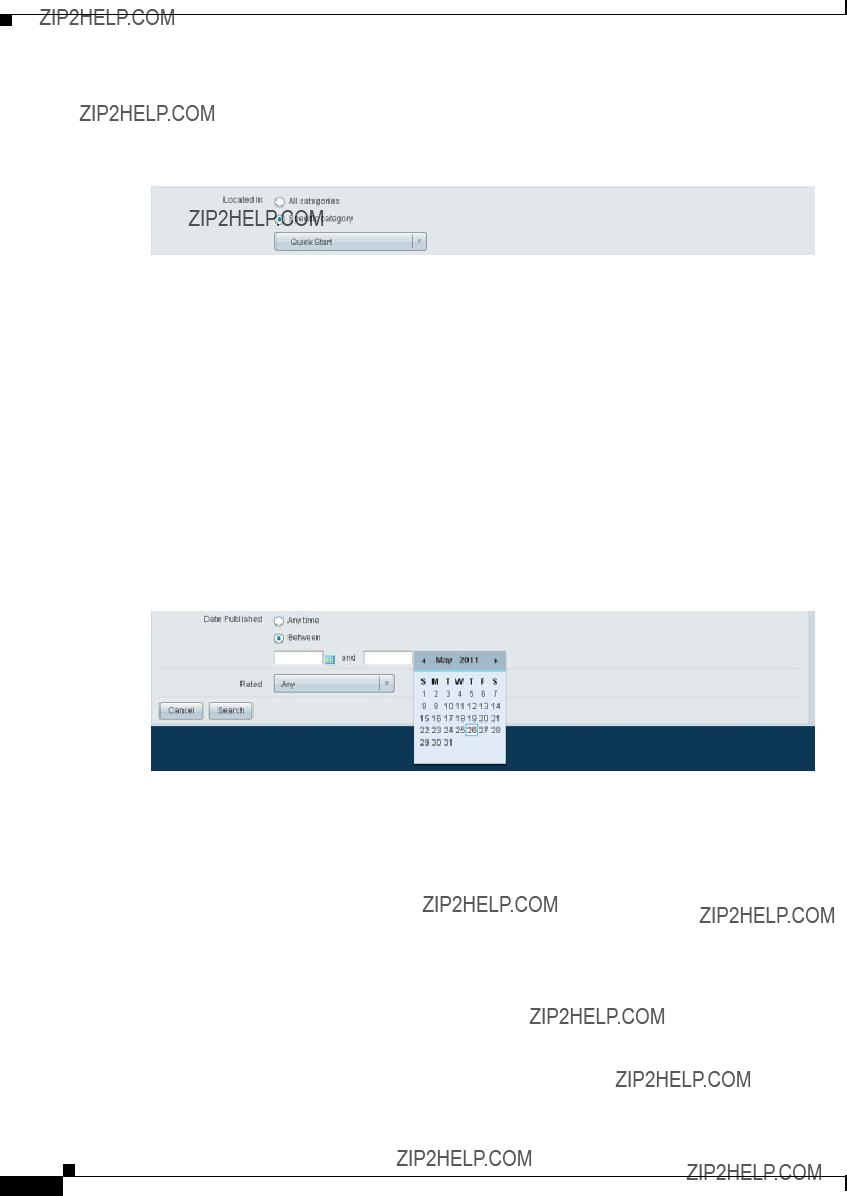
Chapter 3 Browse and Search Videos
Search for Videos
Step 4 (Optional) Specify a category the video must be in:
a.Click Specific category.
A list of categories appears.
b. Select a category from the list.
Step 5 (Optional) Narrow down the fields searched by selecting one of the following options in the That occur field:
???
???Page title
???Description
???Tags
Step 6 (Optional) Enter a user name in the Published by field to restrict the results to videos published by a specific author.
Step 7 (Optional) Restrict the search to videos published in a specific date range:
a.Click Between in the Date Published field Date entry fields appear.
b.Type a date or select one from the date chooser. Leave a date field blank to indicate that there should not be a start or a finish date.
Step 8 (Optional) Restrict the search to videos with a specific rating or better by choosing a rating from the
Rated list.
Step 9 Click Search.
The Search Results page appears.
User Guide for Cisco Show and Share 5.3.x

Chapter 3 Browse and Search Videos
Subscribe to an RSS Feed
Step 10 You can further refine the search by filtering the results by tag, author, or date published. Clicking one or more of the filter entries in the Filter Results by area.
Search Tip
Save your search by bookmarking the URL in the Search Results page. You can then repeat your search or share your searches with others.
Subscribe to an RSS Feed
Click Subscribe to specify the video content that you want delivered directly. Videos appear in your RSS reader if you have permission to access them. Table
User Guide for Cisco Show and Share 5.3.x

Chapter 3 Browse and Search Videos
Subscribe to an RSS Feed
User Guide for Cisco Show and Share 5.3.x

C H A P T E R 4
Play, Comment, Tag, and Share Videos
Revised: September 2013
No matter where you are in the Cisco Show and Share interface, whenever you click on a video thumbnail or title, you are taken to the Video Playback page. The video playback page does more than just let you watch videos, it lets you interact with them by leaving comments, rating them, reading transcripts, watching synchronized slides, and downloading supplemental files. If your installation also has a Cisco MXE integrated with it and the Pulse feature set enabled, you can also browse the speakers and keywords within the video.
Topics in this section describe how to play and respond to videos.
Concepts
To learn more about the video playback page, see the following topics:
???The Video Playback Page, page
???The Video Information Tabs, page
About Video Playback
Videos are played back using one of two methods: streaming or progressive download.
With streaming playback, the video starts to play immediately after accessing the page. You can use the timeline and play head to jump to any point in the video.
With progressive download, the video begins playing after a portion of the video has been downloaded. You might experience a slight delay before the video begins. The video continues to download as you are watching it. You can skip to any point in the video up to the point where it has downloaded. Once the video has fully downloaded, you can move forward and backwards to any point.
User Guide for Cisco Show and Share 5.3.x
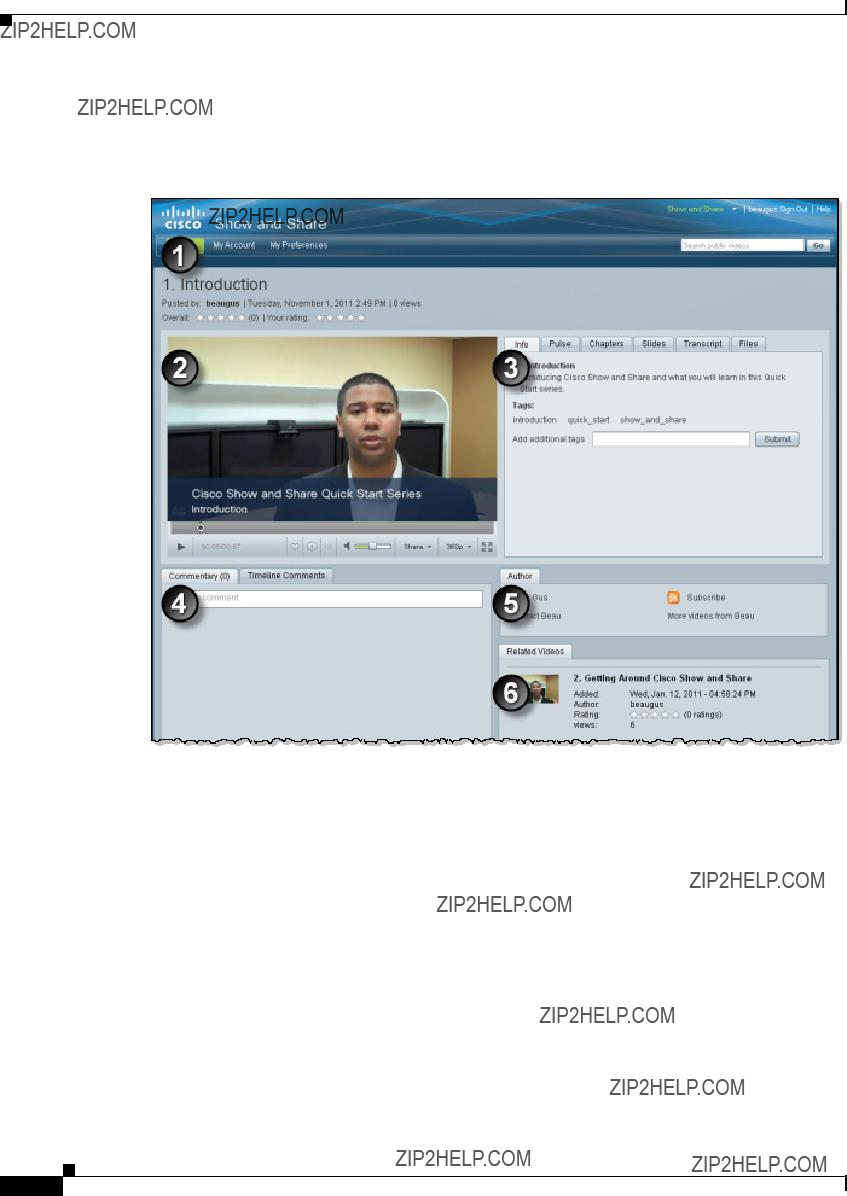
Chapter 4 Play, Comment, Tag, and Share Videos
Concepts
The Video Playback Page
Any time you click a video, the Video Playback page appears. When the page loads, the video begins to play automatically.
User Guide for Cisco Show and Share 5.3.x
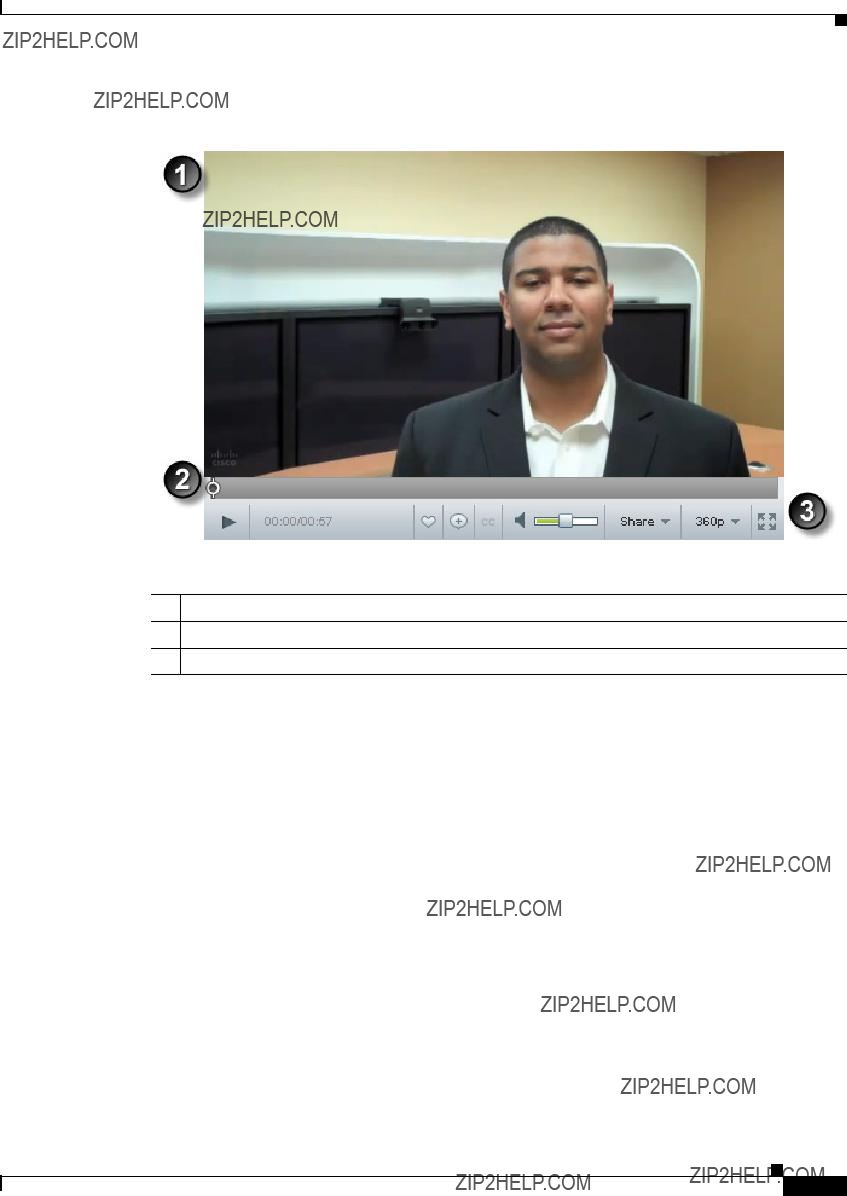
Chapter 4 Play, Comment, Tag, and Share Videos
Concepts
The Video Player
1The video area.
2The timeline and play head.
3The player controls. See Table
User Guide for Cisco Show and Share 5.3.x

Chapter 4 Play, Comment, Tag, and Share Videos
Concepts
User Guide for Cisco Show and Share 5.3.x

Chapter 4 Play, Comment, Tag, and Share Videos
Concepts
The Video Information Tabs
The video information tabs contain additional information about the video. Tabs only appear for the features that are associated with the video. For example, if a video has a transcript, the Transcript tab appears. If it does not have a transcript, the Transcript tab is hidden.
Below the video player are two additional tabs:
Note Live events have tabs for asking questions of the speaker and responding to polls instead of the comments tabs.
User Guide for Cisco Show and Share 5.3.x

Chapter 4 Play, Comment, Tag, and Share Videos
Procedures
Procedures
???Pause and Play Videos, page
???Play Videos Full Screen, page
???Add a Video to Your Favorites List, page
???Change the Video Resolution, page
???Comment on Videos, page
???Add Tags to Videos, page
???Play Embedded Videos, page
???View Pulse Information, page
???Jump to a Chapter, page
???Read a Transcript, page
Pause and Play Videos
When you first access a video, it begins to play by default. You can pause and restart the video at any time.
Procedure
Step 1 Click the pause button to pause the video.
Step 2 To resume playback, click the play button.
Step 3 To skip to a specific point in the video, drag the play head to the point in the timeline.
Note See Control Video Playback, page
User Guide for Cisco Show and Share 5.3.x
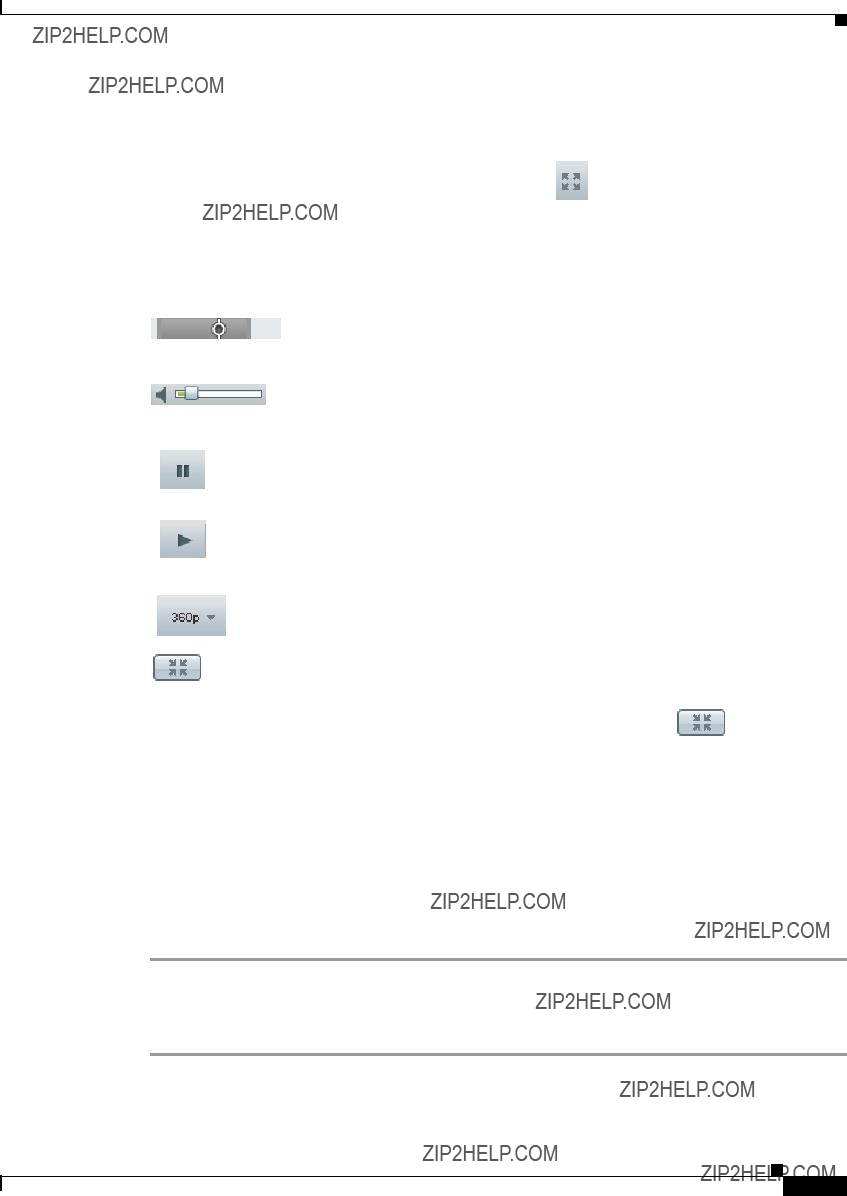
Chapter 4 Play, Comment, Tag, and Share Videos
Procedures
Play Videos Full Screen
Procedure
Add a Video to Your Favorites List
You can add a video to your Favorites list. Your Favorites list appears as a tab in the Videos drawer on the My Account page. You must be logged in to add a video to your Favorites list.
Procedure
Step 1 On the video playback screen, click the Favorites button.
The video now appears in your My Favorites list on the My Account page.
Step 2 To view your favorite videos, go to My Account > Videos > Favorites.
User Guide for Cisco Show and Share 5.3.x

Chapter 4 Play, Comment, Tag, and Share Videos
Procedures
Change the Video Resolution
You can change the resolution of the video while viewing it. This option is only available if your Cisco Show and Share uses a Cisco MXE to transcode the uploaded videos and your system administrator has enabled multiple resolutions.
You may want to select lower resolutions when playing videos back on slower network connections or if the playback pauses often.
The following resolutions may be available: 360p, 480p, and 720p. Depending on the resolution of the original video, and the system setting, not all resolutions may be available.
Procedure
Step 1 On the video player, click the resolution selector button. This button displays the current resolution of the video.
Step 2 Select the resolution you want to view.
Comment on Videos
You can comment on videos in two different ways:
???General comments that apply to the whole video. These comments appear below the video on the video playback page. See Adding a General Comment, page
???Timeline comment that apply to a specific point in the video. These comments appear in the Timeline Comments tab below the video. Additionally, vertical bar in the video timeline indicates where timeline comments have been entered. See Adding a Timeline Comment, page
Both types of comments count towards the total number of comments for a video.
Commenting on videos may not be available if the system administrator has turned off this feature at the system level or if the person who uploaded the video turned off the feature for the video.
If you
You can also flag comments as inappropriate. See Flag a Comment as Inappropriate, page
Adding a General Comment
Step 1 Click in the comment box in the Commentary tab below the video. If comments have been added by other users, the comment box appears above the existing comments.
Step 2 Type your comment.
Step 3 Click Add Comment.
Your comment appears at the top of the list. If you are
User Guide for Cisco Show and Share 5.3.x

Chapter 4 Play, Comment, Tag, and Share Videos
Procedures
Adding a Timeline Comment
Flag a Comment as Inappropriate
Step 1 Click the Commentary or Timeline Comments tab.
Step 2 Click Report Abuse next to the inappropriate comment.
The system administrators are notified that the comment has been flagged.
User Guide for Cisco Show and Share 5.3.x
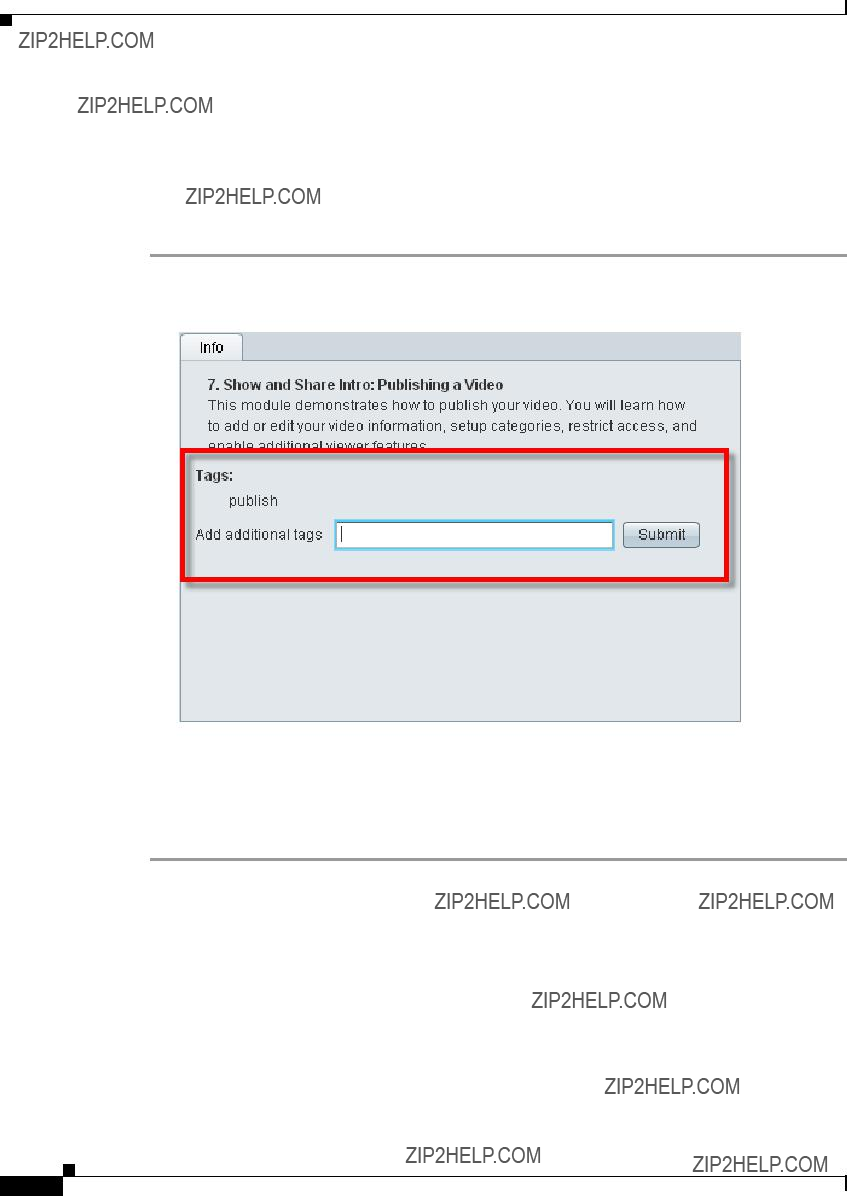
Chapter 4 Play, Comment, Tag, and Share Videos
Procedures
Add Tags to Videos
You can add tags to your own or to other people???s videos from the Video Playback page. You cannot add tags to live events. This option may not be available if the system administrator has turned off this feature at the system level or if the person who uploaded the video turned off the feature for the video.
Procedure
Step 1 On the video playback screen, click the Info tab to open it.
The video tags appear at the bottom of the tab.
Step 2 Click in the Add additional tags box.
Step 3 Type in your tags. Each tag is separated by a space. If you have tags that contain more than one word, combine the words with a character such as an underscore (_) or a dash
Step 4 Click Submit.
User Guide for Cisco Show and Share 5.3.x

Chapter 4 Play, Comment, Tag, and Share Videos
Procedures
Rate Videos
You can rate your own and other people???s videos. Ratings range from a low of zero stars to a high of five stars.
Because ratings increment by
Note This option may not be available if the system administrator has turned off this feature at the system level or if the person who uploaded the video turned off the feature for the video.
Step 1 Navigate to the Video Player page.
The ratings appear above the video. You will see an Overall rating, which is the average of all the ratings given to the video, and your own rating.
Step 2 Click the stars below the video. You can click in
Step 3 To change your rating after clicking on a star, you need to leave and return to the player page for the video.
Share Videos
You can share videos by sending a link in
???Copy the Video Link, page
???Embed the Video in a Web Page, page
???Embed the Extended Video Player in a Web Page, page
???Send the Video Link in
User Guide for Cisco Show and Share 5.3.x

Chapter 4 Play, Comment, Tag, and Share Videos
Procedures
Copy the Video Link
You can copy the video URL to share in documents, web pages, or chat sessions.
Procedure
Step 1 On the video playback screen, click the Share button below the video.
Step 2 Click Copy Link.
A dialog box displays the URL.
Step 3 Highlight and copy the URL.
User Guide for Cisco Show and Share 5.3.x

Chapter 4 Play, Comment, Tag, and Share Videos
Procedures
Embed the Video in a Web Page
You can embed your video in a web page or other type of document that accepts HTML code, such as a blog, a wiki, or a simple HTML page.
There are two types of embed code available: Javascript and Flash. The Flash embed code is only available for videos in one of the Flash formats. For videos in a Windows format, only the Javascript code is available.
Use the Javascript embed code unless the page you are embedding the video into does not support Javascript. Some blogging and wiki products do not allow Javascript to run on their pages. Using the Javascript embed code allows you to track video views for videos embedded in HTML pages. See About the Video View Report, page
The Flash embed code does not allow you to track video views. Use the Flash embed code if the page you are embedding the video into does not support Javascript or if tracking the number of video view is not important.
Procedure
Step 1 On the video playback screen, click the Share button below the video.
Step 2 Click Copy Embed Code.
A dialog box opens with HTML code in it. By default, the Javascript embed code is automatically copied to the clipboard.
Step 3 To use the Flash embed code instead, click Flash.
The Flash embed code is automatically copied to the clipboard.
Step 4 Click OK to close the dialog box.
Step 5 Paste the code in the source of your web document where you want the video to appear.
If you are using a WYSIWYG HTML editor, you must switch to the HTML source view before pasting the code.
To modify the embed code, see: Modifying the Embed Code, page
User Guide for Cisco Show and Share 5.3.x

Chapter 4 Play, Comment, Tag, and Share Videos
Procedures
Modifying the Embed Code
You can modify the size of the embedded video and whether or not the video automatically plays when the web page loads. When planning your web page, note that the player controls add another 50 pixels to the height of your video.
Javascript Embed Code
To modify the width of the embedded video, change the value ???480??? in the embed code, shown in the example below. The height of the video is automatically adjusted to maintain the aspect ratio.
<script type="text/javascript" src="https://video.example.com/vportal/scripts/videoplayer/DmsEmbedLib.js"></script><scrip
To control the automatic playback of the video when the web page loads, change the value ???false??? (shown in bold text, below) to one of the following values:
???
???
<script type="text/javascript" src="https://video.example.com/vportal/scripts/videoplayer/DmsEmbedLib.js"></script><scrip
Flash Embed Code
To modify the width of the embedded video, change the value "480" in the embed code, shown in the example below. To maintain aspect ratio, add a value for height. Ensure that the height and width values match in object classid and embed src.
<object
<embed
You can disable full screen view by changing ???true??? to ???false??? in the following line of the Flash embed code:
<param name="allowFullScreen" value="true" />
Embed the Extended Video Player in a Web Page
Beginning in Show and Share Release 5.3.12 you can create an extended embedded video player that allows users to view Pulse keywords, video titles, and timeline comments when viewing the video. By using the extended player, users can navigate directly to specific words, comments, or speakers.
User Guide for Cisco Show and Share 5.3.x

Chapter 4 Play, Comment, Tag, and Share Videos
Procedures
Guidelines and Limitations
???To enable the extended video player, the video publisher must select Share Embed Code when publishing the video. This will enable the Share button when the published video is viewed, and allow editing of the embed code.
???Any viewer of the published video can edit the embed code to enable the extended video player.
???Any action that refreshes the video such as resolution change or maximize to minimize, will revert the extended video player to the simple video player.
???These features are not available:
???Info tab > Add Tag option
???Add to favorites
???We do not recommend clicking or using the Settings button.
???The edited HTML file should be hosted on a Web server.
Procedure
Step 1 On the video playback screen, click the Share button below the video.
Step 2 Click Copy Embed Code.
A dialog box opens with the HTML code. By default, the Javascript embed code is automatically copied to the clipboard.
Step 3 Click OK to close the dialog box.
Step 4 Paste the Javascript embedded code in a text editor.
Step 5 Remove the content of the <div> tag.
Step 6 Remove the tags named <div> and </div>
Step 7 Replace the getSimplePlayer text with getExtendedPlayer.
Step 8 Save the file as an HTML file and deploy the file on a web server. Or, copy and paste the code in the source of your web document where you want the video to appear.
User Guide for Cisco Show and Share 5.3.x
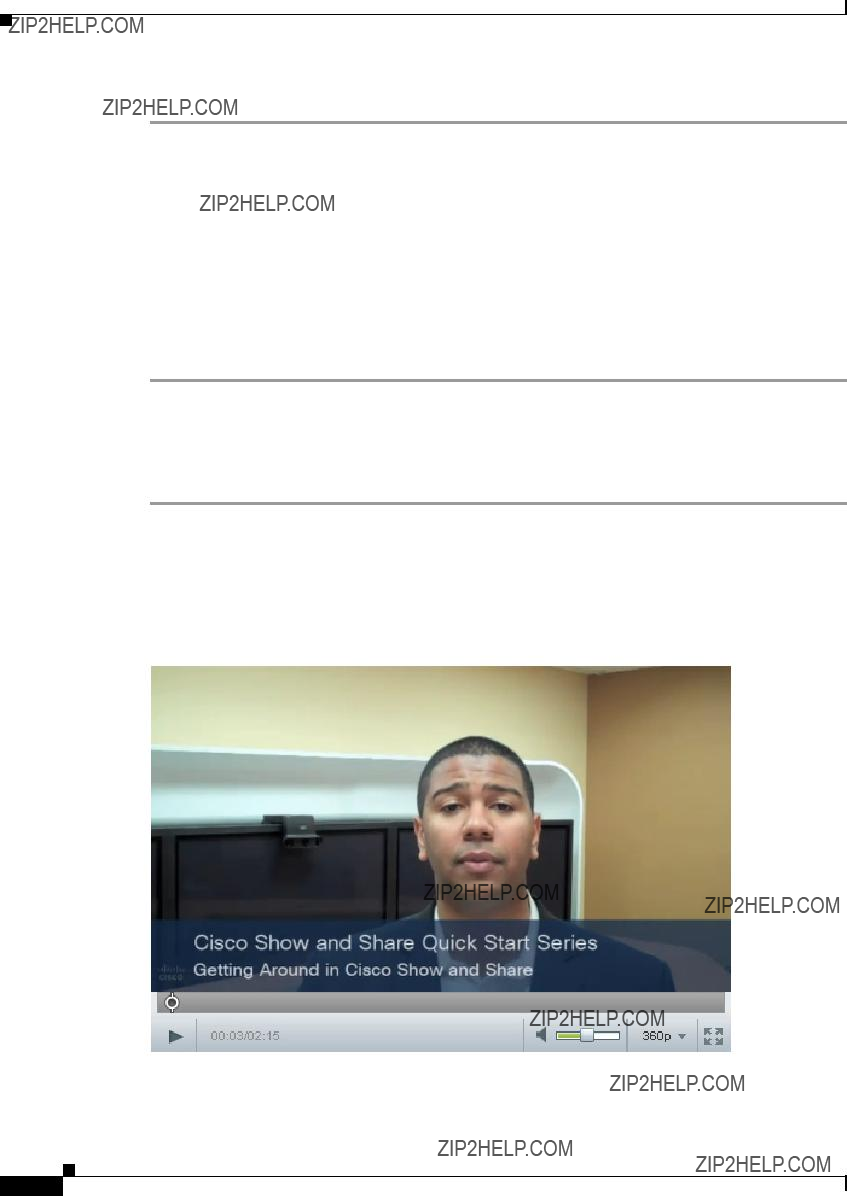
Chapter 4 Play, Comment, Tag, and Share Videos
Procedures
Step 9 Access the web server and click the file to load the video.
Send the Video Link in
You can quickly send a link to the video in an
Prerequisites
???You must have an
???Your
Procedure
Step 1 On the video playback screen, click the Share button below the video.
Step 2 Click Send Email.
An
Step 3 Add your message and send the
Play Embedded Videos
When you watch a Cisco Show and Share video that is embedded in a web site, only a few of the player controls are available to you: play/pause, the timeline, volume, and full screen.
User Guide for Cisco Show and Share 5.3.x

Chapter 4 Play, Comment, Tag, and Share Videos
Procedures
If you are viewing and embedded video that has restrictions, you will be prompted to log in to watch the video. Simply enter your Cisco Show and Share login information and click Log In to watch the video.
Embedded videos do not include any information or resources that are available on the tabs of the video player page. For example, synchronized slides, Pulse keyword and speaker information, chapters, transcripts, and downloadable files are not available. You also cannot submit general comments or timeline comments for an embedded video.
Beginning in Show and Share Release 5.3.12, when you embed a video with the extended video player, some of the original information and resources are available for viewers. See Embed the Extended Video Player in a Web Page, page
See Troubleshooting, page
View Pulse Information
The Pulse tab contains speaker and keyword information extracted from your video. You can use this information to navigate to specific points in the video. Additionally, this information is used when searching and filtering videos.
This section contains the following topics:
???Guidelines and Limitations, page
???About Pulse Keyword Identification, page
???About Pulse Speaker Identification, page
???Navigate the Video Using the Speakers List, page
???Navigate the Video Using the Keywords List, page
???
Guidelines and Limitations
???The Pulse keyword and speaker identification features are only available if your system has a Cisco MXE integrated with it and your system administrator has enabled the Pulse features.
User Guide for Cisco Show and Share 5.3.x

Chapter 4 Play, Comment, Tag, and Share Videos
Procedures
???Videos that were uploaded or recorded in previous versions of Cisco Show and Share, or that were uploaded before the Pulse features were enabled, will not contain the Pulse information. You must
About Pulse Keyword Identification
The Pulse engine can identify specific keywords spoken within videos. It does not identify all words in a video. Instead, your system administrator provides and maintains a list of keywords on the Cisco MXE. The Pulse engine scans the video for those keywords and places markers in the video timeline where they appear. When you select a keyword from the list, all instances of that keyword appear as markers in the timeline. You can jump to a specific marker or navigate forward and backwards through them.
The black triangle marks in the video timeline, below, mark each instance of the keyword ???videos??? in the video.
Additionally, these keywords are included when filtering video lists or searching for videos with keywords.
The Pulse keyword identification feature only identifies English keywords. Additionally, the accuracy of keyword identification depends upon the quality of the recorded audio and whether or not there is a lot of background noise in the audio track.
User Guide for Cisco Show and Share 5.3.x

Chapter 4 Play, Comment, Tag, and Share Videos
Procedures
About Pulse Speaker Identification
The Pulse engine can identify different speakers within videos. It does this by identifying unique voiceprints.
Speaker identification is a learned process. At first, voiceprints are assigned a generic speaker tag, such as Speaker 1. Authors can then use the Cisco Show and Share editing tools to associate voiceprints with specific speakers. The speaker names are taken from the Cisco Show and Share registered users list.
Authors cannot assign names outside of the user pool.
Once a voiceprint has been associated with a specific user, subsequent videos uploaded with that voiceprint automatically show the speaker name.
The colored areas in the video timeline, below, mark each instance of a speaker in the video. This video has a single
The accuracy of the Pulse speaker identification depends upon the quality of the recorded audio and whether or not there is a lot of background noise in the audio track. Sometimes a single speaker may show up as named and as a generic speaker in the same video because of background noise or changes in recording quality. The more times a speaker is identified by a video author, the more accurate the system becomes.
See Label Unidentified Speakers, page
User Guide for Cisco Show and Share 5.3.x
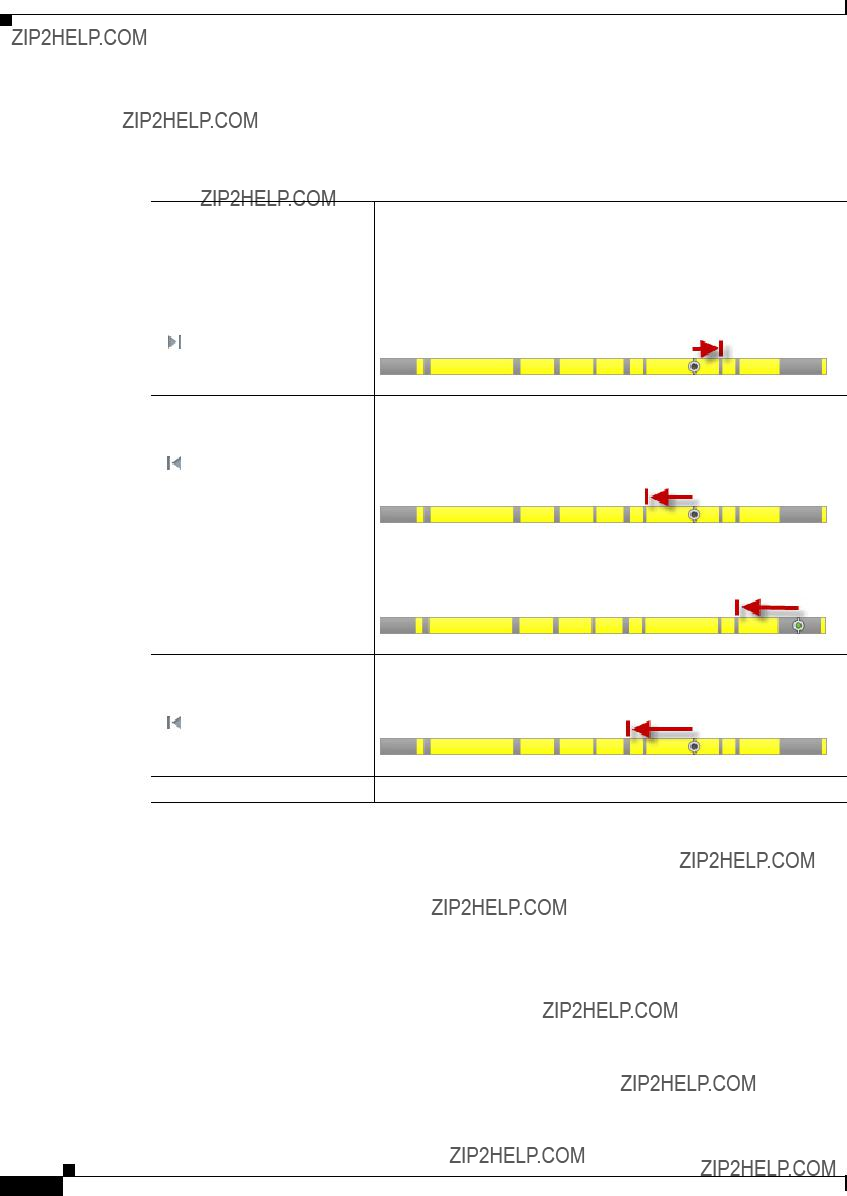
Chapter 4 Play, Comment, Tag, and Share Videos
Procedures
Navigate the Video Using the Speakers List
To navigate the video using the speaker list, do one or more of the following:
Table
???The beginning of the previous speaker block if the play head is currently NOT in a block of the selected speaker.
User Guide for Cisco Show and Share 5.3.x

Chapter 4 Play, Comment, Tag, and Share Videos
Procedures
Navigate the Video Using the Keywords List
To navigate the video using the keyword list, you must first click a keyword to display the instances of that work in the timeline. Then you can do one of the following:
Table
Click the back button next to a Jump to the previous occurrence of that keyword. keyword
Navigate the Video Using Both Speakers and Keywords
You further filter the keyword list to keywords spoken by a particular person in the video.
Step 1 Click a speaker name in the Speakers list.
Step 2 Click a keyword in the Keywords list.
The timeline shows only the selected speaker and the selected keywords spoken by that speaker.
You can use the forward and back buttons to navigate among the filtered results.
User Guide for Cisco Show and Share 5.3.x

Chapter 4 Play, Comment, Tag, and Share Videos
Procedures
To get the Pulse features for a video published before the Pulse features were enabled, you must
Prerequisite
You must have access to the source of the video you are
Procedure
Step 1
Step 2 Go to the My Account > Videos > Uploaded.
Step 3 Click the Manage Video button for the video you want to
The Upload Video page for that video appears.
Step 4 In the Add Video area, click Browse.
Step 5 Navigate to the video and click Open.
Step 6 Save the video as a draft or republish the video. The video will be
User Guide for Cisco Show and Share 5.3.x
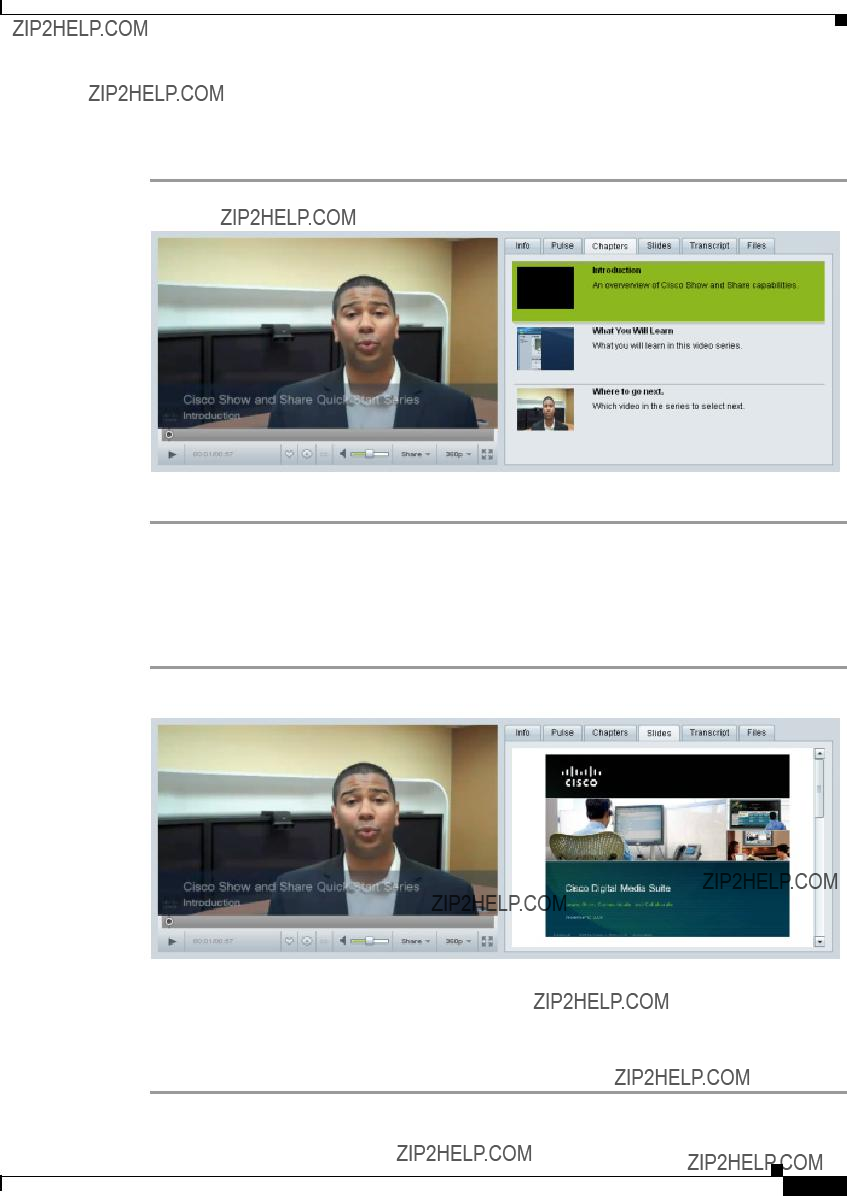
Chapter 4 Play, Comment, Tag, and Share Videos
Procedures
Jump to a Chapter
Procedure
Step 1 Click the Chapters tab.
Step 2 Click a chapter in the list to jump to that point in the video.
Watch Slides
Procedure
Step 1 Click the Slides tab.
The slides appear on the tab. They will change automatically as the video plays.
Step 2 To go through the presentation manually, use the scroll bar to see additional slides.
Step 3
Step 4 If the slides are difficult to read, hover your mouse over the slides and click the popout button ( ).
).
User Guide for Cisco Show and Share 5.3.x
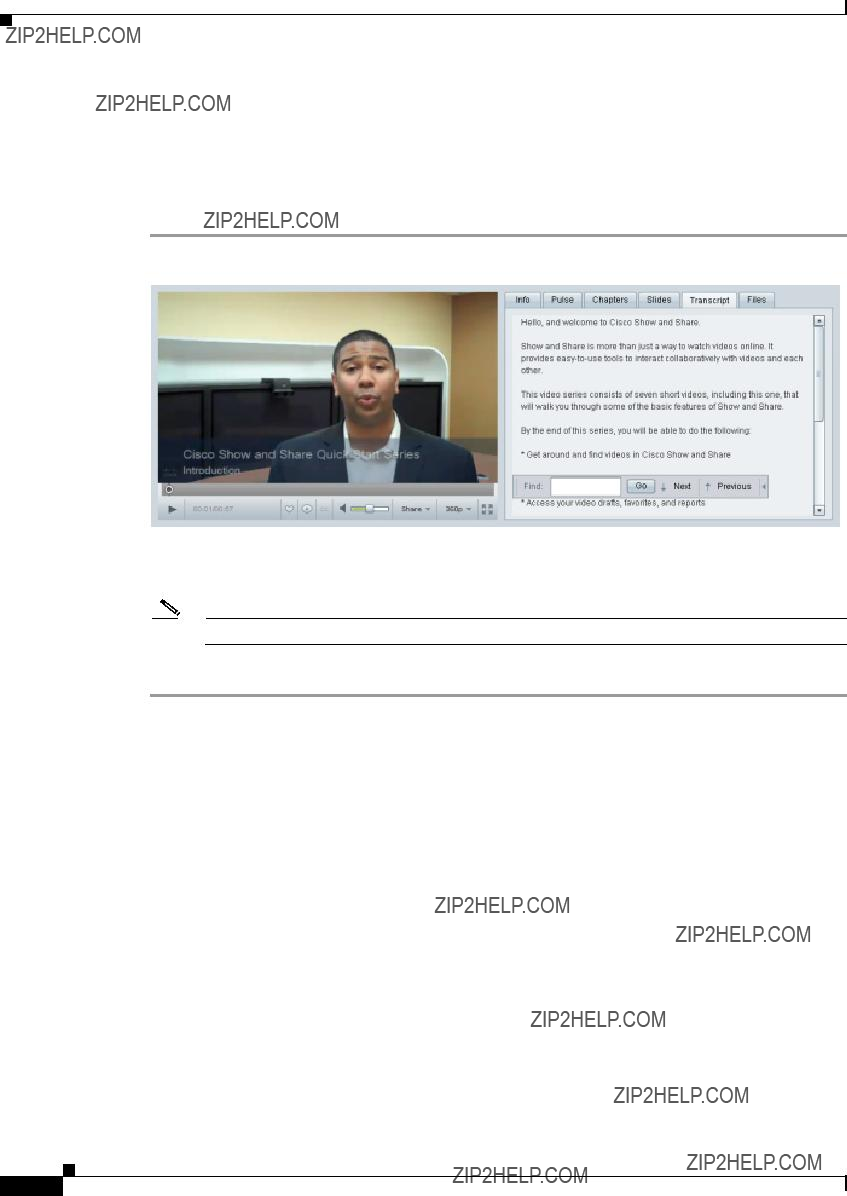
Chapter 4 Play, Comment, Tag, and Share Videos
Procedures
Read a Transcript
Transcripts are text files that are uploaded by the video author. They are not synchronized with the video and you cannot use them to navigate through the video.
Procedure
Step 1 Click the Transcript tab.
Step 2 To search the transcript, enter a word or phrase in the Find field and click go. You can continue searching through the transcript by clicking the Next and Previous buttons.
Note Searching the transcript does not navigate you through the video.
Step 3 Click the Hide arrow at the end of the search bar to hide it. You can expand it again later if needed.
User Guide for Cisco Show and Share 5.3.x

Chapter 4 Play, Comment, Tag, and Share Videos
Procedures
Download Files
Procedure
Step 1 Click the Files tab.
Step 2 Click a file name to download the file.
Note You cannot
User Guide for Cisco Show and Share 5.3.x

Chapter 4 Play, Comment, Tag, and Share Videos
Troubleshooting
Troubleshooting
When I download an attached Microsoft Word, PowerPoint, or Excel file from the Files tab, the saved file has a
.zip extension instead of a .docx, .xlsx, or .pptx extension.
This can occur when you download a .docx, .xlsx, or .pptx file from Cisco Show and Share using Microsoft Internet Explorer 8.
To fix the problem, simply change the .zip file extension to the correct file extension after downloading the file.
The aspect ratio of my embedded Flash video is not maintained on the web page.
To preserve aspect ratio, the Flash embed code requires width and height values for object classid and embed src.
My embedded video appears as a black box on the web page.
This can have several causes.
1.First use the same web browser you used to access the web page with the embedded video to access Cisco Show and Share. If you receive a security warning, follow the steps for your browser to accept the security certificate. Then try to access the page with the embedded video again.
2.If you did not receive a security warning, this may be caused by opening the HTML page with the embedded video as a file rather than a web page (for example,
You can determine whether or not you opened the HTML page as a file by looking at the address bar in your web browser. If you see a standard file path, such as c:\documents\example\index.htm, rather than a URL, such as http://example.com/example/index.htm, then you opened the HTML page as a file rather than a web page served by an HTML server.
When I click on an embedded video to play it, it disappears.
When I click on and embedded video to play it, I receive the message ???Windows media plugin not installed click here to install.???
This occurs on Mac OS. The video you are trying to play is in a Windows media format and playback is not supported on your OS.
The bottom of my video is cut off.
This may happen with some videos that are played back with the Quicktime plugin.
When I use my browser to zoom in during video playback, the video player controls disappear behind the video.
For the best viewing experience, we recommend that you use the video player controls for video playback. To increase the size of the video, use the fullscreen playback button.
I cannot fast forward, rewind, or use the play head to skip ahead or go back.
There are several possible causes for this:
???The video is not hosted on a streaming server. When a video is not hosted on a streaming server, it is supplied to you by ???progressive download???. In this case, the video starts playing while it is still downloading. You cannot fast forward past the point of where the download is reached.
???You are watching a .wmv video. The Windows media plugin for Firefox doe not allow you to use the fast forward, rewind, or play head to move around the video. If you are using the Internet Explorer browser, you can use the play head to move forward and backwards in the video.
User Guide for Cisco Show and Share 5.3.x

Chapter 4 Play, Comment, Tag, and Share Videos
Troubleshooting
I receive a security warning in my browser when I try to add a comment.
This can happen if the system administrator or the video publisher has prevented anonymous comments for the video and you are not yet logged into the system. This warning is not harmful. To continue, accept the certificate, log into the system, and then leave your comment.
There is a delay when I try to replay a video.
Trying to replay an FLV video right after it finishes can result in a
I do not see the 720p option for the video I am watching
The different resolutions available depend on several factors:
???The original resolution of the video being uploaded. If the resolution was below 720p, a 720p version will not be created for it.
???The system settings. Your system administrator may not have enabled that resolution.
User Guide for Cisco Show and Share 5.3.x

Chapter 4 Play, Comment, Tag, and Share Videos
Troubleshooting
User Guide for Cisco Show and Share 5.3.x

C H A P T E R 5
Edit Video
Revised: November 2013
Cisco Show and Share includes a
???Trim out unwanted parts of the video.
???Divide your video into chapters.
???Insert animated transitions between chapters.
???Synchronize a slide show with your video.
???Choose a new thumbnail for your video.
???Make speaker assignments for unrecognized speakers.
???Remove incorrect Pulse keywords.
Visit the following topics to learn more about the capabilities of and how to use the Cisco Show and Share video editor:
???About Video Editing, page
???Limitations and Restrictions, page
About Video Editing
The Cisco Show and Share
This type of editing does not actually change the original material in any way. Instead, it adds markers and pointers to information that accompanies video frames during playback.
User Guide for Cisco Show and Share 5.3.x

Chapter 5 Edit Video
Limitations and Restrictions
Limitations and Restrictions
???The Cisco Show and Share editor does not support the editing of Windows media (WMV, WMA, ASF, ASX) files. You need to edit those files outside of Cisco Show and Share using editing software that supports those formats.
Table
???You cannot edit Flash or MPEG4 videos that are referenced by URL rather than uploaded.
???For your edits and slide synchronization to appear, the video files must be served from a Flash streaming server.
???If the Pulse feature set or mobile application access is enabled, video clipping and splitting are disabled. When video splitting is disabled, the Add Transitions drawer will not appear in the editor. However, you can still add slide synchronization and chapters and change the thumbnail.
User Guide for Cisco Show and Share 5.3.x

Chapter 5 Edit Video
Procedures
Procedures
1.Open a Video to Edit, page
Open a Video to Edit
Procedure
Step 1 Choose My Account > Videos > Uploaded.
Step 2 Hover your mouse over the row for the video you want to edit and click Edit Video.
Note To edit a published video, you must first click Manage Video and then Save As Draft. This creates a draft version of the video in addition to the published version. The original published version remains available to viewers until you publish the new draft.
Cisco Show and Share opens its video editor and loads your video. The image below shows the video editor when the Pulse feature set is enabled.
User Guide for Cisco Show and Share 5.3.x

Chapter 5 Edit Video
Procedures
Edit Your Video
You can edit video with Cisco Show and Share. More specifically, you can:
???Create Chapters Within Your Video, page
???Add Transitions Between Segments, page
???Synchronize Slides to Your Video, page
???Change the Video Thumbnail, page
Tip Click Save often while editing your video to save your work in progress.
User Guide for Cisco Show and Share 5.3.x

Chapter 5 Edit Video
Procedures
Trim Your Video
The option to trim and split your video is not available if the Pulse feature set or mobile application access is enabled.
Step 4 To mark and delete a segment, do the following.
a.Drag the markers ( ) left or right along the timeline to mark the area to delete.
) left or right along the timeline to mark the area to delete.
b.Preview what you have marked ( ).
).
c.Delete what you have marked ( ) or cancel the deletion (
) or cancel the deletion (  ). Do not move the play head yet, you might want to add a transition effect to this spot to tie together the two parts of the video.
). Do not move the play head yet, you might want to add a transition effect to this spot to tie together the two parts of the video.
Step 5 (Optional) To add a transition effect:
a.Click Split the Video to split the video at the point where you trimmed it. The two segments of the video appear in the segment browser below the video.
b.Click the transition placeholder between the two segments.
c.Open the Transitions drawer and click Add for the transition you want to add. See Add Transitions Between Segments, page
Step 6 Click Save.
User Guide for Cisco Show and Share 5.3.x

Chapter 5 Edit Video
Procedures
Create Chapters Within Your Video
Cisco Show and Share adds a chapter marker ( ) to the timeline, where you paused the playback head (
) to the timeline, where you paused the playback head ( ).
).
Note The chapter marker may appear at the previous or next whole second rather than the location of the play head where the video was paused (for example, the marker may appear at 4 seconds rather than 3 seconds). This happens if when you pause the video between the second marks. The marker is placed at the next whole second if the video is paused at x.5 seconds or greater, and at the displayed whole second if it is paused at under x.5 seconds.
You can do the following with the chapter marker:
???You can hover your mouse pointer over the chapter marker to see information about the chapter.
???You can click the delete icon ( ) the chapter summary to remove the chapter.
) the chapter summary to remove the chapter.
???You can drag the chapter marker to move it to a new place on the timeline.
Step 7 Click Save.
User Guide for Cisco Show and Share 5.3.x
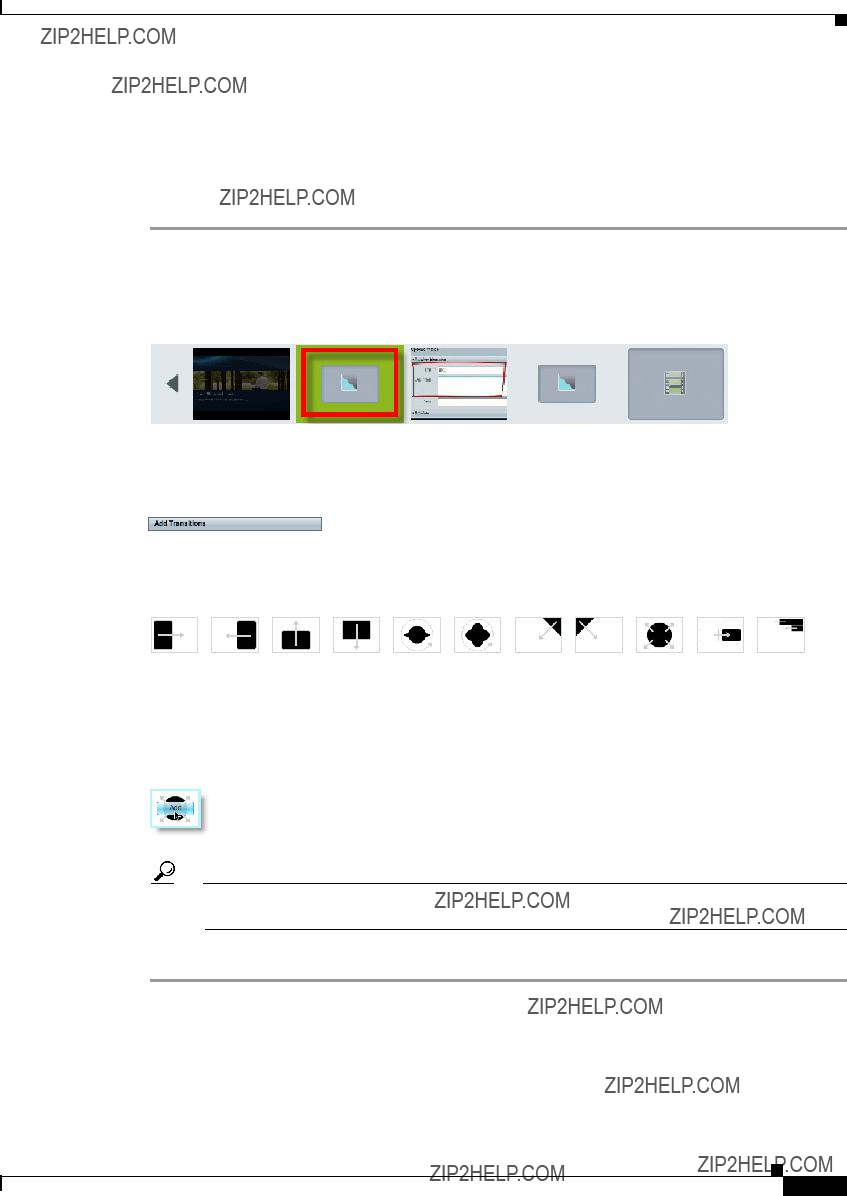
Chapter 5 Edit Video
Procedures
Add Transitions Between Segments
The option to add transitions between two parts of your video is not available if the Pulse feature set or mobile application access is enabled.
Procedure
Step 1 If your video does not have separate segments, move the play head to the place in your video where you want to add a transition and click Split the Video.
The two segments appear in the segment browser below the video. A transition placeholder appears between them.
Step 2 Click a transition placeholder in the segment browser to choose it.
Step 3 Open the Add Transitions drawer if it is closed.
Step 4 Mouseover any transition in the drawer to see its effect animated.
These are the transition effects.
Step 5 Click the Add button above a transition effect to use it.
Tip If you choose the wrong transition effect by mistake, you can drag it from the segment browser to the trash can. Then, simply choose another effect.
Step 6 Click Save.
User Guide for Cisco Show and Share 5.3.x

Chapter 5 Edit Video
Procedures
Synchronize Slides to Your Video
Procedure
1.If you did not upload slides when you initially uploaded or recorded the video, see Upload Slides.
2.After you have uploaded your slides, synchronize them to the video. See Synchronize Slides
Upload Slides
To add slides to your video package, export your slide deck as a series of sequentially numbered JPEG images. Then, collect these images together in a compressed ZIP archive.
Tip For best results, export your slides using the following dimensions:
???If your viewers mostly use the default slide window: 360x270 pixels
???If your viewers mostly use the resizable ???tearoff??? slide window: 800 x600 pixels.
Procedure
Step 1 Open the Slides drawer.
Step 2 Click Add Slides.
Step 3 Browse to the individual .jpg files or to the .zip file that contains your slides. If you are uploading individual .jpg files, you can select multiple files in the dialog box.
Step 4 Click Open.
The slides appear in the slide drawer.
User Guide for Cisco Show and Share 5.3.x

Chapter 5 Edit Video
Procedures
Synchronize Slides
Procedure
Step 1 Open the Add Slides drawer if it is closed.
Step 2 You can use the zoom slider at the top of the drawer to resize your slides for better legibility.
Step 3 Move the play head on your video to where you want to add the slide, and then click Add on the slide you want to synchronize to that location.
Tip You can play your video and hover your mouse over the next slide you want to add. Click Add when the play head gets to the place where you want the slide to appear. This way you can quickly add slides without pausing the playback.
Step 4 Repeat for each slide in the slide deck.
Step 5 Click Save.
User Guide for Cisco Show and Share 5.3.x
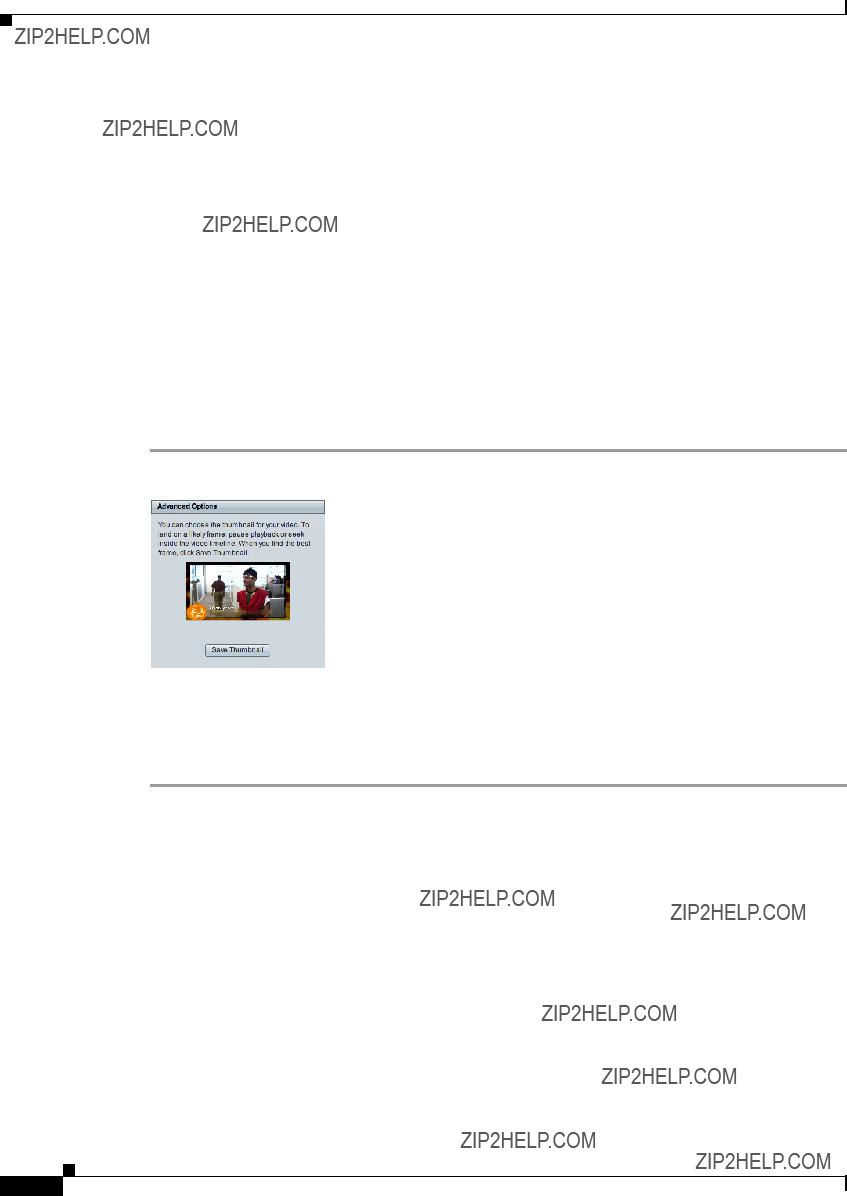
Chapter 5 Edit Video
Procedures
Change the Video Thumbnail
By default, Cisco Show and Share assigns a thumbnail according to the following rules:
If you have a video that is longer than 8 seconds, but the title shot only lasts for 5 seconds, the automatically generated thumbnail may not contain your video title. Or, if you recorded a message, the system may have captured an unflattering facial expression for the thumbnail. Use this procedure to correct the situation.
Procedure
Step 1 Open the Advanced Options drawer if it is closed.
Step 2 Move the playback head to the frame you want to use as the thumbnail.
Step 3 Click Save Thumbnail.
Step 4 Click Save.
User Guide for Cisco Show and Share 5.3.x
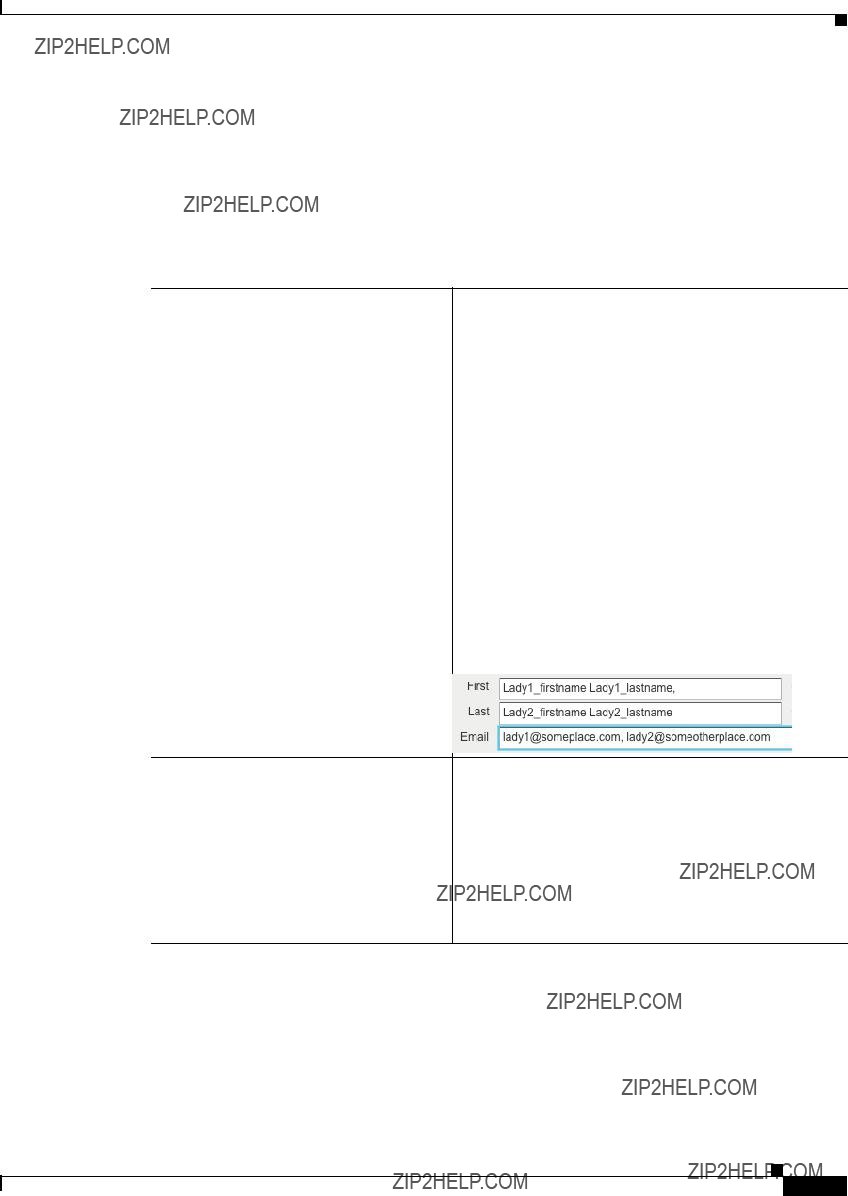
Chapter 5 Edit Video
Procedures
Label Speakers
When the Pulse feature set is enabled, the Pulse speaker identification engine attempts to identify the speaker in a video. It does this by comparing the voice print with those of previously identified speakers. If the Pulse engine cannot identify the speaker, it assigns the voiceprint a generic label, such as Speaker 1.
How to Label Unidentified or Guest Speakers in a Video
Guidelines and Limitations
???For appliances running Release 5.3 and earlier, you can only assign unidentified speaker names from the users that are already present within Cisco Show and Share.
For appliances running Release 5.3.7 and later, if you have a guest speaker from outside of your organization and that person does not have a Cisco Show and Share account, you can assign that person???s name as a guest speaker.
User Guide for Cisco Show and Share 5.3.x

Chapter 5 Edit Video
Procedures
???If you assign a new speaker name to a
???Videos uploaded before the Pulse feature set was enabled will not contain speaker identification. You need to
???Sometimes the same speaker can be labeled as two different speakers, or a previously identified speaker fails to be identified. This can happen when the audio quality differs between videos or video segments. Simply assign the same name to the two different speakers or to the unidentified speaker. The more samples you have of a speaker???s voice, the more accurate the system becomes.
Label Unidentified Speakers
Procedure
Step 1 Choose My Account > Videos > Uploaded.
Step 2 Hover your mouse over the row for the video you want to edit and click Edit Video.
Step 3 Open the Speakers drawer if it is closed.
The list of speakers identified in the video appears. The color codes assigned to the speaker appear in the timeline where that speaker was identified.
Step 4 Click Name next to the speaker you want to identify.
The Assign Speaker Name dialog box appears.
Step 5 Use the page controls at the bottom of the dialog box or the search field above the name list to find the user that you want to assign.
Step 6 Click the username and then click Select.
Step 7 Click Rename the voiceprint in the confirmation dialog box.
User Guide for Cisco Show and Share 5.3.x
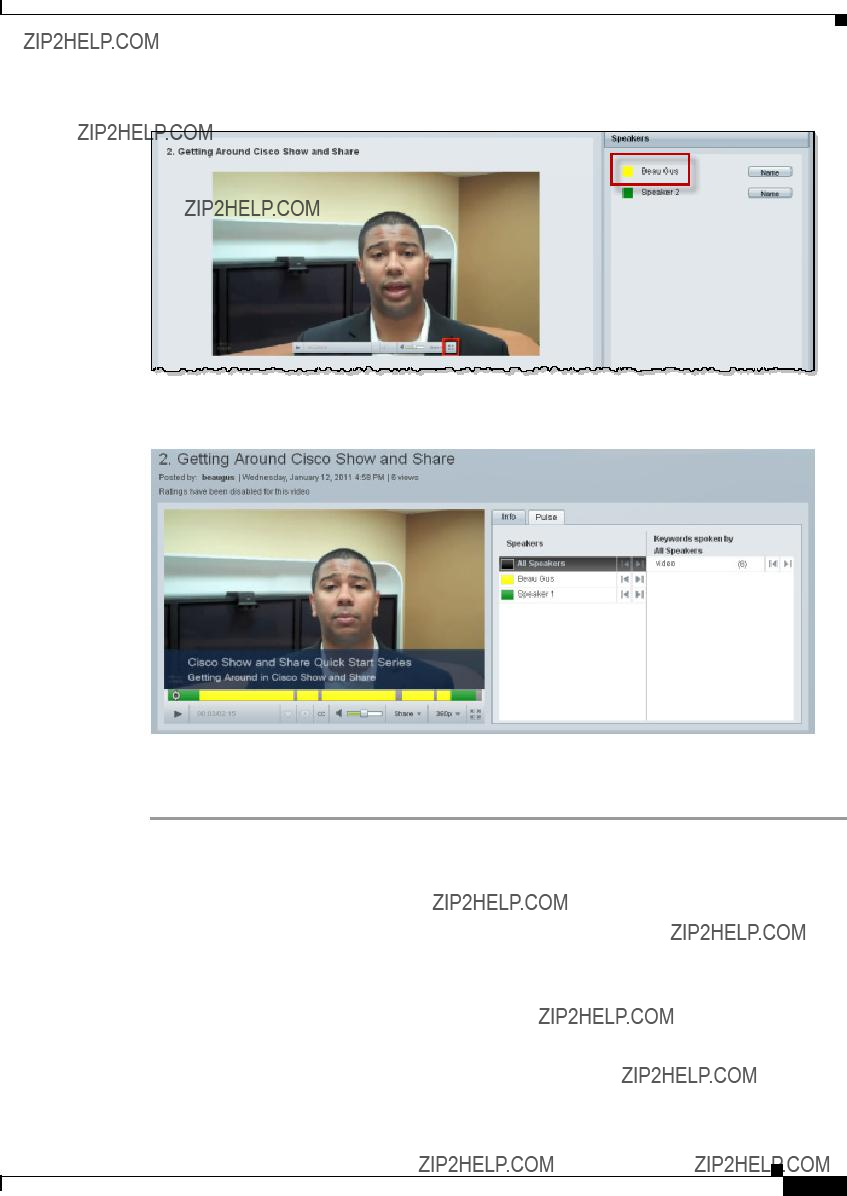
Chapter 5 Edit Video
Procedures
The voiceprint in the current and any future uploaded videos is identified with the name you selected.
When you view the video in the Video Playback page, the speaker identification appears on the Pulse tab.
Step 8 Repeat this procedure for each speaker you need to identify.
Step 9 Click Save.
Label Guest Speakers
For appliances running Release 5.3.7 and later, if the speaker is not a user that is already present within Cisco Show and Share, you can label that speaker???s name as a guest speaker from outside of your organization.
Guidelines and Limitations
???If you label a guest speaker, that change will appear only for the existing video. If the video is uploaded again and processed by the Pulse engine, you will need to
???Videos uploaded before the Pulse feature set was enabled will not contain speaker identification. You need to
User Guide for Cisco Show and Share 5.3.x

Chapter 5 Edit Video
Procedures
Procedure
Step 1 Choose My Account > Videos > Uploaded.
Step 2 Hover your mouse over the row for the video you want to edit and click Edit Video.
Step 3 Open the Speakers drawer if it is closed.
The list of speakers identified in the video appears. The color codes assigned to the speaker appear in the timeline where that speaker was identified.
Step 4 Click Name next to the speaker you want to identify.
The Assign Speaker Name dialog box appears.
User Guide for Cisco Show and Share 5.3.x

Chapter 5 Edit Video
Procedures
Step 9 Repeat this procedure for each speaker that you need to identify.
Step 10 Click Save.
Step 11 Click Exit.
Tip Changes take effect when you publish the video.
Delete Keywords
For appliances running Release 5.3.7 and later, you can remove incorrect Pulse keywords on a
Guidelines and Limitations
???If you delete keywords, that change will appear only for the existing video. If the video is uploaded again and processed by the Pulse engine, you will need to delete the keywords again.
???Keywords are also deleted from the Cisco Show and Share search functionality.
Procedure
Step 1 Choose My Account > Videos > Uploaded.
Step 2 Hover your mouse over the row for the video you want to edit and click Edit Video.
Step 3 Open the Keywords drawer if it is closed.
The list of keywords identified in the video appears. The color codes assigned to the keywords appear in the timeline where that speaker was identified.
Step 4 Check the check boxes next to the keywords that you want to remove from this video.
Note You cannot undo keyword deletion.
Step 5 Click Save.
Step 6 Click Exit.
User Guide for Cisco Show and Share 5.3.x

Chapter 5 Edit Video
Troubleshooting
Troubleshooting
My edits do not appear when I play the video back after publishing. Why weren???t they saved?
Cisco Show and Share uses nondestructive editing. This means that instead of changing the actual video, Cisco Show and Share inserts markers and pointers to indicate the changes. This type of editing requires the video to be served from a Flash streaming server. If the videos are stored on the Cisco Show and Share server itself, they will be served from a Flash streaming server.
However, quite often the video source is actually stored and served from an external server dedicated to storing large quantities of video files. If the video is being served from another type of server, for example a simple web server, then the edits that you make will not appear during playback. If you experience this problem, contact your system administrator for more information about the type of server being used for the videos.
Where do I go to change the keywords for the Pulse keyword identification feature?
Viewers and Authors cannot add keywords to the Pulse keyword identification engine. Your Cisco MXE administrator is responsible for maintaining the list.
User Guide for Cisco Show and Share 5.3.x

C H A P T E R 6
Publish Your Video
Revised: November 2013
After you have uploaded or recorded a video and made any edits, the final task you have is to publish it. Before you publish your video, you can:
???Update the title, description, and tags.
???Assign it to categories.
???Choose who can see it.
???Disable page options (comments, ratings, tags, and sharing) individually.
???Link to related videos.
???Schedule exactly when it should become visible to other users.
???Schedule exactly when it should be archived (hidden from other users).
Procedures
Follow these steps to publish your video. Only the fist and last steps are mandatory; the other steps are optional items you can perform before publishing your video.
1.Access the Publish Your Video Page, page
2.(Optional) Edit the Video Summary, page
3.(Optional) Restrict Viewer Access to the Video, page
4.(Optional) Disable Pulse Speakers and Keywords, page
5.(Optional) Add the Video to a Category, page
6.(Optional) Set the Video Interaction Options, page
7.(Optional) Add Related Videos, page
8.(Optional) Schedule Publication, page
9.Publish the Video, page
User Guide for Cisco Show and Share 5.3.x
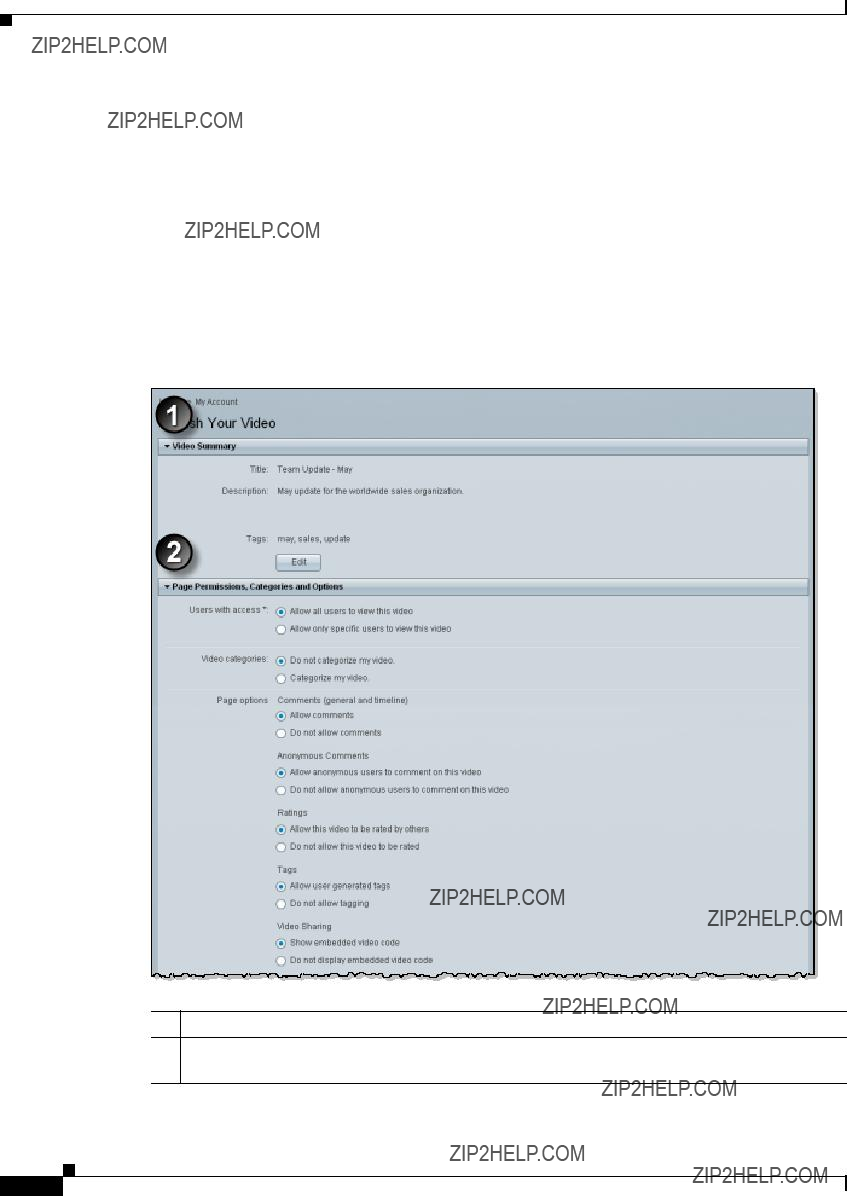
Chapter 6 Publish Your Video
Procedures
Access the Publish Your Video Page
You can access the Publish Your Video page from several places within Cisco Show and Share:
The Publish Your Video page appears.
1Video Summary. See Edit the Video Summary, page
2Page Permissions. See Add the Video to a Category, page
User Guide for Cisco Show and Share 5.3.x
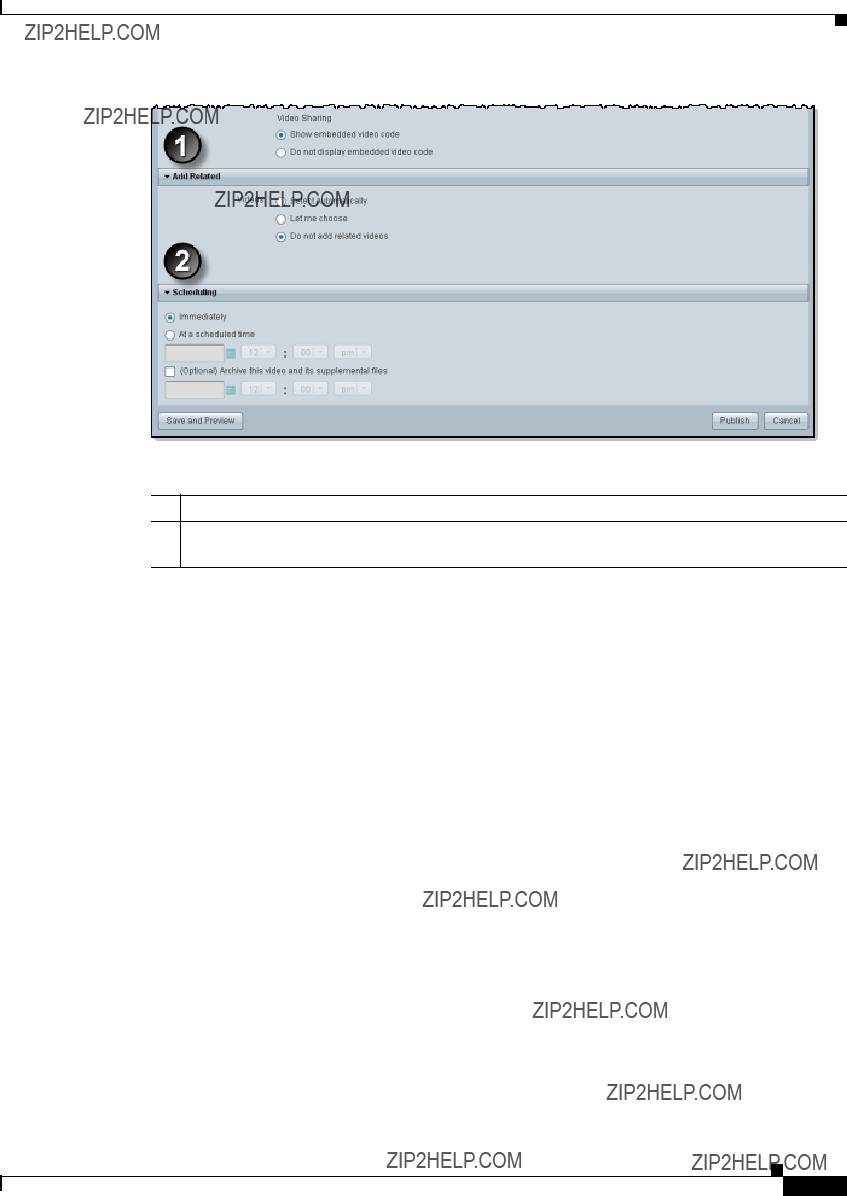
Chapter 6 Publish Your Video
Procedures
1Add Related. See Add Related Videos, page
2Scheduling. See Schedule Publication, page
User Guide for Cisco Show and Share 5.3.x

Chapter 6 Publish Your Video
Procedures
Edit the Video Summary
This is an optional step in publishing your video.
Procedure
Step 1 Expand the Video Summary drawer.
Step 2 Click Edit.
The Title, Description, and Tags fields become editable.
Step 3 Enter the new information in the fields. When entering more than one tag, separate the tags with a space.
Restrict Viewer Access to the Video
This is an optional step in publishing your video. When you restrict access to a video, it will no longer appear on the Home page. Instead, it will appear in the Private tab of the My Account > Videos page for users that you give access to the video.
Note Videos with restricted viewer access cannot be added as related videos.
You do not need to add yourself to the viewing privileges of videos that you upload. You are automatically given privileges to those videos and the videos will appear on the Private tab on your My Account page.
Procedure
Step 1 Expand the Page Permissions, Categories and Options drawer.
Step 2 Choose Allow only specific users to view this video.
The Group table appears.
Step 3 Click Select Group.
The Group Selector dialog appears.
User Guide for Cisco Show and Share 5.3.x
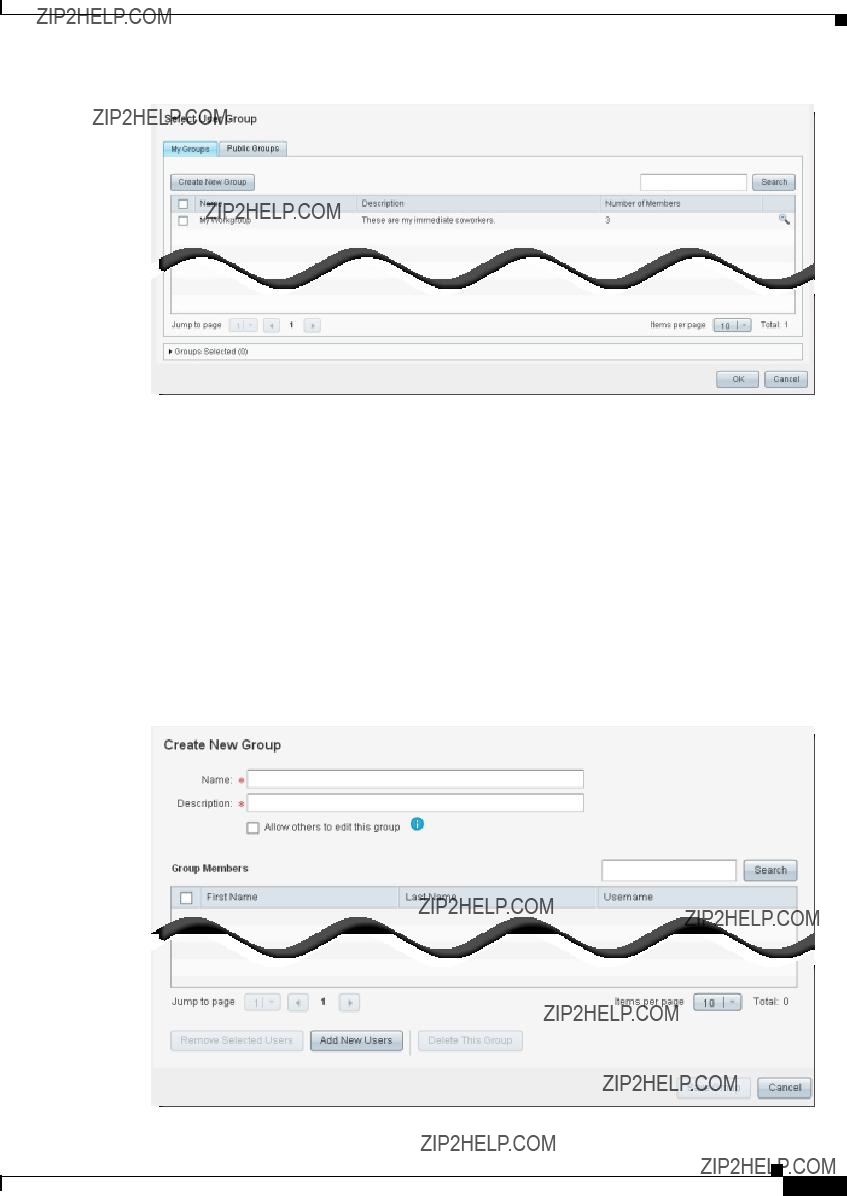
Chapter 6 Publish Your Video
Procedures
Step 4 To use one or more groups that you have created, do the following:
a. Select the check box next to the group name. You can select more than one group. b. Click OK.
Step 5 To pick an existing public group, do the following. Public groups are groups that you or others have created and have given permission for others to use and edit.
a. Click the Public Groups tab.
a.Select the check box next to the group name. You can select more than one group.
b.Click OK.
Step 6 To create a new group, do the following:
a.Click Create New Group.
The Create New Group dialog appears.
User Guide for Cisco Show and Share 5.3.x

Chapter 6 Publish Your Video
Procedures
b.Type a name for your new group in the Name field. This field is required.
c.Type a description for your new group in the Description field. This field is required.
d.Select Allow others to edit this group if you want to make the group public.
Selecting this option allows other people to add and remove users from this group. They will also be able to delete the group.
If you make the group public, it will not appear on the My Groups tab. Instead, it will appear on the Public Groups tab.
e.Click Add New Users. You must add at least one user to the group to save the group. The Select Group Users dialog appears.
f.You can page through the list of users or use the search function to find the users to add. Select the check box next to their name to include the user in the group.
g.Click Save to close the Select Group Users dialog box.
h.Click Save Group to close the Create New Group dialog box.
a.Select the check box next to the group name. You can select more than one group.
b.Click OK.
Step 7 To remove a group from the Group table, click the trash can icon next to the group. To disable viewing restrictions (and make the video public), select Allow all users to view this video.
User Guide for Cisco Show and Share 5.3.x
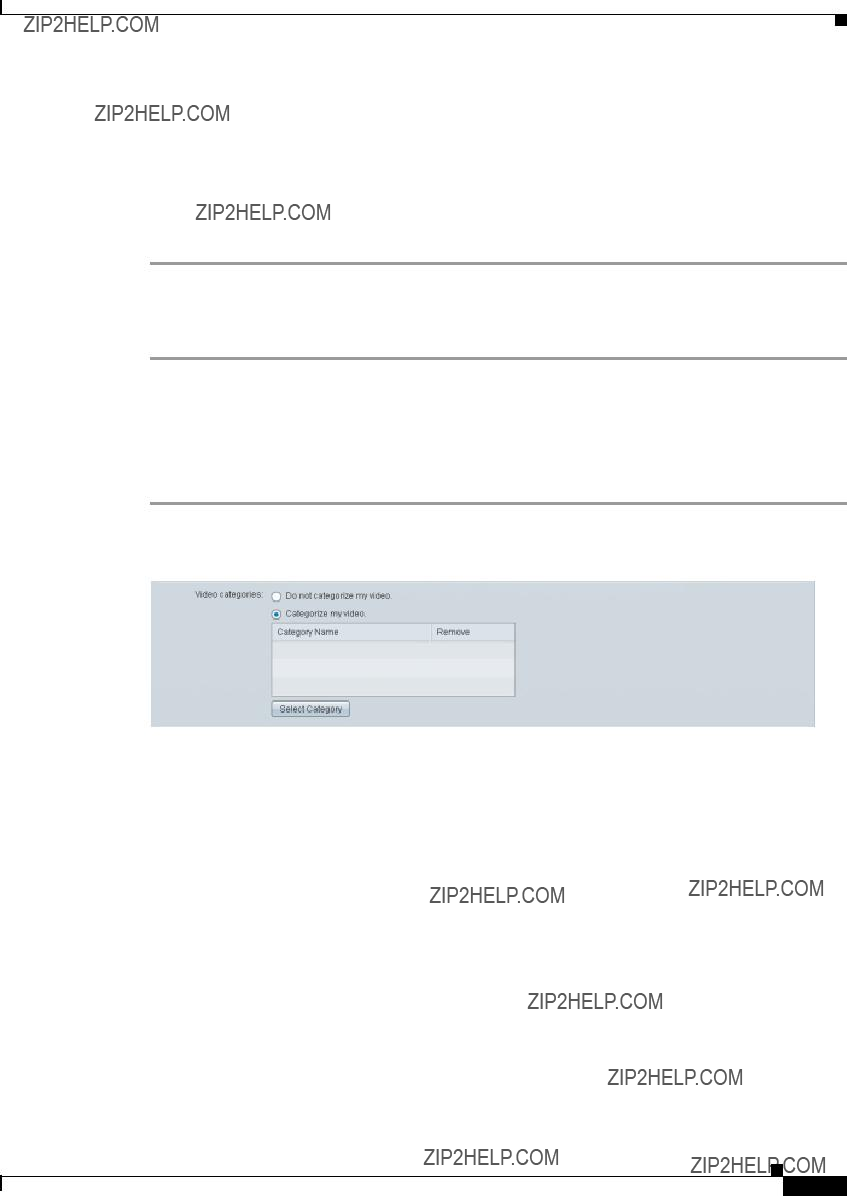
Chapter 6 Publish Your Video
Procedures
Disable Pulse Speakers and Keywords
For appliances running Release 5.3.7 and later, you can disable Pulse Speakers and Keywords on a
You cannot enable or disable a feature for a video if the system administrator disabled it globally.
Procedure
Step 1 Expand the Page Permissions, Categories and Options drawer.
Step 2 Select Do not Display Pulse Speakers and Keywords.
Step 3 Choose Save and Preview or choose Publish.
Add the Video to a Category
Procedure
Step 1 Expand the Page Permissions, Categories and Options drawer.
Step 2 Click Categorize my video.
Step 3 Click Select Category.
The category picker appears.
User Guide for Cisco Show and Share 5.3.x
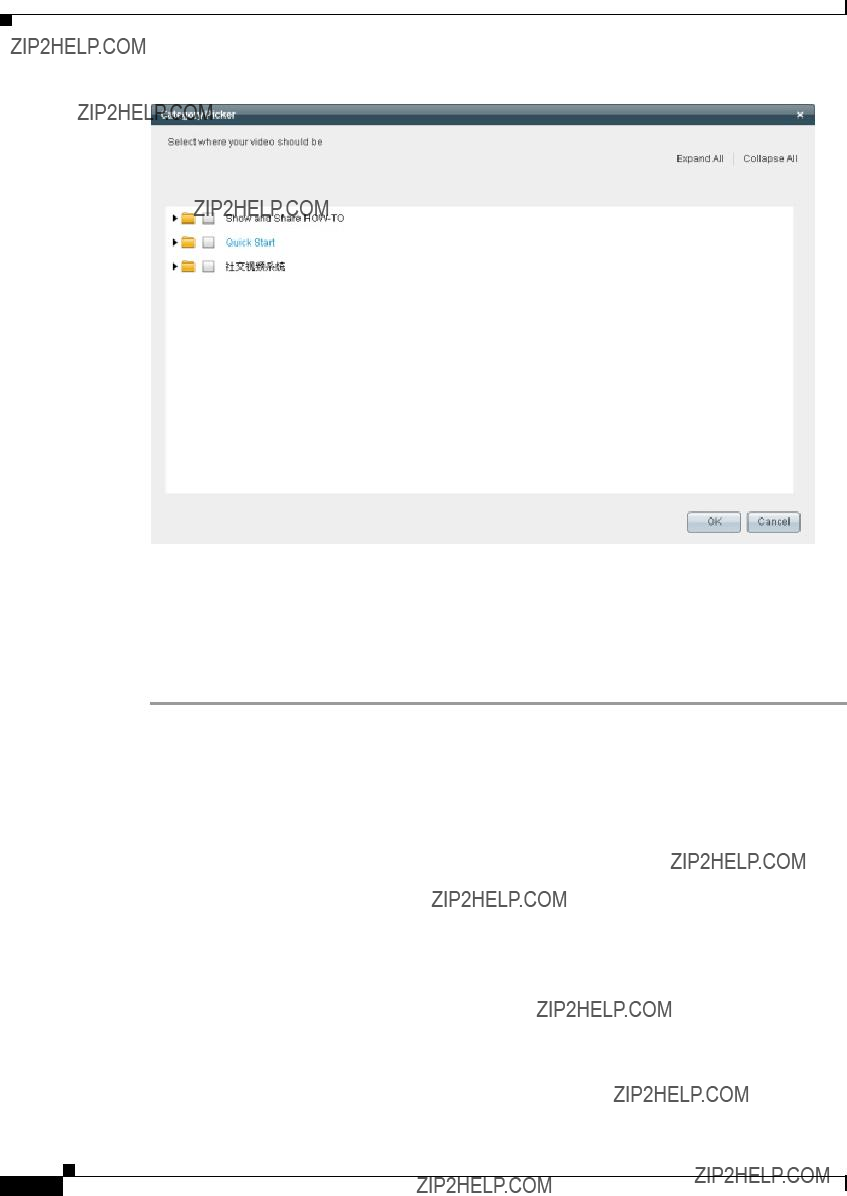
Chapter 6 Publish Your Video
Procedures
Step 4 Click Expand All to list the available categories or click the triangle icon to the left of a category to expand only that category.
Step 5 Check the check box for each category that you want to use. Uncheck any check boxes, as needed, for categories that you prefer not to use.
Step 6 Click OK to confirm your choices and close the Category Picker.
User Guide for Cisco Show and Share 5.3.x

Chapter 6 Publish Your Video
Procedures
Set the Video Interaction Options
You can disable specific interaction features, such as the ability to comment on a video, on a
You cannot enable a feature for a video if the system administrator has disabled it globally.
Procedure
Step 1 Expand the Page Permissions, Categories and Options drawer.
Step 2 Disable specific features for this video:
User Guide for Cisco Show and Share 5.3.x

Chapter 6 Publish Your Video
Procedures
Add Related Videos
Note Videos with restricted viewer access cannot be added as related videos.
Procedure
Step 1 Expand the Add Related drawer.
Step 2 To have Cisco Show and Share automatically choose related videos, choose the Select Automatically option. Related videos are chosen based on the tags and categories they have in common with the video you are publishing.
Step 3 To choose the related videos manually:
a. Select Let me choose.
b.Click Add.
The video Browser appears.
c.Browse through the list using the page controls at the bottom of the Video Browser or search for videos using the Search box. Search looks for the term in video titles, descriptions, tags, and author attributes.
d.Select the check box to the left of the videos you want to include in the Related Videos list.
User Guide for Cisco Show and Share 5.3.x

Chapter 6 Publish Your Video
Procedures
e. Click OK.
Schedule Publication
By default, videos are published immediately after you click Publish. You can schedule videos to publish at a later date and time. You can also specify a date and time when the video should no longer be available to viewers (however, it will still appear on your Uploaded video tab on the My Account page).
Procedure
Step 1 Expand the Scheduling drawer.
Step 2 To schedule a date and time for the video to appear:
a. Choose At a scheduled time.
b. Click in the date box and select a date from the calendar that appears.
c. Use the
Step 3 (Optional) To schedule a date and time when viewers should no longer be able to access the video:
a.Check the Archive this video check box.
b.Click in the date box and select a date from the calendar that appears.
c.Use the
User Guide for Cisco Show and Share 5.3.x

Chapter 6 Publish Your Video
Procedures
Publish the Video
After setting any optional video attributes, publish your video.
Procedure
Step 1 (Optional) Click Save and Preview to save your video as a draft and go to the video preview page.
Step 2 Click Publish.
User Guide for Cisco Show and Share 5.3.x

C H A P T E R 7
Create, Add, and Manage Videos
Revised: November 2013
Topics in this section describe ways that you can contribute video and supplemental files to your Cisco Show and Share community.
???About Video Uploads, page
Prerequisites
You must
About Video Uploads
When you upload a video to Cisco Show and Share, one of two things happens:
1.The video is uploaded to Cisco Show and Share in its native format and served back to viewers in that form.
2.The video is sent to a Cisco MXE to be transcoded into a common format, in this case the .mp4 format, and is served back to viewers in that format. This format is also compatible with the Cisco Show and Share video editor, which enables you to synchronize slides with the video.
The Cisco MXE also enables the Cisco Show and Share mobile application support, the Pulse keyword and speaker identification features, and the ability to select different resolutions when viewing videos. Having a Cisco MXE integrated with your Cisco Show and Share system also enables additional upload formats.
To tell which type of system you have, check the status of the video after uploading it. If the status starts with the word Processing, then you have a Cisco MXE integrated with your Cisco Show and Share and the additional file formats and benefits are available to you.
User Guide for Cisco Show and Share 5.3.x

Chapter 7 Create, Add, and Manage Videos
Procedures
Procedures
Adding a video to Cisco Show and Share is accomplished in three easy steps:
1.Record, Upload, or Link a Video, page
2.Add Supplemental or Downloadable Files to a Video, page
3.Save or Publish Your Video, page
Record, Upload, or Link a Video
You can add video to Cisco Show and Share in one of two ways:
???Use a Webcam to Record Video from Your Computer, page
???Upload a Video File, page
???Link to a Video File, page
Use a Webcam to Record Video from Your Computer
We support many
Note When you use this method, Cisco show and Share encodes your video at a resolution of 320 x 240, with a 400 kbps bitrate.
If your system has the Pulse features enabled, videos recorded in Cisco Show and Share will be transcoded by the Cisco MXE. Pulse keyword and speaker identification will be available for them and they will be viewable in the Cisco Show and Share mobile application.
Before You Begin
Exit from all open software except your browser. This makes memory and network bandwidth available for video capture and data transfer.
Procedure
Step 1 Open the Record a Video page:
???Navigate to the Home page and then choose Add Video > Record a Video.
???Navigate to the My Account page and then click Record Video.
If you are not
User Guide for Cisco Show and Share 5.3.x

Chapter 7 Create, Add, and Manage Videos
Procedures
Step 2 Click Allow in response to the Camera and Microphone Access prompt.
This prompt allows Cisco Show and Share to temporarily use your webcam and microphone. To protect your security and privacy, this permission expires when you leave this page or close your browser. Until you respond to this prompt, you cannot do anything else on the Record a Video page.
Tip If you do not see the Camera and Microphone Access prompt, confirm that your computer hardware and software meet all requirements. See http://cisco.com/go/dms/releasenotes. If you are recording from Mac OS X, you may need to reset the zoom setting in your browser by pressing Command+0.
Step 3 Enter a title for your video in the Title field.
This title identifies the video that your webcam will record and any supplemental or downloadable files ??? such as slides or a text transcript ??? that you might later package together with it.
Step 4 (Optional) Enter a description for your video in the Description field.
The description you enter appears on the Info tab of your video on the Video Playback page. The Description field supports a small subset of HTML that you can use to format the text. See HTML Supported by the Description Field, page
Step 5 (Optional) Enter tags for your video in the Tags field. You can enter more than one tag for your video. Separate multiple tags with a space.
User Guide for Cisco Show and Share 5.3.x
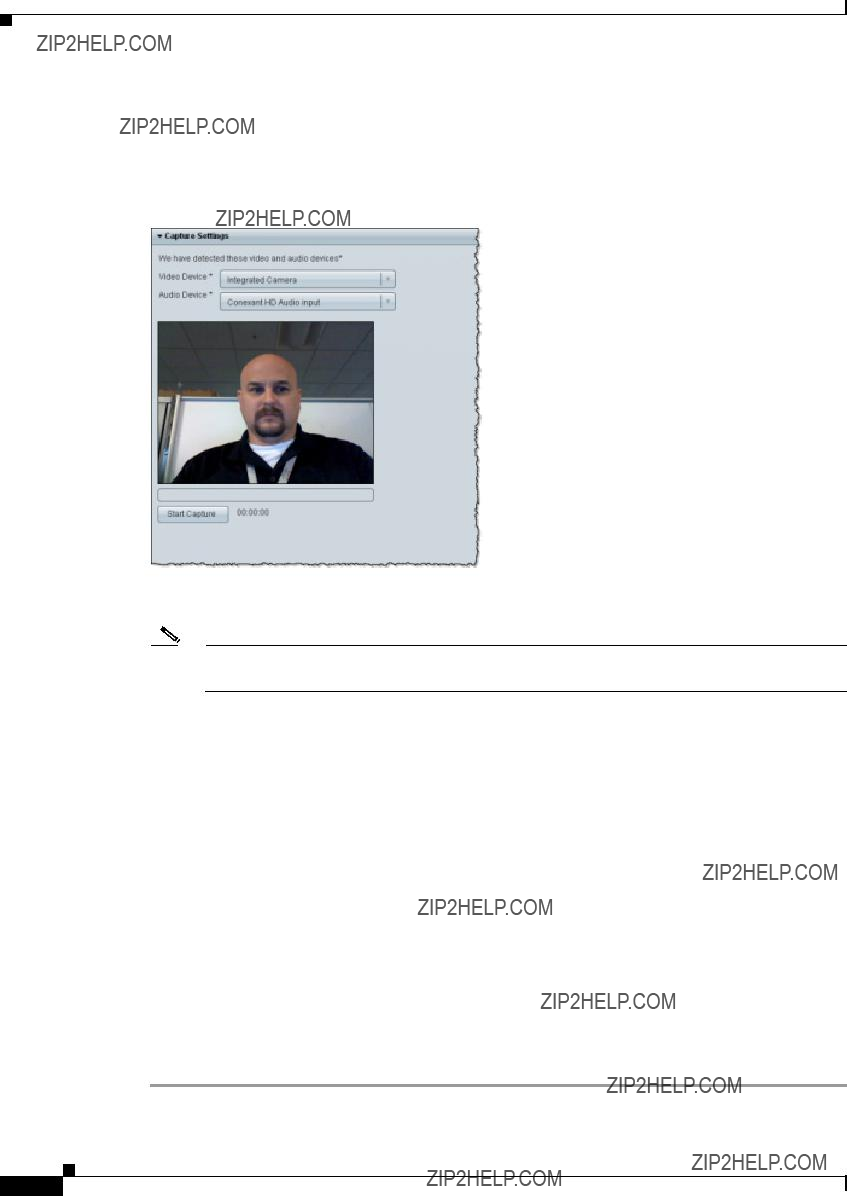
Chapter 7 Create, Add, and Manage Videos
Procedures
Step 6 If you have more than one video or audio device attached to you computer, select the ones you want to use for this session from the Video Device and Audio Device
After a few seconds, your webcam should be activated and you should see yourself in the preview window. If you do not see yourself, try choosing a different device.
Step 7 Click Start Capture. Pause for a few seconds, then begin to speak.
Note If your recording lasts for 90 minutes, you are given notice that the recording will automatically shut off. You can cancel the warning and continue recording for longer than the 90 minutes.
While recording, you can do the following:
???Click Pause to pause the recording.
???Click Continue to resume recording.
???Click Start Over to erase the current recording and start again.
If you make a mistake while recording, it might not be necessary to start over. If video editing is enabled for your implementation of Cisco Show and Share, You can use Cisco Show and Share???s editing tools to edit out the mistake. Simply pause for a second and then
Step 8 Click Pause when you are ready to save your video.
Step 9 (Optional) Click Download a local copy of this video to save a copy of the video locally. The dialog boxes and download location depend upon the browser you are using.
Step 10 Now you can add additional content to the video or save and publish your video. See the following topics for more information:
???Add Supplemental or Downloadable Files to a Video, page
???Save or Publish Your Video, page
User Guide for Cisco Show and Share 5.3.x

Chapter 7 Create, Add, and Manage Videos
Procedures
Upload a Video File
You can upload and publish video files that use supported formats and filename extensions.
Table
1. Requires a Cisco MXE 3500 running Release 3.3 software.
Note In this release, Windows Media on the Macintosh platform is available only with a Windows emulator.
Note When you upload a video for transcoding by using an iPhone or iPad, the Cisco MXE 3500 transcodes the file in the lowest resolution setting. This is because the iPhone or iPad application compresses the video on the client side to a lower resolution. The uploaded video causes Cisco Show and Share to automatically request the low resolution version from the Cisco MXE 3500. For best results, you should upload the video by using a PC.
Limitations and Restrictions
The maximum file size you can upload is 2 GB.
Procedure
Step 1 Open the Upload Video page:
???Navigate to the Home page and then choose Add Video > Upload a Video.
???Navigate to the My Account page and then click Upload Video.
If you are not
User Guide for Cisco Show and Share 5.3.x
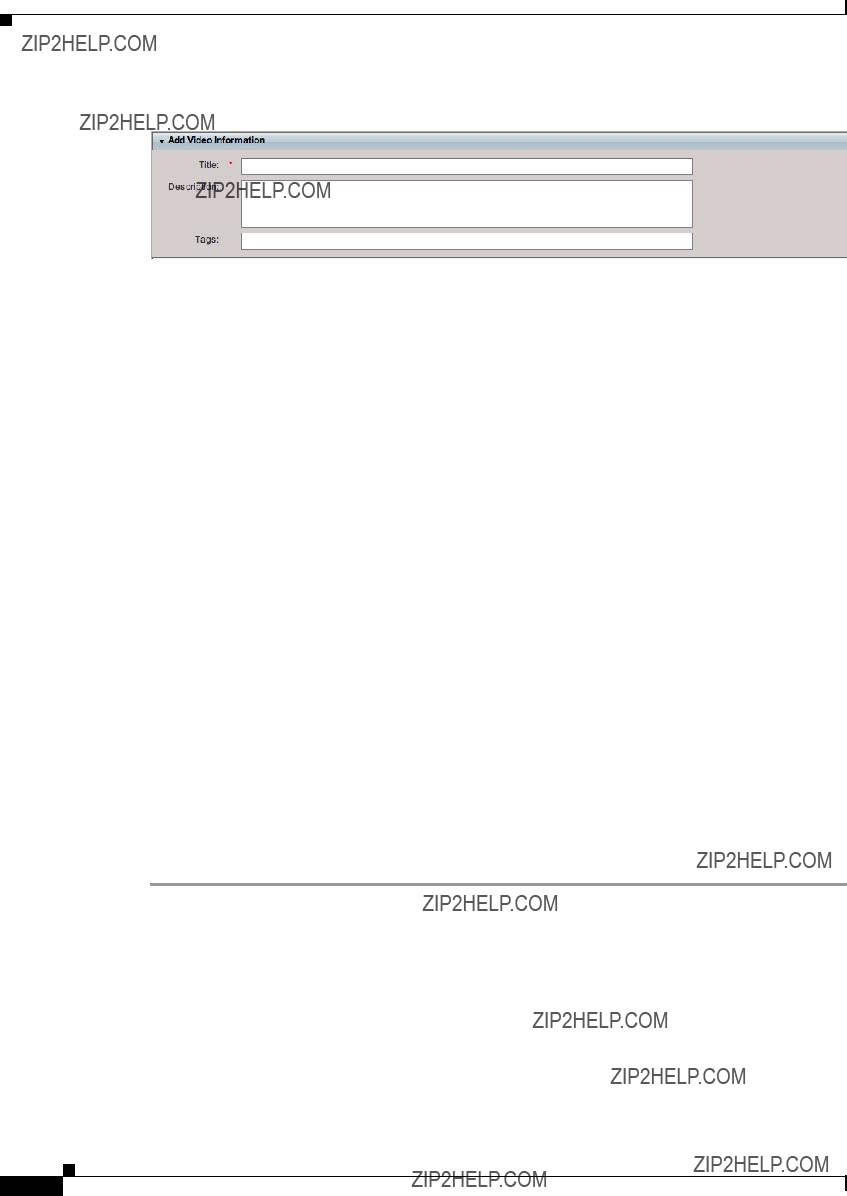
Chapter 7 Create, Add, and Manage Videos
Procedures
Step 2 Enter a title for your video in the Title field.
This title identifies the video and any supplemental or downloadable files ??? such as slides or a text transcript ??? that you might later package together with it.
Step 3 (Optional) Enter a description for your video in the Description field.
The description you enter appears on the Info tab of your video on the Video Playback page. The Description field supports a small subset of HTML that you can use to format the text. See HTML Supported by the Description Field, page
Step 4 (Optional) Enter tags for your video in the Tags field. You can enter more than one tag for your video. Separate multiple tags with a space.
Step 5 Expand the Add Video drawer.
Step 6 Click Browse. Browse to the local video file and click Open.
Step 7 (Optional) If you are uploading a .wmv file, and the system administrator has enabled this feature, an additional checkbox appears. If your .wmv file contains embedded closed captioning or slide synchronization, and you want to preserve them, check this checkbox.
This option is only available for Windows media files. And it only appears if the system uses Cisco MXE to transcode video and if the system administrator has allowed bypassing the conversion of Windows media files.
If you selected a Windows media file, and it contains closed captioning or
Step 8 Now you can add additional content to the video or save and publish your video. See the following topics for more information:
???Add Supplemental or Downloadable Files to a Video, page
???Save or Publish Your Video, page
User Guide for Cisco Show and Share 5.3.x
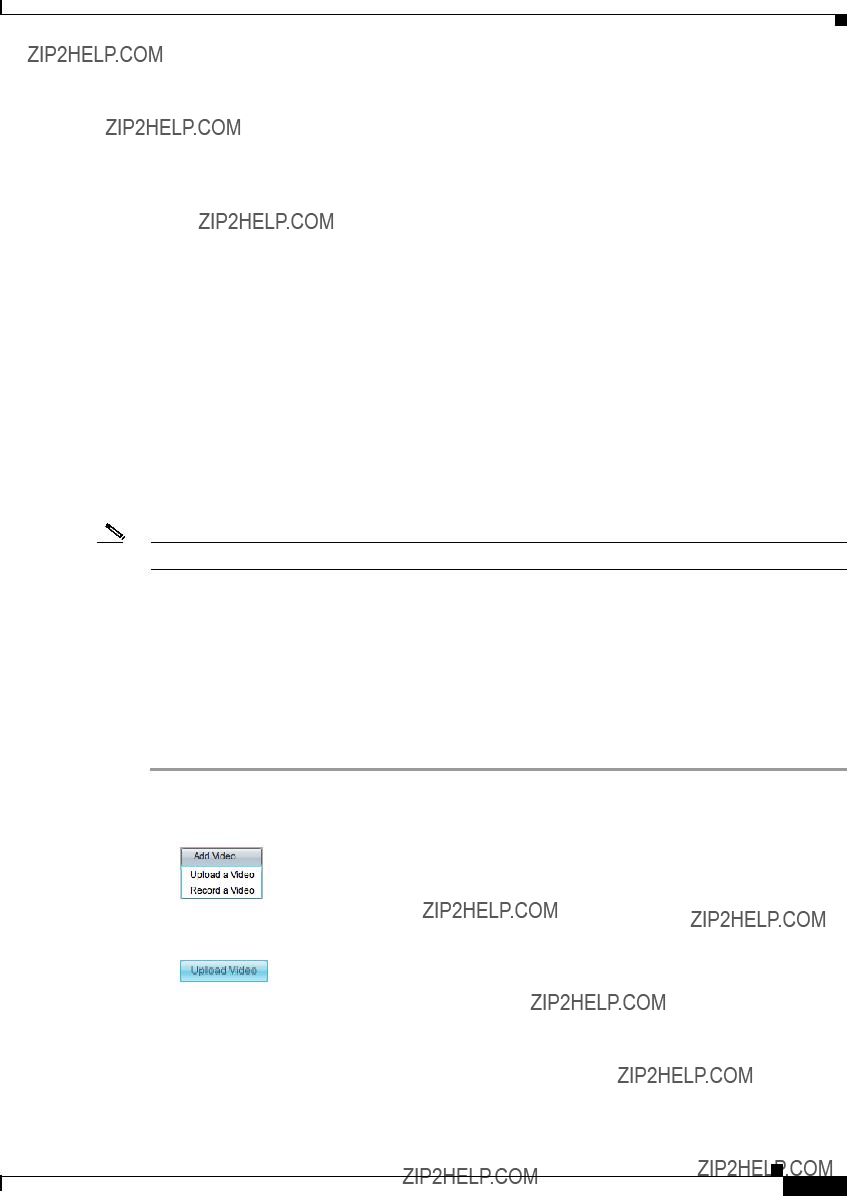
Chapter 7 Create, Add, and Manage Videos
Procedures
Link to a Video File
Instead of uploading a file, you can link to a file that resides on another server. When you link to a file on another server, that file remains on and is served from that server.
Note In this release, Windows Media on the Macintosh platform is available only with a Windows emulator.
Guidelines and Limitations
???You cannot edit files that are linked to from external servers.
???Pulse features are not available for externally linked files becasue they are not processed by the Cisco MXE.
???Externally linked files will not be available through the mobile application.
Procedure
Step 1 Open the Upload Video page:
???Navigate to the Home page and then choose Add Video > Upload a Video.
???Navigate to the My Account page and then click Upload Video.
If you are not
User Guide for Cisco Show and Share 5.3.x

Chapter 7 Create, Add, and Manage Videos
Procedures
Step 2 Enter a title for your video in the Title field.
This title identifies the video and any supplemental or downloadable files ??? such as slides or a text transcript ??? that you might later package together with it.
Step 3 (Optional) Enter a description for your video in the Description field.
The description you enter appears on the Info tab of your video on the Video Playback page. The Description field supports a small subset of HTML that you can use to format the text. See HTML Supported by the Description Field, page
Step 4 (Optional) Enter tags for your video in the Tags field. You can enter more than one tag for your video. Separate multiple tags with a space.
a.Expand the Add Video drawer and click link your video by adding a video URL. The fields for linking to a URL appear.
Step 5 Enter a video URL in the URL field.
This URL must be to an actual video file, not to a web page that contains a video. For example, you cannot point to a YouTube page and have the video appear in Cisco Show and Share.
Step 6 (Optional) Add a duration for the video in the Duration field.
This allows Cisco Show and Share to accurately display the length of the video and progress through the video.
Step 7 Click Save URL.
Step 8 Now you can add additional content to the video or save and publish your video. See the following topics for more information:
???Add Supplemental or Downloadable Files to a Video, page
???Save or Publish Your Video, page
User Guide for Cisco Show and Share 5.3.x

Chapter 7 Create, Add, and Manage Videos
Procedures
Add Supplemental or Downloadable Files to a Video
???Add Slides to a Video, page
???Add a Text Transcript to a Video, page
???Add Downloadable Files to a Video, page
Add Slides to a Video
To add slides to your video package, export your slide deck from your slide software as a series of sequentially numbered JPEG images. Then, collect these images together in a compressed ZIP archive.
Tip For best results, export your slides using the following dimensions:
???If your viewers mostly use the default slide window: 360x270 pixels
???If your viewers mostly use the resizable ???tearoff??? slide window: 800 x600 pixels.
Procedure
Step 1 Expand the Add Optional Files drawer.
Step 2 Under Slides, click Browse.
Step 3 Browse to the individual .jpg files or to the .zip file that contains your slides. If you are uploading individual .jpg files, you can select multiple files in the dialog box.
Step 4 Click Open.
Step 5 (Optional) Click Sort all slides by file name to cause them to be sorted in alphanumeric order in the slide chooser window.
Tip Later, you can use the video editor to synchronize the playback timing of your slides and video. See Synchronize Slides to Your Video, page
User Guide for Cisco Show and Share 5.3.x

Chapter 7 Create, Add, and Manage Videos
Procedures
Add a Text Transcript to a Video
Transcripts are simple text files that contain the text of your video. You need to create them manually. Cisco Show and Share does not create them for you.
If you are saving your transcript as text from a word processing application, choose
Procedure
Step 1 Expand the Add Optional Files drawer.
Step 2 Under Text Transcript, click Browse.
Step 3 Select your text transcript file and click Open.
Add Downloadable Files to a Video
You can upload any number of additional files to your video, such as a presentation, a PDF file, or downloadable media files, to your video. Additionally, you can add links to files that are hosted on another server, such as a web server.
Note Some browsers will automatically play attached media files when they are clicked on. When uploading an audio or video file for viewers to download, create a .zip archive of the video first, and then upload the .zip file.
Limitations and Restrictions
Remote files that you link to must be available through HTTP or HTTPS.
Procedure
Step 1 Expand the Add Optional Files drawer.
Step 2 To upload a file from your computer:
a.Under Downloadable Files, click Browse.
b.Navigate to the file you want to upload.
c.Click Open.
Step 3 To add a link to a file hosted on another server:
a.Under Downloadable Files, click add URLs to externally hosted files.
b.Enter the URL of the file.
c.Click Save URL.
Step 4 Repeat the above steps for each file you want to attach or link to.
User Guide for Cisco Show and Share 5.3.x

Chapter 7 Create, Add, and Manage Videos
Reference
Save or Publish Your Video
Once you have recorded or specified the video to upload, added your video information, and attached any supporting files, it is time to save or publish your video.
???If you are going to edit your video, or make some changes later, click Save as Draft.
???If you want to publish your video, either immediately or at some point in the future, click Go to Publish Page.
Note If the approval workflow is enabled for Cisco Show and Share, the Go to Publish Page button is replaced by a Submit for Review button.
???To leave without saving or publishing your video, click Cancel. The video will not be saved to Cisco Show and Share.
If you have a Cisco MXE integrated with Cisco Show and Share, it will move to a ???processing??? state while the Cisco MXE transcodes and, optionally, applies the Pulse features. The time spent in this state can depend upon several factors, including the number of videos being processed and whether or not the Pulse features have been enabled. It can take up to several times the length of the video to process.
Reference
???About Video Status, page
???HTML Supported by the Description Field, page
About Video Status
When you upload a video, you are returned to the My Account page. Typically, your videos will be in the Draft or Published state. If your server is configured to have a Cisco Media Experience Engine convert uploaded videos to a common format, you will see two additional states: Processing - Draft and Processing - Publish. Table
Table

Chapter 7 Create, Add, and Manage Videos
Reference
HTML Supported by the Description Field
The following HTML is supported in the Description field of videos:
User Guide for Cisco Show and Share 5.3.x

Chapter 7 Create, Add, and Manage Videos
Reference
User Guide for Cisco Show and Share 5.3.x

Chapter 7 Create, Add, and Manage Videos
Reference
FAQ
Q.Is there a limit to the duration of an uploaded video?
A.No, the limitation is in the amount of storage space your video server has. However, there is a file size limitation of 2 Gb.
Q.Is there a limit to the duration of a video recorded in Cisco Show and Share.
A.No, the limitation is in the amount of storage space your video server has.
Q.Can I change the resolution of recorded video if I use an HD webcam?
A.No, the resolution for video recorded from a webcam is fixed at 320x240.
User Guide for Cisco Show and Share 5.3.x

Chapter 7 Create, Add, and Manage Videos
Troubleshooting
Troubleshooting
I cannot click Allow in the Adobe Flash Player Settings dialog box when I try to record a video.
If the dialog box does not appear, confirm that your computer hardware and software meet all requirements. See http://cisco.com/go/dms/releasenotes. If you are recording from Mac OS X, you may need to reset the zoom setting in your browser by pressing Command+0.
If that does not work, or if the dialog box appears but you cannot click Allow, do the following:
1.Navigate to a different page (such as the Home page).
2.Right click the page background and choose Settings from the context menu. The Adobe Flash Player Settings dialog box appears.
3.Select the Allow radio button.
4.Check the Remember checkbox.
5.Click Close.
6.Return to the Record a Video page.
Why do boxes appear in my text transcript or video description?
This is caused by having special characters, such as curly quotes and apostrophes, in the source. This typically occurs in transcripts pasted into text files from a word processing application.
To fix this, open your transcript in a text editor and replace the characters that appear as boxes with their keyboard equivalent.
Why are my slides not synching to the video.
For slide sync to work, your video must be served from a Flash streaming server. Contact your system administrator.
User Guide for Cisco Show and Share 5.3.x

Chapter 7 Create, Add, and Manage Videos
Troubleshooting
User Guide for Cisco Show and Share 5.3.x

C H A P T E R 8
Live Events
Revised: June 2014
Topics in this chapter describe how you create, publish, and administer live events. See these sections:
???Guidelines and Limitations, page
Prerequisites
To succeed at these tasks, you must have Live Event user privileges. In addition:
???Your system administrator must:
???Install a license to activate support for live events.
???Configure a Cisco Digital Media Encoder (DME) and add it to Cisco Show and Share to create DME live events, or setup a
You must be
Concepts
???About
???About Digital Media Encoders, page
???About the
User Guide for Cisco Show and Share 5.3.x

Concepts
About
Some videos in Cisco Show and Share portray events while they occur, in real time. This video type is a live event. Other videos show events that occurred in the past. This video type is on demand.
Live Events
Authorized audience members can watch a Cisco Show and Share live event stream at a fixed date and time that is reserved in advance.
After the live event starts, audience members who connect late will see the event in progress. They cannot see what came before. During a live event, audience members all see the same thing at the same time. They cannot pause, go forward or backward, or jump to different parts of the video.
When the live event has concluded, it is available for viewing if you have saved the live event stream to an encoded video file. You can then publish the file as a video on demand (VoD) (Window media files only).
Note When you output a VoD from a live event stream that includes synchronized slides, you can publish the VoD file after the event is finished. The slides remain synchronized.
However, if you have MXE transcoding with Cisco Show and Share or if you edit the file in other video editing software, you will lose the slide synchronization instructions from the live event. This loss occurs because the synchronization data is part of the encoded video. Therefore, the data is lost if you
On Demand
Authorized audience members can watch a Cisco Show and Share VoD file from the moment that it is published until the moment that it is deleted or archived. Audience members can pause, go forward or backward, or jump to different parts of a VoD at any time.
Video/Audio Streams
Streams are transmitted.
???A multicast stream reaches a group of computers simultaneously in a single transmission. This method works well when broadcasting to a large number of viewers.
???A unicast stream reaches a single computer at a time. This method works well when broadcasting to a limited number of viewers (up to 20).
Audiences that receive a stream cannot save or edit it, ordinarily. But they can play it ??? at their discretion ??? if their computers are equipped to play it.
Video/Audio Files
Files are downloaded manually. Viewers that download a file can save it, and they can play or edit it ??? at their discretion ??? if their computers are equipped to play or edit it.
User Guide for Cisco Show and Share 5.3.x

Chapter 8 Live Events
Concepts
About Digital Media Encoders
When you create a live event, you can designate a Cisco Digital Media Encoder (DME) to manage and broadcast the event. This is a DME live event. For a
DME Live Events
In relation to Cisco Show and Share, DMEs are devices that convert video and audio to the special formats that computers use. Encoders:
1.Take in the live signals or recorded data that represent video and audio.
2.Convert and compress the information.
3.Generate
The system administrator configures the encoders and encoding formats and profiles that you select when creating a DME live event. Encoding formats are named collections of settings ??? presets ??? for the encoders. Cisco Show and Share includes a selection of
Each named encoding format specifies:
???A media output type, such as WMV.
???Dimensions, such as 400x300, that are suitable for a particular type of playback device.
???A bandwidth consumption rate that is optimized for the expected network capacity.
???The overall quality (bit rate, frame rate, and more).
DMEs support two basic modes of operation, called pull and push. The system administrator configures a pull and/or push mode depending on how the streaming infrastructure is configured.
???In pull configurations, the streaming server pulls streams from the encoder. The encoder is passive.
???In push configurations, the encoder pushes streams to the streaming server. The encoder initiates.
You can create, manage, and broadcast live events without a Cisco DME in your network. In a
About the
Live events in Cisco Show and Share can include options for viewers to submit written comments and questions. When you use this feature, the workflow can involve several members of your
Cisco Show and Share community. This section describes the sequence of events.
1.You choose if the live event should support viewer questions and comments when you create the live event draft.
2.During a live event, viewers write and send their messages and comments in real time, from the Cisco Show and Share portal where they watch the live event.
3.The live event moderator ??? the person
???Move
User Guide for Cisco Show and Share 5.3.x

Concepts
???Move
???Use keyword filters to display and manage or delete messages that match the defined keywords.
4.The presenter can respond to any of the
This illustration represents the
Some Notes About Communication Between Cisco Show and Share and the DMM
All Show and Share server communications with the DME must go through the DMM. For more detail about communication between Cisco Show and Share and the DMM, see the ???Ports Used by Digital Media Suite Components??? chapter of the Administrator Guide for Cisco Show and Share 5.3.x.
The DMM makes calls to the
There are three modes for streaming Windows media:
???In test mode, the browser pulls the stream directly from the DME. The port is configurable, and the recommended ports are
???In pull mode, the streaming server pulls the stream from the DME. The port is configurable, and the recommended ports are
???In push mode, the DME pushes the stream to a streaming server. The port is configurable.
User Guide for Cisco Show and Share 5.3.x

Chapter 8 Live Events
Guidelines and Limitations
Guidelines and Limitations
Observe these guidelines and limitations when configuring or moderating a live event:
???DME live events are compatible only with Cisco Digital Media Encoders.
???
???Windows Media Video (WMV)
???Flash
???MP4
???Live event scale
???
???
???Live event login
???Accessing a live
???Advance viewer
???Live Event
For appliances running Release 5.3, only one person (the author) should be
???Flash certificate
???Accessing a live event
???Uploading files while creating a live
Show and Share is using any other
???
User Guide for Cisco Show and Share 5.3.x

Procedures
???Slideshow
???Creating
???Optional
Procedures
You must be
See the ???Guidelines and Limitations??? section on page
Prepare for a Live Event
See these sections to prepare a live event:
???Create a DME Live Event Draft, page
???Create a
???Preview a Live Event Draft, page
???Edit a Live Event Draft, page
???Publish a Live Event Listing, page
Administer a Live Event
See these sections to start and administer a live event:
???Send a Live Event Notification, page
???Start and Administer (Moderate) a Live Event, page
???Create a VoD From a Live Event, page
???Download Questions From a Live Event, page
???Delete a Live Event, page
Create a DME Live Event Draft
For systems that include a Cisco DME, use this procedure to create a DME live event draft. Follow these steps:
Step 1 Choose Show and Share from the global navigation. Log in with your username and password.
Step 2 Click My Account, and then click Create a Live Event. The Create a Live Event window opens.
User Guide for Cisco Show and Share 5.3.x

Chapter 8 Live Events
Procedures
Step 3 In the Choose a Live Event Type field, click DME Live Event.
Step 4 Enter a name and description for the live event. Enter tags (optional) that describe the live event.
Step 5 Choose an encoder from the
a.If you choose an encoder with a default configuration, the Video URL is automatically populated.
b.If you choose an encoder and enter Advanced settings, the Video URL is populated when you choose a publishing mode.
Step 6 Choose the Default Settings or the Advanced radio button:
a.Click Default Settings to use the encoder default configuration.
Enter the Date and Time for when the live event will start and stop. Click Forever if you want the event to remain in the video listing page indefinitely.
b.Click Advanced to customize the encoder configuration.
Enter the Date and Time for when the live event will start and stop. Click Forever if you want the event to remain in the video listing page indefinitely.
In addition, you can specify:
???Encoding format
???DME Input
???Publishing
???Video, Audio, and Video Input
???Store as file (auto
Step 7 In the Live Event Images drawer, specify:
a.Thumbnail
b.
c.
User Guide for Cisco Show and Share 5.3.x

Procedures
Note You should specify all three images. If you save the event without these images, the live event thumbnail will be a default green film roll, and the
Step 8 In the Optional Items drawer:
a.Choose whether to use the Question and Answer module during the live event.
When this module is turned On, viewers can submit questions to presenters in real time. See the ???About the
b.Choose whether to use the Polling module during the live event.
When this module is turned On, viewers can respond to predefined polling questions. The poll can include any number and combination of true/false questions and
When you write a
???Click Add more polling replies to add an answer.
???Click Add another question to expand the poll.
???Click Preview Poll to review the poll.
c.Choose whether to enable a slideshow for viewing during the live event. Browse to select the individual JPEG files or a ZIP archive that contains sequentially numbered JPEG copies of presentation slides.
d.Choose whether to attached related files for viewer download. These files are attached to the live event so that viewers can download them after the event has begun.
Step 9 Click Save as Draft.
Step 10 Stop. You have completed this procedure.
User Guide for Cisco Show and Share 5.3.x

Chapter 8 Live Events
Procedures
Create a
For systems that do not include a Cisco DME, use this procedure to create a
Step 1 Choose Show and Share from the global navigation. Log in with your username and password.
Step 2 Click My Account, and then click Create a Live Event. The Create a Live Event window opens.
Step 3 In the Choose a Live Event Type field, click
Step 4 Enter a name and description for the live event. Enter tags (optional) that describe the live event.
Step 5 Enter the video URL of the streaming server in the Video URL field.
Step 6 Choose a Video Format that supports the video URL protocol:
???For a Windows Media Video URL (http://encoder:8888), choose WMV.
???For a Flash URL (rtmp://servername/application/codecID:streamname.extension), choose FLV 16:9, FLV 4:3, or
???For a Quicktime URL (rtsp://servername/filename.sdp or http://servername/filename.sdp), choose
Step 7 Enter the Date and Time for when the live event will start and stop. Click Forever if you want the event to remain in the video listing page indefinitely.
Step 8 In the Live Event Images drawer, specify:
a.Thumbnail
b.
c.
Note You should specify all three images. If you save the event without these images, the live event thumbnail will be a default green film roll, and the
User Guide for Cisco Show and Share 5.3.x
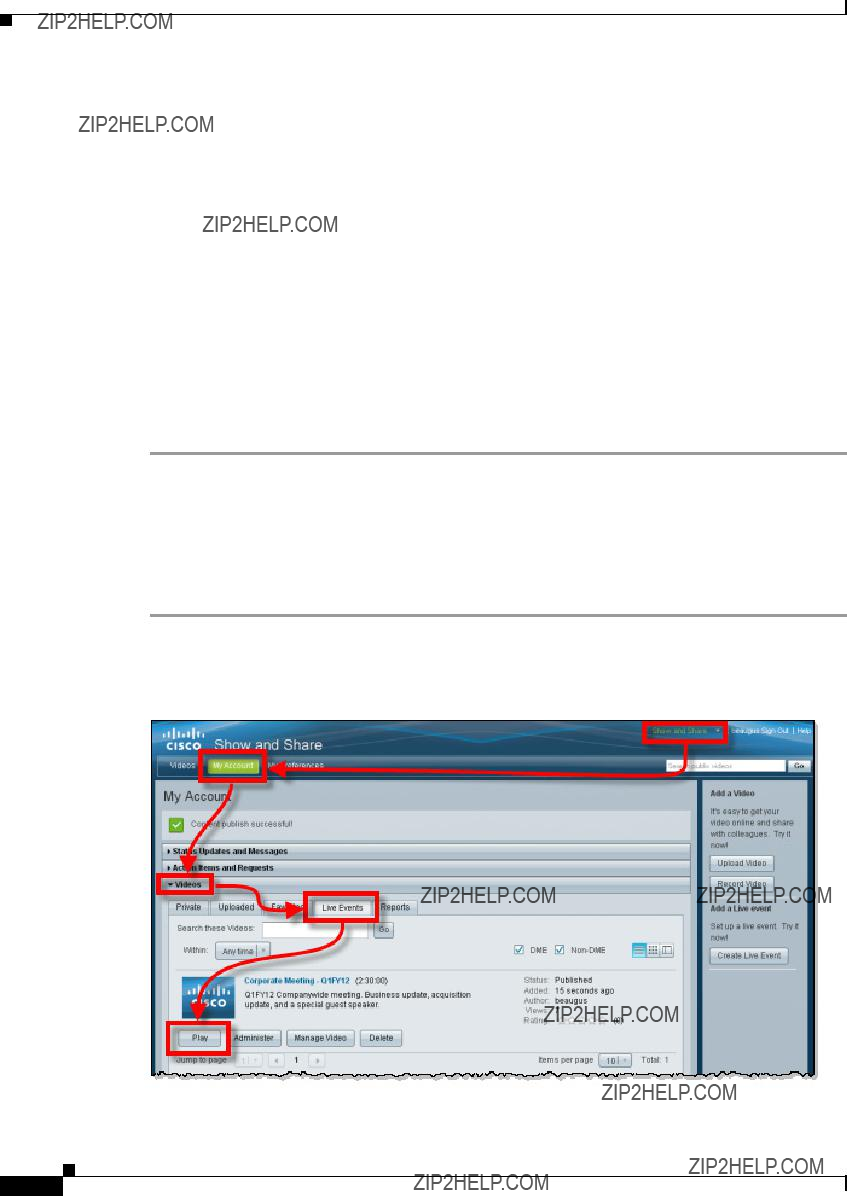
Procedures
Step 9 In the Optional Items drawer:
a.Choose whether to use the Question and Answer module during the live event.
When this module is turned On, viewers can submit questions to presenters in real time. See the ???About the
b.Choose whether to use the Polling module during the live event.
When this module is turned On, viewers can respond to predefined polling questions. The poll can include any number and combination of true/false questions and
When you write a
???Click Add more polling replies to add an answer.
???Click Add another question to expand the poll.
???Click Preview Poll to review the poll.
Step 10 Click Save as Draft.
Step 11 Stop. You have completed this procedure.
Preview a Live Event Draft
After you save a live event draft and before you publish it, you can preview it. This procedure is optional. Follow these steps:
Step 1 Choose Show and Share from the global navigation. Log in with your username and password.
Step 2 Choose My Account > Videos > Live Events.
Step 3 Choose the live event draft and click Play. The preview video window opens.
User Guide for Cisco Show and Share 5.3.x
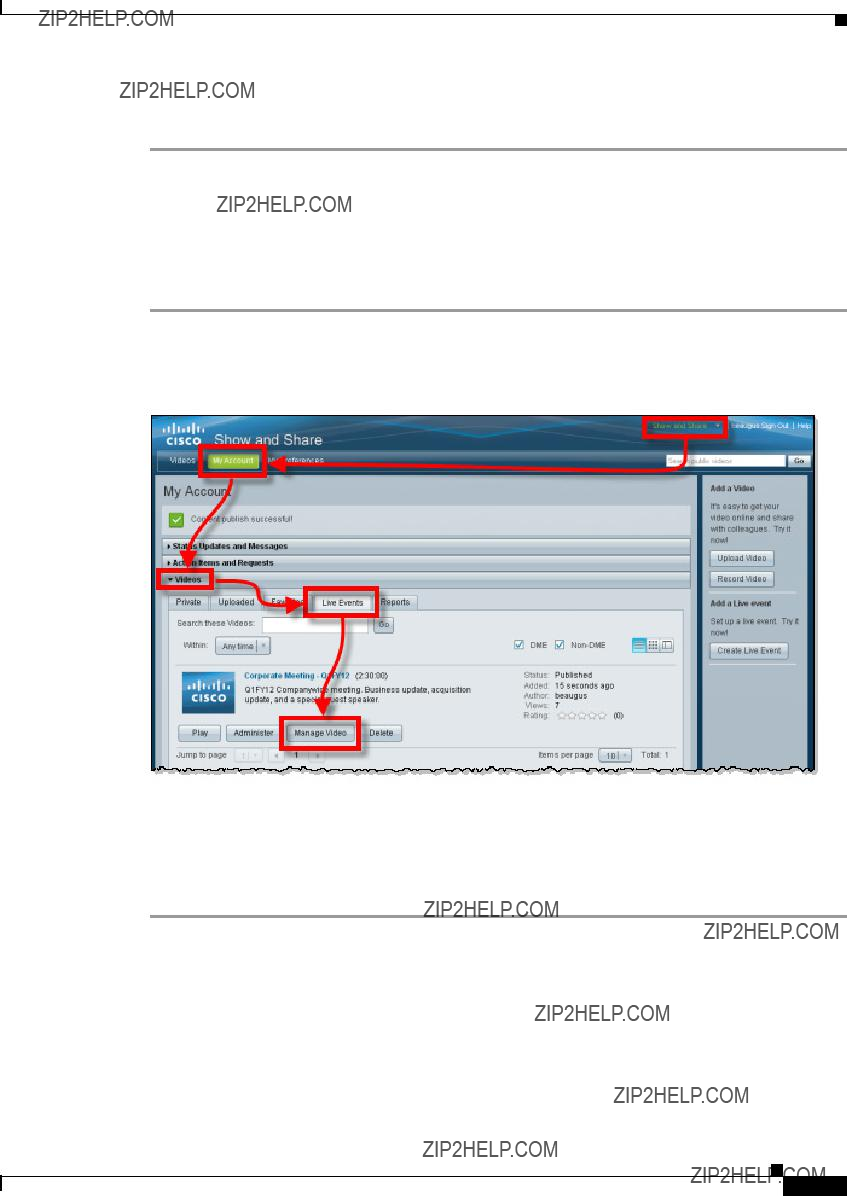
Chapter 8 Live Events
Procedures
Step 4 Click Back when you are finished.
Step 5 Stop. You have completed this procedure.
Edit a Live Event Draft
After you save a live event draft and before you publish it, you can edit the event settings. This procedure is optional. Follow these steps:
Step 1 Choose Show and Share from the global navigation. Log in with your username and password.
Step 2 Choose My Account > Videos > Live Events.
Step 3 Choose the live event draft and click Manage Video. The Edit a Live Event window opens.
Step 4 Change options, settings, and values, as needed. These are the same options, settings, and values that you entered when you created the live event draft.
Step 5 Click Save as Draft.
Step 6 Stop. You have completed this procedure.
User Guide for Cisco Show and Share 5.3.x

Procedures
Publish a Live Event Listing
You can publish a listing for the live event. Doing this helps other Cisco Show and Share community members to plan ahead. An event listing tells them:
??? What ??? You plan to host a live event
???Why ??? Its purpose
???When ??? Its start and stop times
???Who ??? The identities of the scheduled presenters and intended audience
You must create and save a live event draft before you can publish a listing for it. This procedure is required. Follow these steps:
Step 1 Choose Show and Share from the global navigation. Log in with your username and password.
Step 2 Choose My Account > Videos > Live Events.
Step 3 Choose the live event draft and click Publish. The Publish a Live Event page opens.
Step 4 Verify the values in the Live Event Summary. Click Edit to correct any values that are wrong. If you click Edit, the Publish a Live Event page closes; the Edit a Live Event page opens in its place. See the ???Edit a Live Event Draft??? section on page
Step 5 Specify the Page Permissions and Categories values:
a.User Access
???Click Allow all
???Click Allow only specific users to view this
User Guide for Cisco Show and Share 5.3.x

Chapter 8 Live Events
Procedures
b.Video Categories
???Click Do not categorize my video
???Click Categorize my
Step 6 Specify the Scheduling details:
a.Click
b.Click At a scheduled
???Enter the Date and Time values.
Step 7 Click OK to publish the listing for the live event.
Step 8 Stop. You have completed this procedure.
Send a Live Event Notification
You must create, save, and publish a live event draft before you can send a live event notification. This procedure is required. Follow these steps:
Step 1 Choose Show and Share from the global navigation. Log in with your username and password.
Step 2 Choose My Account > Videos > Live Events.
Step 3 Choose the live event that you want to advertise and click Play.
Step 4 When the selected live event page opens, copy the event URL displayed in the browser address bar. For example:
Note Do not use the
Step 5 Paste the selected live event URL in your email notification. Send the email.
If you restricted access to specific users or groups when you created the event, only the authorized users can log in and view the event.
Step 6 Stop. You have completed this procedure.
User Guide for Cisco Show and Share 5.3.x

Procedures
Start and Administer (Moderate) a Live Event
To start and administer, or moderate, a live event, you must have Live Event user privileges and be
When you are
???Viewers can watch the live event in real time through Cisco Show and Share.
???You can administer special features as the event moderator.
???Did you activate the ???Question and Answer??? feature when you prepared the live event draft? If so, viewers can submit questions for the presenters to answer. You, as the event moderator, can
???Did you activate the ???polling??? feature when you created the live event draft? If so, you can run an
???Did you activate the ???slide show??? feature when you created the live event draft? And did you upload a files or a ZIP archive that contains sequentially numbered JPEG copies of presentation slides for the live event? If so, you can sync the slide deck to the event in real time. (The slideshow feature is only supported for DME live events.)
???You can invite additional viewers after the event has started by clicking the Share tab to send a URL or an email invitation. However, only viewers that have been granted access during Publish a Live Event Listing can access the live event. See the ???Publish a Live Event Listing??? section on page
Start the Live Event
You must create, save, and publish a live event draft before you can start and administer it. This procedure is required. Follow these steps:
Step 1 Choose Show and Share from the global navigation. Log in with your username and password.
Step 2 Choose My Account > Videos > Live Events.
Step 3 Choose the live event draft, and then click Administer. The Administer a Live Event page opens.
User Guide for Cisco Show and Share 5.3.x

Chapter 8 Live Events
Procedures
Step 4 To begin broadcasting, access the Main Administrative Controls window.
a.For a DME live event:
To start the live event stream, click Encoder Start and then Broadcast Start. Viewers will see the broadcast when you click Broadcast Start. (There is an 8 to 12 second delay while the video is digitized.)
To preview the audio/video before enabling the broadcast, click Encoder Start and then Preview Start. You can adjust the input volume by using the audio slider in the Current Encoder Settings window. (The preview image updates every few seconds while in the preview mode.) When you are ready to being broadcasting, click Broadcast Start.
Note For appliances running Release 5.3.7 or later, Live Event draft preview is not supported when multiple Live Event users log in. In Release 5.3, only one person (the author) should be
b.For a
To start the live event stream, click Broadcast Start.
User Guide for Cisco Show and Share 5.3.x

Procedures
Step 5 To moderate viewer questions and comments, use the Questions tab to manage viewer submissions in real time.
a.Click icons in the Actions column, at your discretion.
???The presenter icon moves a question to the Presenter???s View tab.
???The trash icon moves a question to the Removed Questions tab.
b.Define a filter and turn it On to see only the comments and questions that meet your filtering criteria.
c.Define a filter and turn it On to automatically move
You can turn a filter Off to disable it temporarily. Or, you can clear its definition to disable it permanently.
Step 6 To conduct a poll, use the Polling tab to survey the viewers anonymously.
a.Click Open polling to start a polling cycle.
b.To show a question to the viewers for any length of time.
???Click Display question to audience when you are ready to solicit responses to a question. The viewers can choose one of the prepared responses and submit that response as their vote.
???Click Remove question from audience when you are finished with a question. The question is hidden and viewers can no longer submit a response.
???Click Display polling results to audience when you want to share the polling results with the viewers.
c.Click Close polling to stop the polling cycle.
Step 7 To manage a slide show, use the Slide Show Controller tab to select the desired slide (only DME live events).
Step 8 To stop broadcasting, access the Main Administrative Controls window.
a.For a DME live event:
Click Broadcast Stop and then Encoder Stop.
b.For a
Note It is important to Start and Stop the Encoder for each live event. Leaving the encoder running with an event configuration might cause inconsistent results if used for a different event. (Only DME live events.)
Step 9 Stop. You have completed this procedure.
User Guide for Cisco Show and Share 5.3.x

Chapter 8 Live Events
Procedures
Create a VoD From a Live Event
These are the requirements for creating a VoD after a live event broadcast:
???The event must be a DME live event.
???When creating the live event draft, the Store as file
???The Encoder must be started for the specific live event after the Store as file setting was saved (Start Encoder, Start Broadcast).
???The Encoder must be stopped when the live event is finished (Stop Broadcast, Stop Encoder). This procedure is optional. Follow these steps:
Step 1 Choose Show and Share from the global navigation. Log in with your username and password.
Step 2 Choose My Account > Videos > Live Events. A list of the live events that you administer appears.
Step 3 Select the live event for which you want to create a VoD, and then click Manage. The Edit a Live Event page opens.
Step 4 In the Live Event Basic Setup window, click Save as VoD. The file is automatically downloaded and saved in the Show and Share Videos > Uploaded tab.
Step 5 Navigate to the Uploaded tab. Select the event and click Publish.
Step 6 In the Publish Your Video window, enter the publishing information and any additional attributes. Click
Publish.
Step 7 Stop. You have completed this procedure.
Download Questions From a Live Event
You can download a list of the questions submitted by viewers during a live event. This procedure is optional. Follow these steps:
Step 1 Choose Show and Share from the global navigation. Log in with your username and password.
Step 2 Choose My Account > Videos > Live Events. A list of the live events that you administer appears.
Step 3 Select the live event for which you want to download the question list, and then click Administer. The Administer a Live Event page opens.
Step 4 Click Export Questions.
Step 5 A dialog box prompts you to specify a download location for the question file. By default, the file is named QuestionsReport.txt. (You might be able to rename the file before downloading.)
The file contains the question asked, the time it was asked, and the status of the question.
Step 6 Stop. You have completed this procedure.
User Guide for Cisco Show and Share 5.3.x

Reference
Delete a Live Event
Note Before deleting a live event, confirm that the encoder configuration related to the live event is not running: Administer > Stop Broadcast, Stop Encoder (only DME live events).
You can delete the live event file. This procedure is optional. Follow these steps:
Step 1 Choose Show and Share from the global navigation. Log in with your username and password.
Step 2 Choose My Account > Videos > Live Events. A list of the live events that you administer appears.
Step 3 Choose the live event draft, and then click Delete.
Step 4 Click the Delete button. A Warning popup window opens with the option to delete the live event file. Choose Yes to delete the file.
A system message will confirm that the deletion was successful.
Step 5 Stop. You have completed this procedure.
Reference
???Supported Dimensions for Encoded Video, page
???Supported Encoding Bit Rates for Flash Video on DMEs, page
???Supported Encoding Profiles for Windows Media on DMEs, page
Supported Dimensions for Encoded Video
These are the supported dimensions for video. All dimensions are in pixels.
???Show and Share Default 400x300
???FULL 640x480
???CIF 320x240
???QCIF 160x120
???CUSTOM
Supported Encoding Bit Rates for Flash Video on DMEs
These are the supported encoding bit rates for video. All values are in kbps.
???32
???40
???56
???64
User Guide for Cisco Show and Share 5.3.x

Chapter 8 Live Events
Reference
???80
???96
???112
???128
???160
???192
???224
???256
???288
???320
Supported Encoding Profiles for Windows Media on DMEs
Capture Profiles for Windows Media 9 Conversions
???Convert To Windows Media 9 (2M)
???Convert To Windows Media 9 (1.5M)
???Convert To Windows Media 9 (768K)
???Convert To Windows Media 9 (350K)
???Convert To Windows Media 9 (50K) for Mobile Streaming
Capture Profiles for Broadband
Film
???Video for broadband film content (1500 Kbps total)
???Video for broadband film content (768 Kbps)
NTSC
???Video for broadband NTSC (1500 Kbps total)
???Video for broadband NTSC (2 Mbps total)
???Video for broadband NTSC (256 Kbps)
???Video for broadband NTSC (384 Kbps)
???Video for broadband NTSC (768 Kbps)
???Windows Media Video 8 for Broadband (NTSC, 1400 Kbps)
???Windows Media Video 8 for Broadband (NTSC, 700 Kbps)
PAL
???Windows Media Video 8 for Broadband (PAL, 384 Kbps)
???Windows Media Video 8 for Broadband (PAL, 700 Kbps)
User Guide for Cisco Show and Share 5.3.x

Reference
Variable Bit Rate
???Windows Media 8 Best Quality based VBR for Broadband.
???Windows Media 8 Fair Quality based VBR for Broadband
???Windows Media 8 High Quality based VBR for Broadband.
Capture Profiles for Color PDAs
???Video for color PDA devices (150 Kbps)
???Video for color PDA devices (225 Kbps)
Capture Profiles for
???Video for
???Video for
???Video with audio emphasis for
???Video with voice emphasis for
???Windows Media Video 8 for
???Windows Media Video 8 for
???Windows Media Video 8 for
???Windows Media Video 8 for
???Video for
???Video for LAN, cable modem, or xDSL (100 to 768 Kbps)
???Video for
???Video for Web servers (28.8 Kbps)
???Video for Web servers (56 Kbps)
???Windows Media 9 (1.5M)
???Windows Media 9 (2M)
???Windows Media 9 (350K)
???Windows Media 9 (50K) for Mobile Streaming
???Windows Media 9 (768K)
???Windows Media Video 8 for Color Pocket PCs (150 Kbps)
???Windows Media Video 8 for Color Pocket PCs (225 Kbps)
???Windows Media Video 8 for LAN, Cable Modem, or xDSL (100 to 768 Kbps)
???Windows Media Video 8 for Local Area Network (100 Kbps)
???Windows Media Video 8 for Local Area Network (256 Kbps)
???Windows Media Video 8 for Local Area Network (384 Kbps)
???Windows Media Video 8 for Local Area Network (768 Kbps)
User Guide for Cisco Show and Share 5.3.x

Chapter 8 Live Events
Troubleshooting
Troubleshooting
In addition to these topics, also see the ???Guidelines and Limitations??? section on page
There is a delay between when I select a slide as a Live Event administrator and when it appears on the viewer???s screen
When you select a slide, the slide synchronization information is embedded in the video stream itself. There is a
There is an error message when viewers without the QuickTime plugin attempt to view a live H.264 stream
The QuickTime plugin is used to decode H.264 live event streams in Cisco Show and Share. The system administrator can enable or disable the automatic download of the QuickTime plugin. When enabled, Cisco Show and Share attempts to download the plugin if it is not installed. When disabled, browsers without the plugin will receive an error message when attempting to view a live H.264 stream.
There is an error message when viewers without the Windows media plugin attempt to view a live WMV stream
Viewers should download and install the Windows media plugin prior to accessing a WMV stream.
When administering a DME live event, the Encoder Start button does not respond
If the encoder start button does not respond, physically check that the DME is stopped. If needed, manually stop the encoder. Then click Encoder Start and Broadcast Start to begin the live broadcast. (Only DME live events.)
User Guide for Cisco Show and Share 5.3.x

Troubleshooting
User Guide for Cisco Show and Share 5.3.x

C H A P T E R 9
Use Show and Share Author Reports
Revised: November 2013
Cisco Show and Share includes reporting features that let you know if people are watching your videos and for how long.
???About Cisco Show and Share Author Reports, page
About Cisco Show and Share Author Reports
Authors can run three different reports for their videos: Page Views, Video Views, and Viewer Aggregation. Each report can be run for specific video or for all your videos. You can only view reports for videos that you uploaded, however the ???superuser??? user can view reports for any video.
To learn more about each report and what it can tell you about your video viewership, see the following topics:
???About the Page View Report, page
???About the Video View Report, page
???About the Viewer Aggregation Report, page
User Guide for Cisco Show and Share 5.3.x
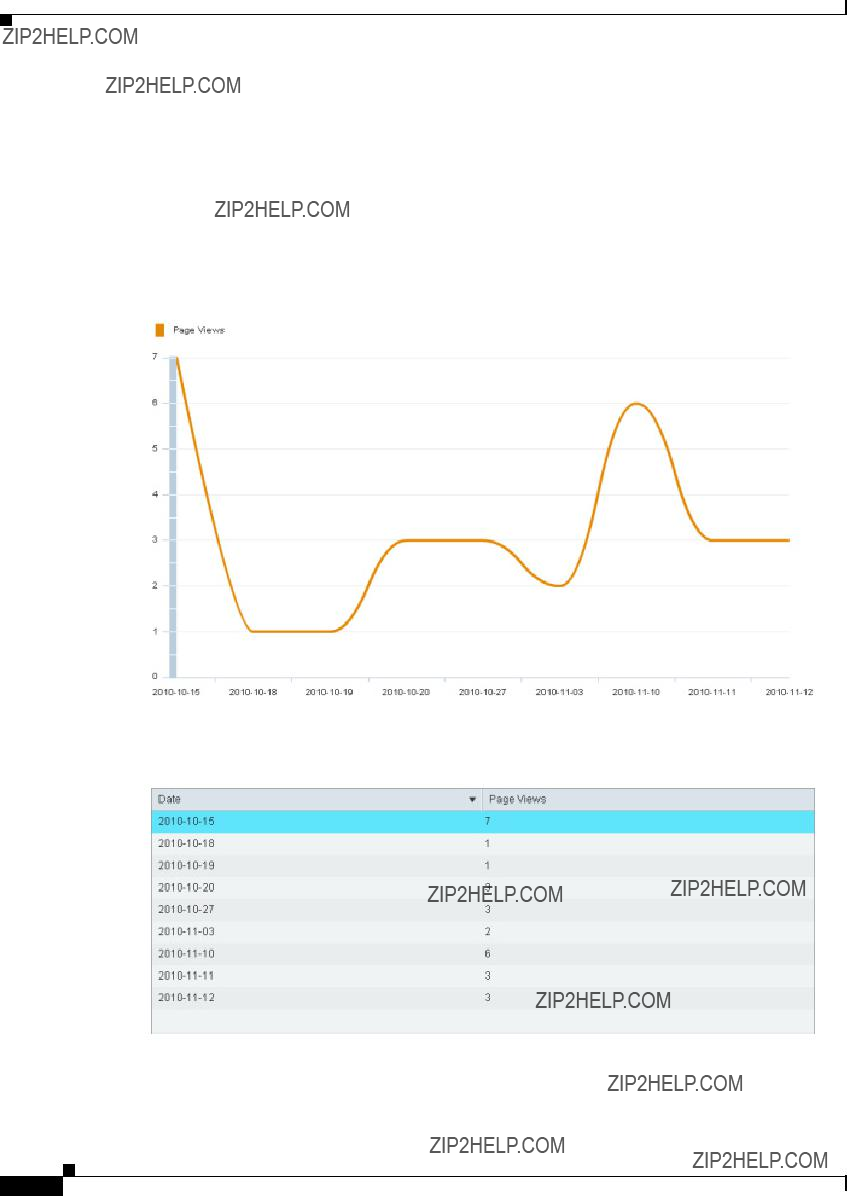
Chapter 9 Use Show and Share Author Reports
About Cisco Show and Share Author Reports
About the Page View Report
The page view report shows how many time your video pages have been accessed per day. If you do not choose a specific video, it is the total number of times all of your video pages have been accessed. If you select a specific video, it is the total number of times, per day, that the single video page has been accessed.
The report is shown as a graph and as a table of data. The data can be downloaded as a Microsoft Excel spreadsheet.
Figure
Figure
User Guide for Cisco Show and Share 5.3.x

Chapter 9 Use Show and Share Author Reports
About Cisco Show and Share Author Reports
About the Video View Report
The video view report shows how many times a video has been played. This differs from the page view report because it counts not only the number of times your video page has been accessed but also the number of times a video has been played when embedded in other web pages using the embed code.
Note If your embedded videos are not set to autoplay when the page is accessed, the number of video views reported when a page with an embedded video may be incremented
The report shows how many times the video was viewed, the average play time, and the total play time.
Figure
Figure
User Guide for Cisco Show and Share 5.3.x
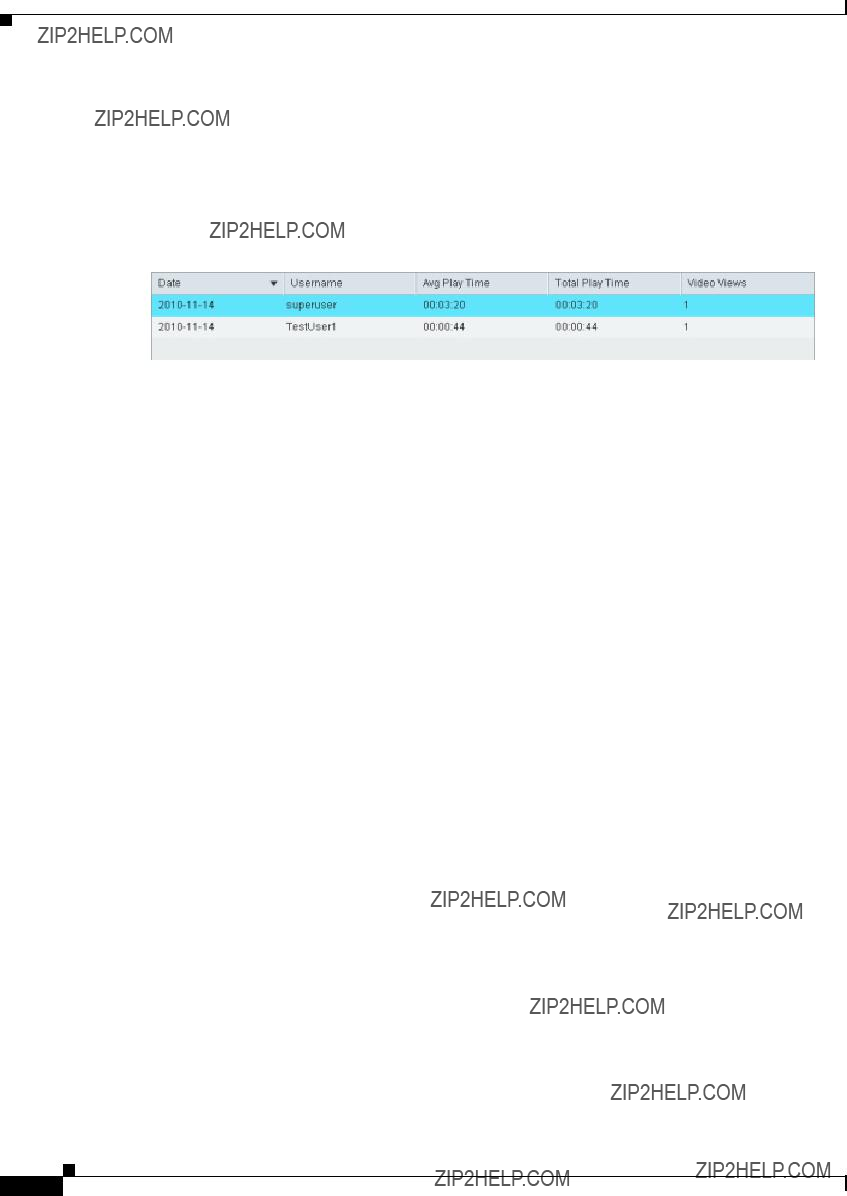
Chapter 9 Use Show and Share Author Reports
About Cisco Show and Share Author Reports
About the Viewer Aggregation Report
The viewer aggregation report shows which viewers are watching your videos and for how long. For each day that the selected video was viewed, this report shows who watched the video, how many times the viewer watched the video, the average play time for the video, and the total play time for the video.
Anonymous users and days with no video views are not shown in the report.
Figure
User Guide for Cisco Show and Share 5.3.x

Chapter 9 Use Show and Share Author Reports
Procedures
Procedures
???Export Report Data, page
Generate Reports
Before You Begin
This software uses scalable vector graphics in its charting. For browser requirements, see Release Notes for Cisco Digital Media Suite 5.2.x on Cisco.com.
Procedure
Step 1
Step 2 Choose My Account, open the Videos drawer, and then and then click the Reports tab.
Step 3 Choose the desired report from the Report by list.
Step 4 Select a date range for the report to cover by doing one of the following:
???Choose a
???Enter a specific range using the Start date and End date fields. You can type a date directly in the field in MM/DD/YYYY format or you can click the calendar button to scroll to the desired date.
Step 5 (Optional) Select a specific video to run the report on:
a.Click to expand the Select video drawer. A list of your videos appears.
b.If needed, use the Search by Title field to search for a specific title or the sort list to help navigate to the video.
c.Click the video title to select the video.
Step 6 Click the Create report button.
A graph and a table of data for your report appears at the bottom of the page.
Export Report Data
You can export your report data to an Excel spreadsheet.
Procedure
Step 1 Run your report as described in Generate Reports, page
Step 2 Click the Export to Excel button below the report data table.
Step 3 Depending upon your browser, you may be prompted to open or save the file. Follow the instructions in your browser???s dialog box.
User Guide for Cisco Show and Share 5.3.x

Chapter 9 Use Show and Share Author Reports
Procedures
Step 4 If you receive an error when opening the file that the file is not the same format as the extension indicates, click Yes to open the file. This error is harmless and your data will open normally.
Tip Hash marks (#####) in a cell indicate that the data in the cell is wider than the cell size. Simply resize the column to display the data.
User Guide for Cisco Show and Share 5.3.x